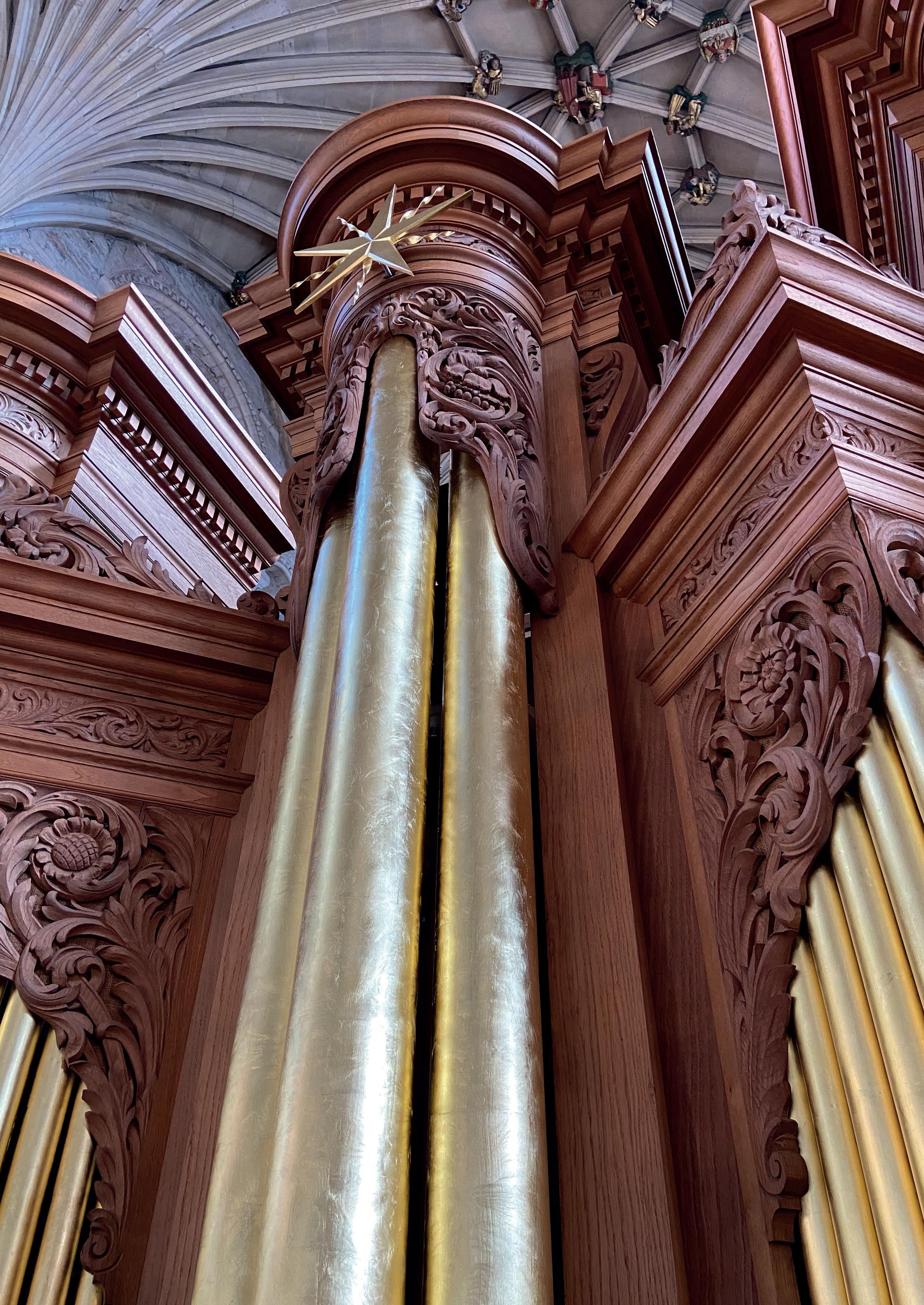






The Sibthorpe Circle brings together and recognises the support of all generous individuals who are leaving a gift to Cathedral Music Trust in their Will. The Circle is named after our Founder, Revd Ronald Sibthorp, in honour of the far-reaching impact of legacy gifts.
Cathedral Music Trust would like to acknowledge and thank the Gold and Jubilate Patrons for their generous commitment and support of its work.
JUBILATE PATRONS JUBILATE PATRONS
Richard Creed
Jonathan Macdonald

Michael Antcliff
Marcia Babington
Revd Sarah Bourne
David Bridges
Michael Cooke
Eric Merton Cox
Stephen Crookes
Robert Frier

Rodney and Clarendon
Gritten
Julian Hardwick
Edward and Rosemary
Hart
Sheila Kemp
Dr James Lancelot
Robin Lee
Jonathan Macdonald
Roddie and Kate MacLean
Tom Hoffman MBE
Iain Nisbet
Martin Owen
John Pettifer
Denis Roberts
David and Margaret Williamson
And several anonymous supporters
Julian Hardwick
Christine Kilmister
Richard Moyse
Iain Nisbet
GOLD PATRONS
Anthony Biddle
Margaret Davis OBE
Richard Gabbertas
Jason Groves
Simon Hyslop
John Meyrick-Thomas
Nicholas Parry
Professor John Penniston
Gavin Ralston
For more information about supporting Cathedral Music Trust, please contact Victoria McDougall. Thank you for your support.
Graham Robinson
Katherine Powell Rolph
Philip Shirtcliff
Joyce Smith
Dr Christopher White
Susan Williams
John Wilsher
Anne Wilson
Michael Wilson
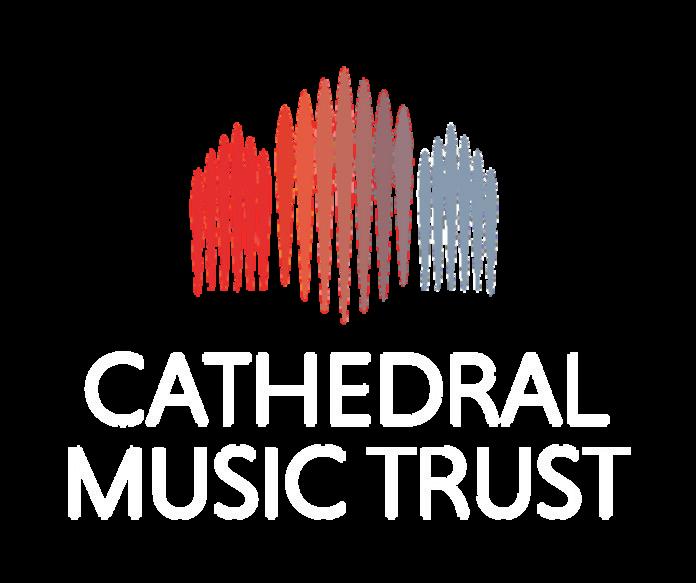

Instagram @cathedralmusictrust
YouTube CathedralMusicTrust
CATHEDRAL MUSIC MAGAZINE
Editor Adrian Horsewood editor@cathedralmusictrust.org.uk
Designer Jo Craig
Production Manager Kyri Apostolou
Cathedral Music is published for Cathedral Music Trust by Mark Allen Group twice a year, in May and November.
Spring 2024
parish church, or started playing the organ for services for a came later in life, when you entered a cathedral out of curiosity and
My introduction came in Year 9 at boarding school, when the choir director decided he could hear some potential in my audition. Having
However it happened, for most of us there will have been an initial determined that these sorts of life-changing experiences should be , which will
We also dive into the world of organ restoration in this issue, with tragedy, but both executed with the highest levels of expertise and great love and care. While the rebuild by Harrison & Harrison of the Hill, Norman and Beard organ in Norwich Cathedral took two years, put into words; similarly, the joy that will be felt in Paris when their instrument returns later this year will, I imagine, be incalculable.
Adrian HorsewoodErratum: In the review of David Baker’s Geoffrey Tristram: A Very British Organist in the Autumn 2023 issue, our reviewer wrote that the tracks on the accompanying CD were played by Ted O’Hare; in fact, they were recorded by Geoffrey Tristram himself, and were recovered by his son Michael from reel-to-reel tapes originally made in the 1970s.
The views expressed in articles are those of the contributor and do not necessarily represent any official policy of Cathedral Music Trust.
Advertisements are printed in good faith, and their inclusion does not imply endorsement by the Trust; all communications regarding advertising should be addressed to info@cathedralmusictrust.org.uk.
Every effort has been made to determine copyright on illustrations used; we apologise for any mistakes we have made. The Editor will be glad to correct any omissions.
Front cover: Local primary school children singing in Portsmouth Cathedral
(Photo: Mike Cooter)
Back cover: The Cymbelstern on the recently refurbished organ of Norwich Cathedral
(Photo: Press Association)
Editor’s photo: Andrew Wilkinson
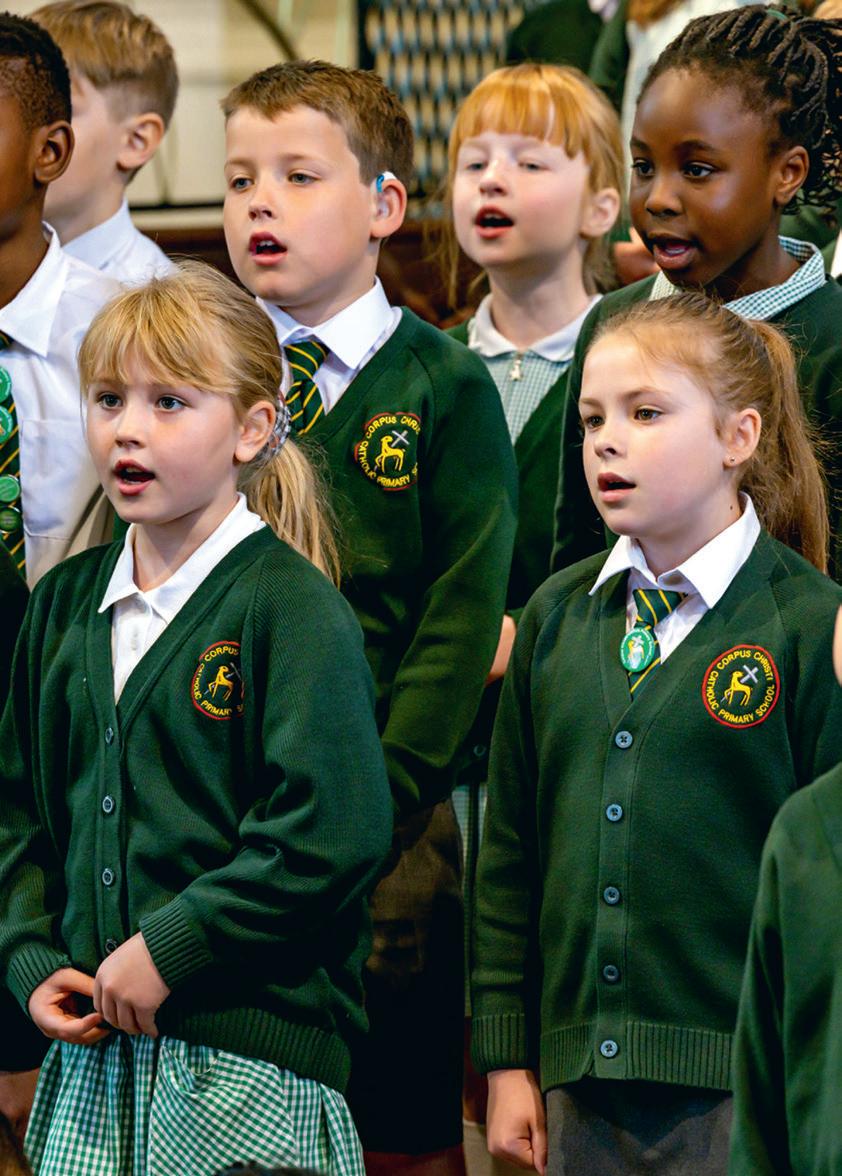
6 Securing a musical future for all
Cathedral Music Trust has launched a strategic plan that renews the focus on its mission: to support cathedral and church music in its many guises, to nurture young musicians at the various stages of their journey, and to increase the long-term stability of the cathedral music sector
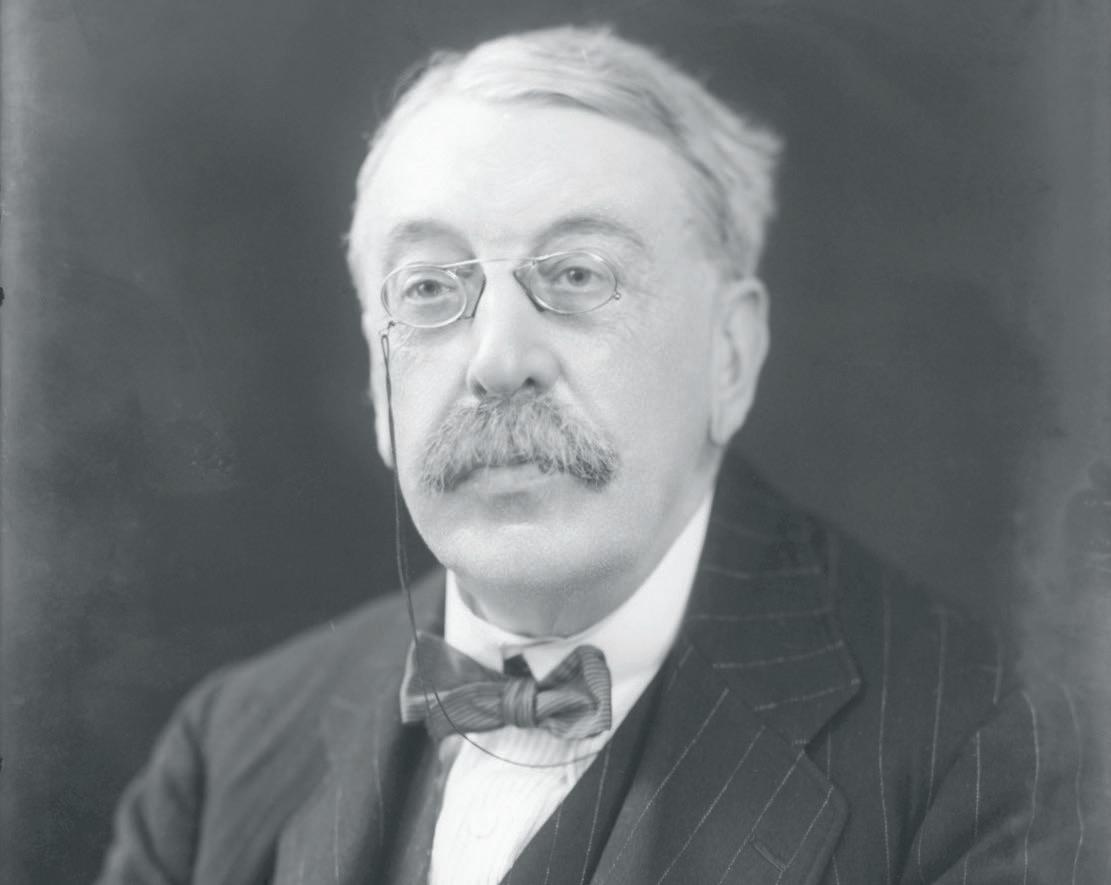
2024 marks the centenary of the death of Charles Villiers Stanford; Jeremy Dibble examines how his church music drew inspiration from other genres
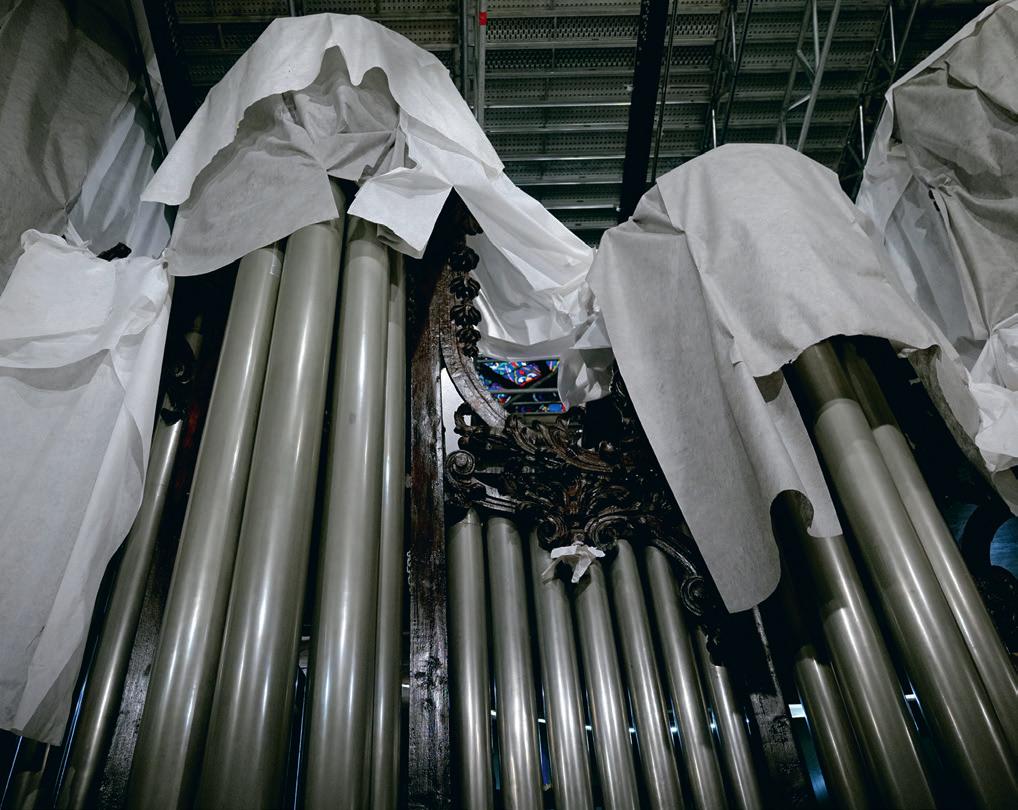
Five years on from the devestating fire, Notre-Dame de Paris is close to reopening; Pierre Dubois reports on the work to restore the historic organ
3
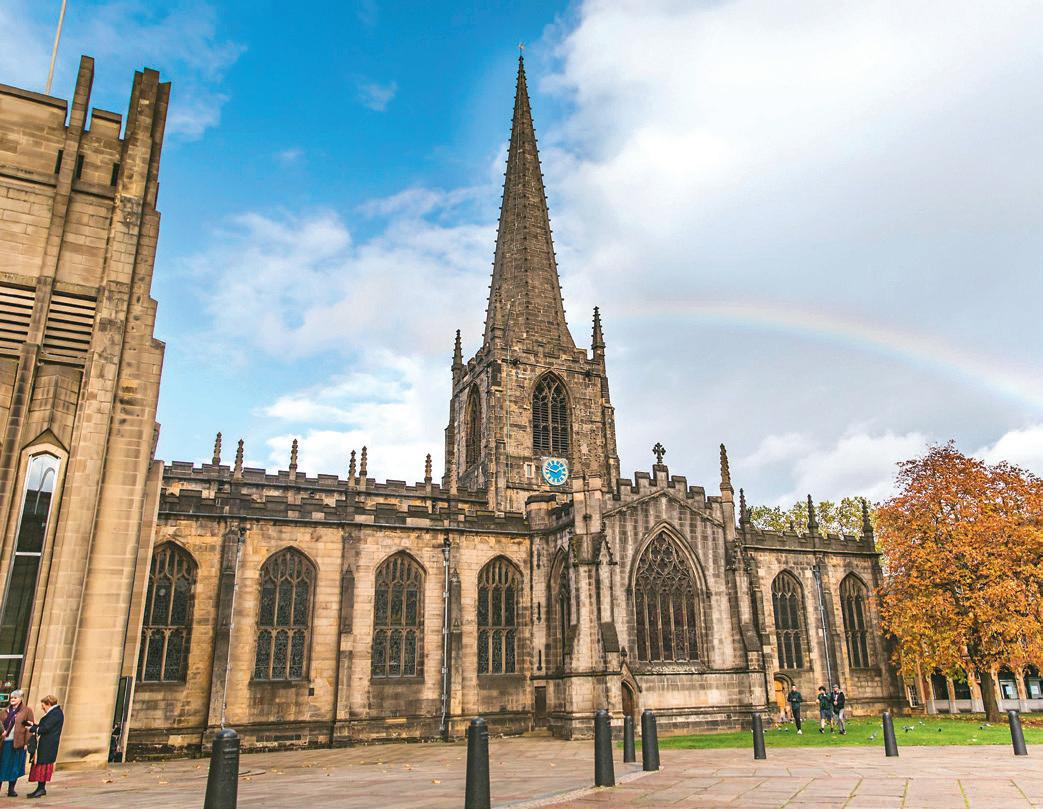
Sheffield
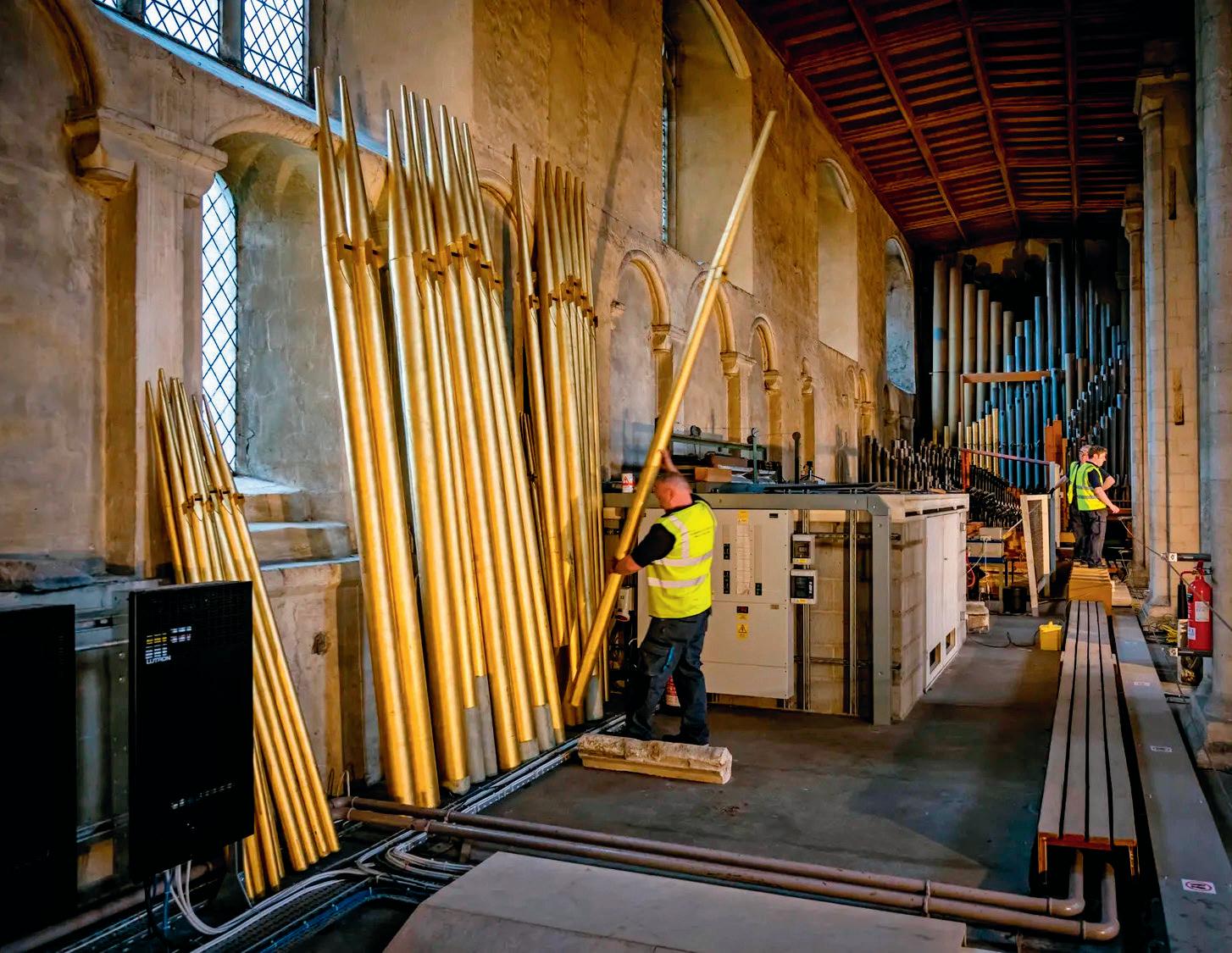
Adrian Horsewood welcomes you to this new issue
12
Catch up with the latest developments in the world of cathedral and church music
21
We offer congratulations to musicians and other figures who are on the move
23
Cathedral Music Trust organises and hosts events for enthusiasts at locations all over the country
24
Learn how cathedral and church choirs have benefited from Cathedral Music Trust’s investment
48
51
Our writers sample some of the newest choral and organ recordings, as well as recent books
66 Q&A
One of Cathedral Music Trust’s team of Future Leaders, Elizabeth Leather, recalls her musical upbringing and formative experiences, and how she sees her role in nurturing the musicians of the future 40 Finding their voice
The organ of Norwich Cathedral has recently emerged from a two-year complete rebuilding and reorganisation by Harrison & Harrison
Marcus Rock discusses his work for unaccompanied choir, Toe by Toe
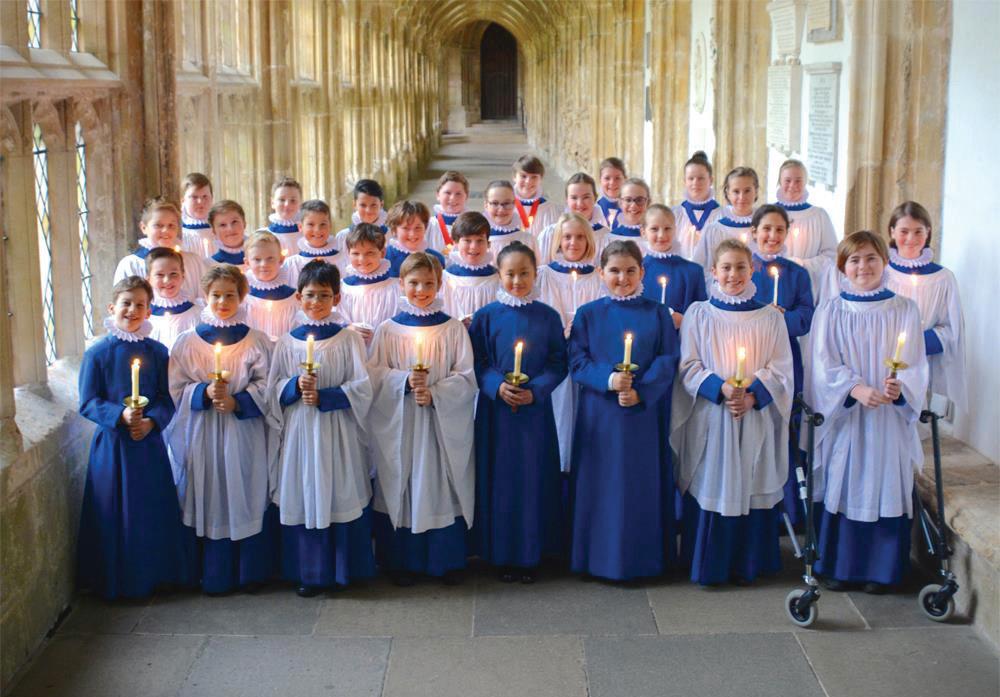
Cathedral Music Trust’s new strategic plan renews the focus on its mission: to support cathedral and church music in its many guises, to nurture young musicians at the various stages of their journey, and to increase the long-term sustainability of the cathedral music sector
By CLARE STEVENSWriting this article in the month that actor, Classic FM presenter and former cathedral chorister Alexander Armstrong undertook a Choral Adventure down the length of Britain on behalf of Cathedral Music Trust, I find it hard to believe that the Trust has existed in its present form for only four years. Since its evolution from the Friends of Cathedral Music (FCM) the Trust has established a strong new identity and become a dynamic presence in the church music scene, building on the success of previous generations who
worked so tirelessly to celebrate liturgical music and provide financial support for cathedral and collegiate music foundations. (And for some parish churches too, but more of that later.)
Cathedral Music Trust has now embarked upon implementing its five-year strategic plan for 2024–29, Transforming Lives through the Power of Cathedral Music, a blueprint for addressing the challenges that face this sector now and into the future, launched last autumn. The plan outlines the Trust’s mission to transform lives through the power of
‘For cathedral music to survive, it is vital that people from all walks of life have the opportunity to be involved’
cathedral music; its vision of a world where people from all walks of life have the opportunity to benefit from a high-quality, well-resourced and valued cathedral music scene which enriches our choral tradition for years to come; and its objectives, which are to support excellence, broaden participation and ensure the long-term sustainability of the cathedral music sector.
Asked how the strategy evolved and how it represents a difference from how FCM worked in the past, Jonathan Macdonald, who has been Chair of the Trust since February 2023, begins by paying tribute to his distinguished predecessors who have led the organisation in the past, right back to the Revd Ronald Sibthorp, Precentor of Truro Cathedral, who founded FCM in 1956.
Back then, Macdonald reminds me, ‘following the Second World War … cathedral music was in a general state of decline. In many cases choirs, and particularly choristers, had been relocated, back rows had been called away to war and had not returned or been replaced, and funding to support the rebuilding of music departments was in short supply.
‘FCM began raising money and awarding small grants, meeting regularly to celebrate and enjoy choral services in cathedrals around the UK.’
Macdonald continues, ‘While cathedral music departments began to flourish once more, the challenge of funding has never really gone away. A few years ago, seeing the opportunity to increase the impact the organisation was having, my predecessor Peter Allwood and his fellow trustees started thinking about bolstering the charity’s resources in order to reach wider audiences and grow support for its mission.’
This led to the establishment of Cathedral Music Trust. In 2019 James Mustard, the current Precentor of Exeter Cathedral, volunteered to represent the Precentors’ Conference on the board of trustees of FCM.
He recalls how, soon after he first became involved, ‘We decided to move towards becoming a Charitable Incorporated Organisation (CIO). This enabled the new organisation to implement best practice governance and take strategic decisions
much more quickly. I was part of all that process from the outset, and it has been incredibly rewarding.
‘The move to becoming a CIO coincided with the Covid-19 pandemic,’ Mustard adds, ‘and thank goodness it did, because it gave us the agility to respond to that difficult situation very rapidly.
‘I’m incredibly proud of what the Trust achieved in the pandemic, collaborating with the Ouseley Church Music Trust and the Choir Schools’ Association and succeeding in getting the £1m we raised to be matched by the Church Commissioners.’
Jonathan Macdonald also feels that the pandemic was a catalyst for much-needed change. ‘It accelerated discussions that were already taking place around the squeeze in funding faced by many cathedral music departments,’ he says, ‘and increased our conviction of the need to broaden our approach. We started by employing a team of experienced staff, creating an engaging website and new branding, and raising public awareness through social media campaigns.’
The next step was to commission two major pieces of research from More Partnership, a leading UK arts consultancy. ‘We asked More to conduct a review into the key issues facing cathedral music in the UK and to recommend how the Trust should focus its work to help address them,’ explains Macdonald.
‘We initially held a workshop at Southwark Cathedral with key stakeholders from across the sector, including members of the clergy, directors of music, cathedral administrators and education leaders. As the project developed over a period of nine months, more than a hundred individuals from across the country were interviewed. The final report, A Future for Cathedral Music, was published in September 2022.’
The More Partnership research identified three central elements that are important individually and together form a powerful set of interlinked factors that need to be balanced to secure the tradition of cathedral music: Excellence, Participation and Sustainability. These three topics form the key pillars of the Trust’s new five-year strategy.
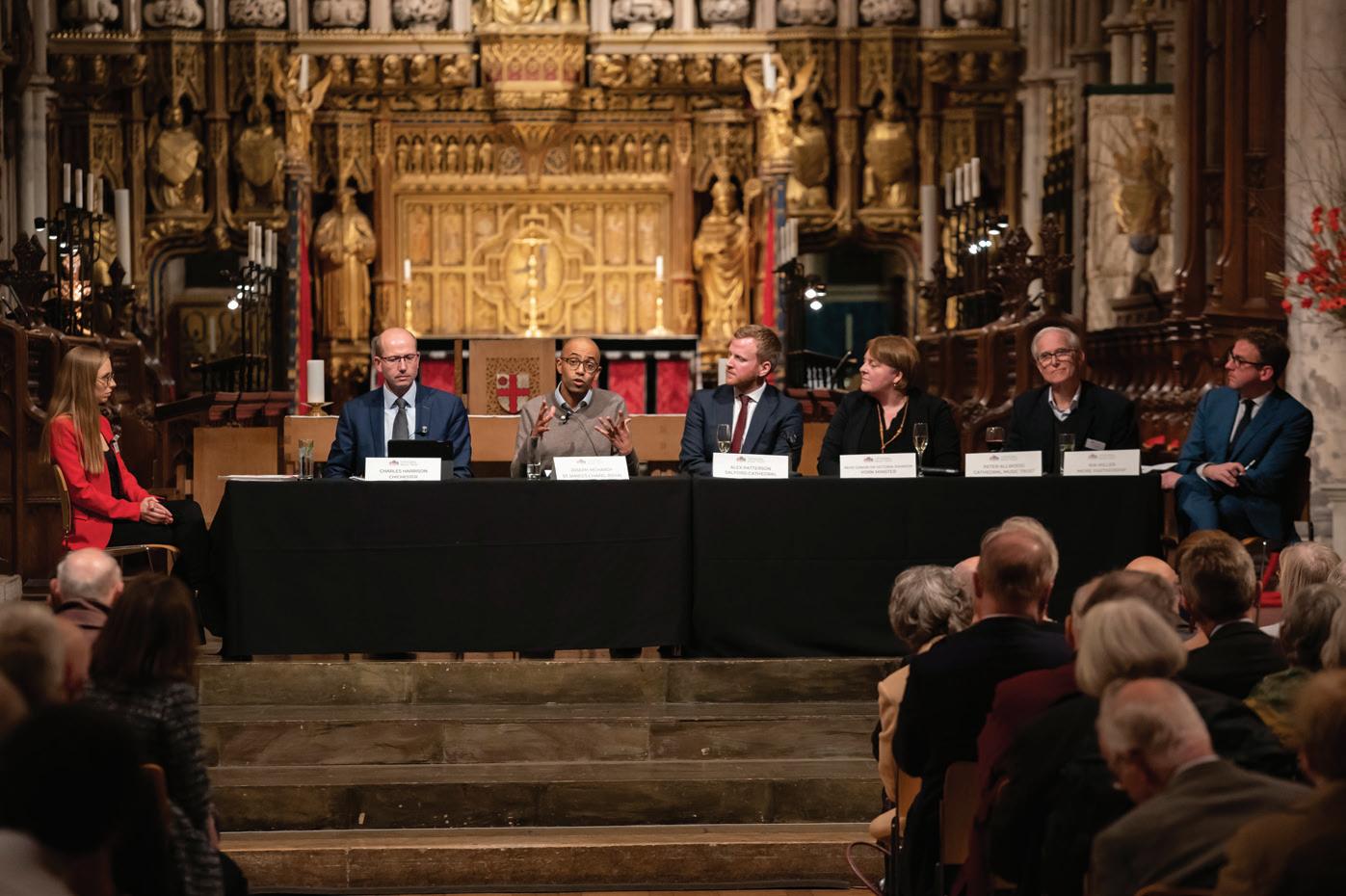
The first pillar, Macdonald explains, focuses on the need to support excellence. ‘We recognise and champion the many strands of excellence that are woven into the fabric of cathedral music departments across the length and breadth of the country.
‘This isn’t just about world-class singing or organ playing. It’s also about ensuring the availability of high-quality training for children and young people, inspiring community engagement programmes, inclusive recruitment practices and protecting the welfare of cathedral musicians and staff.’
The second pillar is focused on broadening participation. ‘For cathedral music to survive, it is vital that people from all walks of life have the opportunity to be involved. Our job is to help choral foundations expand pathways that make it easier for young people to take part. An important part of this is raising awareness of the joy and lifeenhancing benefits that cathedral music can bring to people from all walks of life.
‘And finally the third pillar addresses the need to promote the sustainability of cathedral music. Here we are not just referring to financial sustainability but also ensuring a healthy pipeline of young talent, the flow of which is under significant threat due to the uneven state of music education in our country.
‘While Cathedral Music Trust will continue to offer meaningful financial support, it is essential that we help to address the underlying problem of underfunding, rather than just provide an annual sticking plaster. This means promoting activities that are
‘Our job is to help choral foundations expand pathways that make it easier for young people to take part’
likely to attract more funding over time through increased community awareness and engagement.
‘We are also playing our part in lobbying policy-makers and education leaders to place greater stress on the importance of a basic music education.’
Cathedral Music Trust’s Programmes Director Cathryn Dew is leading the charity’s work on education and participation, in particular the Early Years programme which is set to launch this year. ‘The pandemic highlighted that children were getting less early experience of music, and we want to try and address that,’ she says. ‘Research suggests that music-making and creativity in the early years is fundamental to children’s personal, social and creative development, and so by working with young children and their families, empowering their families to continue making music at home, and experiencing what music in a cathedral can be like, we’re sowing seeds for the future. Whether those seeds blossom into choristerships, or whether they take the children in completely different directions is almost less important than that the seeds are there and that the children begin to develop creatively. We’ve really begun to appreciate the need for and the value of that.’
James Mustard concurs: ‘I’m about to be fifty, and my way into music was that I had a recorder put into my hand; it cost about fifty pence but it was an absolutely invaluable way [to start learning]. That’s not happening now. Music might technically remain a statutory part of the National Curriculum but it’s been very much downgraded in terms of priority
and that’s a massive challenge for cathedrals. Some are really trying to tackle the problem … Southwell Minster, for example, with its crèches, and Sheffield … here in Exeter, we have a Saturday morning children’s choir that helps to provide our pipeline.’
At the other end of the chorister journey, the gap in provision for ‘retired’ choristers of many cathedrals was highlighted by the research.
‘We sometimes lose touch with our ex-choristers because there isn’t an offer for them,’ says Dew. ‘But this is beginning to change, and we want to do what we can to help, because it is important. Where do the future back rows and choral scholars come from?
‘We want to address the issues around what happens to choristers when they finish, but also to engage teenagers who might not have had the opportunity to sing as choristers but have an enthusiasm for the music – or don’t even know they have an enthusiasm for the music yet, but would do if they knew it – and give them a chance to develop the skills that they need, so that they might be in a position to audition for choral scholarships or to sing for the rest of their lives.
‘We need to be careful not to exclude sopranos in that; the focus tends to be on altos, tenors and basses, but a few cathedrals
are looking at developing soprano choral scholars as well, and I think that’s a move we want to help support. We’re right at the beginning and we’ve got lots of ideas that need to be formulated.’
A recent recruit to the board of Cathedral Music Trust is Simon Toyne, Executive Director of Music for the David Ross Education Trust, where his role has involved developing a music programme for over 14,500 children in thirty-four state schools in the East Midlands. An experienced choir director and parish church organist who was himself a chorister at Exeter Cathedral, he is well placed to help Cathedral Music Trust implement the new strategy.
He speaks passionately about the contrast in public appreciation of excellence in sport compared to church music: ‘We are sitting here on a remarkable, unique living heritage – that touches lives profoundly, that involves children and young people as active participants – but I don’t think the country at large understands it, or is even aware of it. There’s a really interesting set of statistics about the number of hours a chorister will devote to their education – and they do become world-class – and it’s roughly the same as the training of a young footballer. We need to value choristership in the same way, as a badge of honour for schools and communities.
BELOW Schoolchildren take part in Cathedral Sing, one of Portsmouth Cathedral’s education and outreach projects
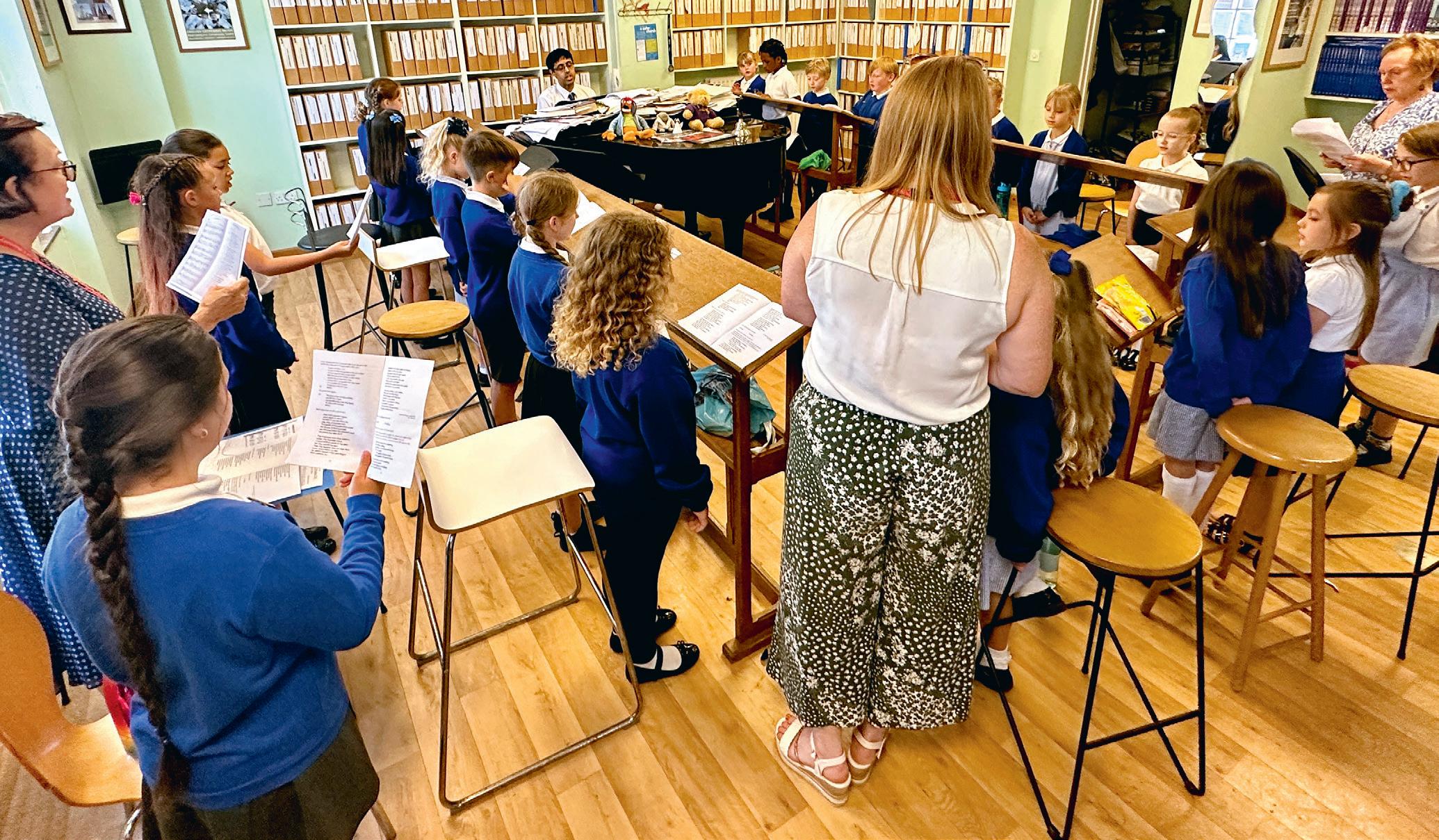
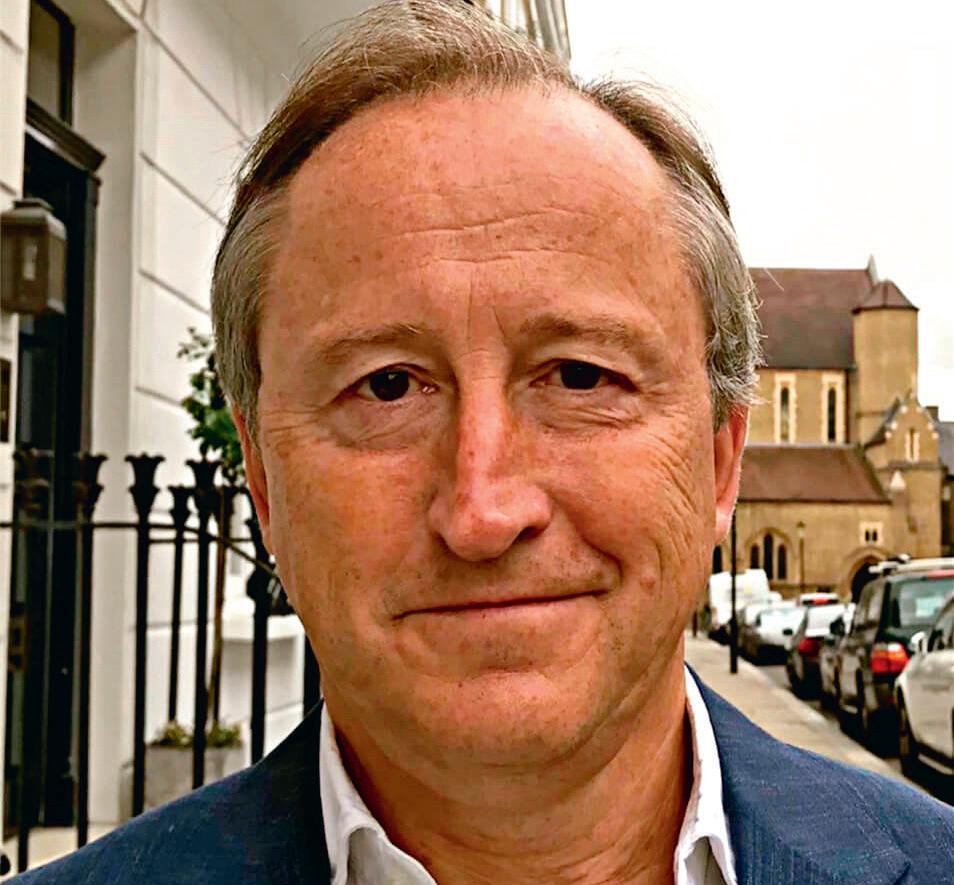

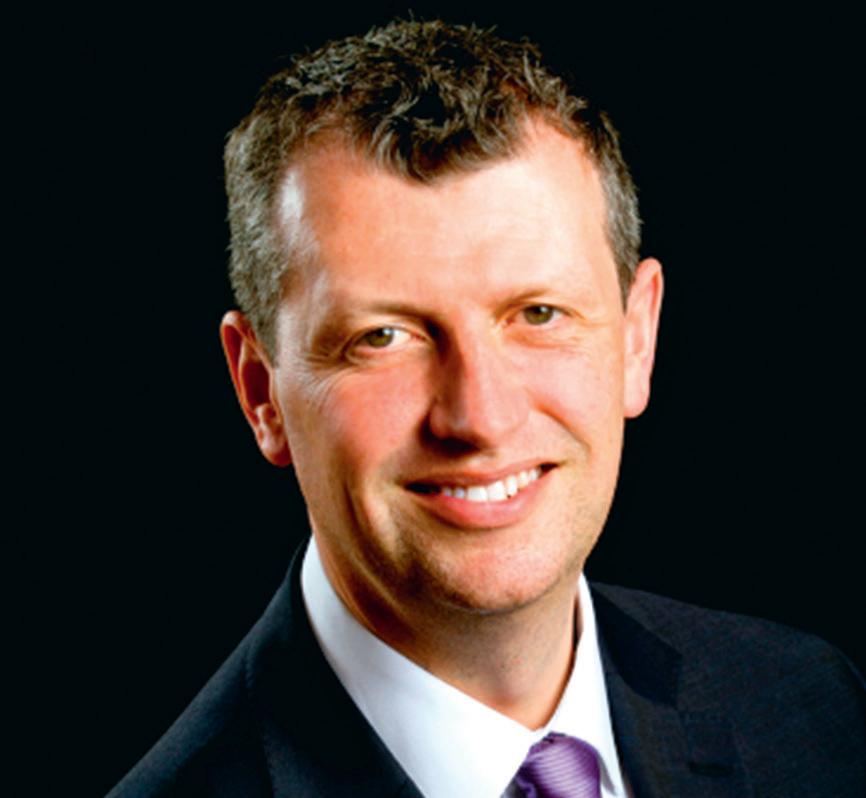
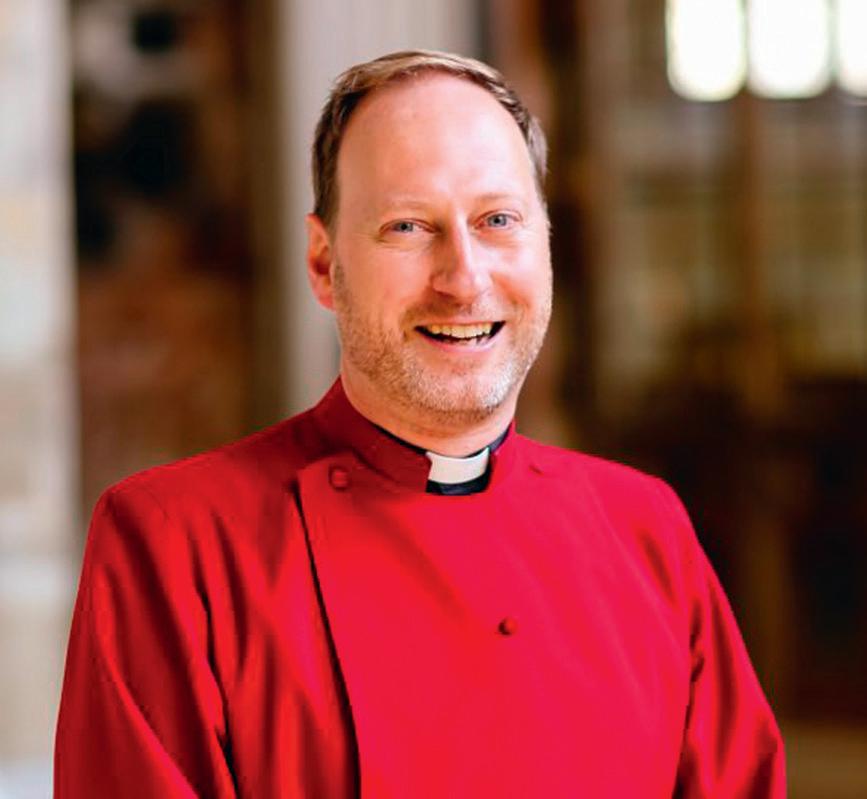
‘I think it’s great that there is now a coherent strategy from Cathedral Music Trust, setting out what this remarkable tradition can give not just to the children and young people who are involved, but to society at large.
‘It gives a very clear sense of direction, and of the kind of imaginative, joined-up thinking that we need this sector to bring to the table, so that cathedral music has the same sort of powerful voice as, say, the national portfolio organisations, the youth music organisations, the music hubs and everyone else in the musical world.’
One of the most important aspects of the strategy is supporting the adult workforce of cathedral music foundations, through enhanced training for younger organists and conductors and through assistance with the administrative tasks that take up so much of a director of music’s time.
‘We know that fundamentally it is very simple: where there’s a very good musician, who cares about their art-form and about education, and they are empowered to educate, you get outstanding results,’ says Toyne.
‘There needs to be a cherishing of all who are in this workforce, including parish churches and schools, where so many profound, pivotal, life-changing moments can happen.
‘But we also need to make that a more viable career prospect and to be looking at what the landscape is. Thirty, forty, or fifty years ago it would have been normal for the director of music at a parish church to be director of music at their local school.
Stephen Cleobury and Michael Nicholas, for example, started their careers as directors of music at both St Matthew’s, Northampton and Northampton Grammar School.
‘That has grown to be less common, but that connection between schools and churches or cathedrals is starting to come back, for example with the National Schools Singing Programme and the really imaginative partnerships between cathedrals and schools that have been developed.
‘If you can expand a cathedral music department to recruit really good choral practitioners who are working in schools, you can build a choral foundation that is properly connected to its local community. The result is powerful.
‘We actively need to develop the workforce and it should be a no-brainer that the more young people are engaged in cathedral music, the more opportunities there will be to find
‘Cathedral music provides not only a transformative education for children and young adults but also joy, comfort and wellbeing to countless people, whether they have faith or not’
and train the leaders of the future. There will be a wider talent pool to develop the next generation of the workforce – it’s really simple.’
From the perspective of a residentiary canon, James Mustard also welcomes the focus on professional development.
‘I am very mindful that current assistant directors of music – and to some extent organ scholars – are the directors of music of the future. In the past their training would have been essentially an apprenticeship, learning on the job alongside more experienced organists, which was great if the director of music was someone like Roy Massey, who could inspire and develop protégés such as Timothy Noon, our Director of Music here at Exeter.
‘Perhaps more significantly’, he adds, ‘the terrain of music-making has changed immensely over the last twenty to thirty years, not least with regard to safeguarding, but also with regard to inclusion, in terms of how children’s voices are understood and what is appropriate in terms of training them … So we felt that assistance with training would be very valuable.
‘Our Future Leaders programme will help with all of this, ensuring that younger musicians themselves will have input into how we shape our plans. I’m also aware that the job of running a cathedral music department is vast, and the administrative support directors need is huge, so we aim to help with that too.’
An issue that keeps recurring in our conversations is the enormous variation in the financial circumstances of different foundations and in almost every aspect of how they operate. That is one reason why Cathedral Music Trust aims to use the expertise and availability of its staff as well as its trustees to get to know individual musicians, clergy and administrators better, to walk alongside them and to offer financial support in a more meaningful way.
‘We’re very aware that no two cathedrals are the same, and it’s not for us to tell anyone how to run their cathedral; we’re saying that we’d like to be able to resource them in order
to help them to bring the widest possible number of people in as participants and provide the widest level of professional support in that context.’
The idea of partnership underlies much of the strategy, says Jonathan Macdonald, citing as an example the Trust’s Church Choir Award, which was set up in partnership with the Royal School of Church Music and is now in its third year. Choirs which do not usually qualify for the Trust’s main grant programme may apply for up to £10,000 to fund an innovative or enriching project. ‘We also want to highlight the importance of music-making in parish churches across the country which forms an integral part of our nation’s church music scene.’
Macdonald says that the response to the publication of the strategy has been extremely positive. ‘We have been delighted with the support and buy-in received for our plan from across the sector. To ensure its success our intention is to work ever more closely with cathedral music departments across the UK and Ireland and assist them in whatever way we can to ensure a bright future.
‘We know we can’t fix the problem of underfunding in the sector overnight – or alone – but I am confident this new approach will help us to build the Trust’s financial resources while also broadening and deepening awareness of our mission.’
In conclusion, Macdonald reflects that ‘Cathedral music provides not only a transformative education for children and young adults but also joy, comfort and wellbeing to countless people, whether they have faith or not. The more people that understand this and want to become involved, the more this wonderful living heritage can develop, flourish and be preserved for the benefit of future generations.’
You can read a summary of Cathedral Music Trust’s five-year strategy, a summary of the More Partnership report and its literature review at www.cathedralmusictrust.org.uk/ publications.
At Cathedral Music Trust we believe that every child should experience the life-transforming benefits of learning to sing.
Our 2024 Small Sounds programme will establish weekly music groups in cathedrals for over 1,500 early years children and their families across the UK, helping them to live happier and healthier lives.
Many children experience barriers accessing music from a young age, provision which has been proven to support personal, musical and social development.
Since the Covid-19 pandemic, music provision for very young children has drastically reduced, exacerbated by closures of early years settings and financial barriers facing families. Less than 9% of cathedrals, which are the UK’s centres of choral excellence, offer early years provision.
‘This is a superb opportunity to really grow excellence in singing from an early age,’ said Alexander Binns, Director of Music at Derby
Cathedral, ‘and to build relationships with families so they feel comfortable engaging with music, and feel at home in the cathedral space.’
Weekly cathedral-based music groups will provide high-quality musical experiences and enhance children’s confidence, well-being and personal development – and help them become ready for school. We will equip cathedral music departments and train their musicians to deliver this work on an ongoing basis, enriching lives for years to come.
Cathedral Music Trust’s Director of Programmes, Cathryn Dew, points out that, ‘Making music from
‘Making music from a very young age sets children on a lifelong musical journey’
a very young age helps children meet developmental milestones and sets them on a lifelong musical journey, giving them the skills they need to join a choir. We want to help more children discover the joy of singing!’
Small Sounds was launched in March with an initial funding campaign that saw over £6,600 donated by Trust supporters and members of the public; the Big Give then contributed £5,000 of matched funding. But this is only the beginning of a long-term project.
‘I owe my entire career to my early cathedral music education,’ says Alexander Armstrong, Cathedral Music Trust Ambassador. ‘I urge you to support the Small Sounds project so that more children can be given the lifechanging opportunities that singing offers, now and for years to come.’
For more information about the Small Sounds project, visit the Cathedral Music Trust website at www.cathedralmusictrust.org.uk


One of the country’s leading music educators and choral conductors, Simon Toyne, has joined Cathedral Music Trust’s board of trustees. He received his musical training as a chorister in Exeter Cathedral Choir, later becoming Organ Scholar of University College, Oxford. Simon was Director of the Tiffin Boys’ Choir for twenty-four years, overseeing over 270 Royal Opera House performances and collaborations with the world’s leading conductors. Since 2012, he has been a Director of the Rodolfus Choral Courses.
Simultaneously serving as Director of Music at All Saints’ Church, Kingston, and Assistant Head & Director of Music at Tiffin School, Simon led choir broadcasts on BBC1, Radio 4, and World Service Radio, with over twenty choristers achieving scholarships to Oxford and Cambridge.
Since 2015, as Executive Director of Music at the David Ross Education Trust (DRET), Simon has developed a music programme for over 14,500 children in thirty-four East Midlands state primary and secondary schools. Notable achievements at DRET include the award-winning Singing Schools programme, trust-wide music curriculum development, and partnerships with leading organisations including Gabrieli Roar and the Royal Opera House.
Contributing to the National Plan for Music Education and Model Music Curriculum, Simon served on the Department for Education’s Expert Panels and is currently a member of the Monitoring Board for the National Plan. His chapter on curriculum music in What Should Schools Teach? (2021) is available from UCL Press. Founder President of the Music Teachers Association, Simon also serves as the Music Director of the Northampton Bach Choir.
Simon commented: ‘I am proud to be joining Cathedral Music Trust at an exciting stage in its journey. The UK’s remarkably rich choral and organ music tradition is constantly renewed through the profound contribution of children and young people as active participants. I am looking forward to contributing to the Trust’s vital work in developing an even deeper and wider access to this unique tradition, and in helping to shape a vastly more equal musical culture of the future.’
Jonathan Macdonald, Chair of Trustees, added: ‘We are delighted to welcome Simon Toyne as a trustee. He brings a wealth of experience across both the music and education sectors, alongside a lifelong passion for choral and organ music. Simon joins the Trust at a crucial stage in its development, as we work towards our mission of transforming more lives through cathedral music.’
Anna Lapwood, Director of Music at Pembroke College, Cambridge and a Cathedral Music Trust Ambassador, has been appointed MBE for services to music. Remarking on the honour, she said, ‘This honour has inspired me to keep pushing for the causes close to my heart. Everyone should have the option to pursue a career in music: nobody should feel they aren’t welcome in our industry because of who they are. Fighting for this is rarely easy, but the joy of seeing people unlock their potential makes it all worthwhile.’
Edward Higginbottom has been awarded the Choral Director’s Lifetime Achievement Award by the Musicians’ Company in recognition of thirty-five years as Director of Music, fellow and tutor at New College, Oxford. Previous recipients include Stephen Cleobury, Harry Christophers, Christopher Robinson, Andrew Carwood and James O’Donnell.
Roy Massey, one of the twentieth century’s most influential organists and choir trainers, turns ninety on 9 May this year. As Organist and Master of the Choristers at Hereford Cathedral between 1974 and 2001, he oversaw nine seasons of the Three Choirs Festival and helped to shape the musical lives and careers of generations of singers and organists. Massey was awarded the Lambeth degree of Doctor of Music (DMus) in 1990 and appointed MBE in 1997; following his retirement from Hereford, he served as President of the Royal College of Organists from 2003 to 2005.
The Royal College of Organists (RCO) has launched The Organ Podcast, a fortnightly show designed to inform and entertain organists and organ enthusiasts alike, including those who are simply curious and want to know more about this unique instrument and its music. Episodes will feature interviews with leading UK and international organists, visit historic or littleknown organs of interest, catch-up with organ rebuilds and restorations, and encounter a diverse mix of individual organ-related news from around the UK. Host Mark O’Brien is both an organist and an awardwinning former BBC radio and televsion producer. He said: ‘The aim is to make a show which is friendly, informal and entertaining, but at the same time as being an intelligent and authoritative guide to the whole world of the organ. In that spirit we will be covering all manner of organ-related activities and cultural aspects, exploring performance, organ design and history, the instrument’s many secular as well as liturgical uses, different approaches to educational and outreach work, the organ’s links with choral traditions, as well as the insights, experiences and stories of organists around the world.’
The Organ Podcast is available free of charge from Apple, Spotify, Google, Amazon, Buzzsprout and all popular podcast directories; it is also available to hear via the RCO’s YouTube page, and the RCO content platform iRCO (with either a member or free guest account).
The British composer, conductor and producer James Whitbourn has died at the age of 60, following a cancer diagnosis. A graduate of Magdalen College, Oxford, his career in music began in the BBC, for whom he worked as a composer, conductor, producer and presenter; from 1990 to 2001 he served as Editor of BBC Radio 3’s weekly Choral Evensong series. He had a close association with the choir of King’s College, Cambridge, having produced the BBC television broadcasts of Carols from King’s for more than thirty years. He also worked for many years as the Executive Producer for the Royal Opera House’s Opus Arte label. As a composer Whitbourn focused on choral writing, often in combination with instrumental or orchestral forces. His most popular works included his portrait of Anne Frank, Annelies; the multi-media choral work Luminosity; and the Son of God Mass, a work for saxophone and choir. Recent works included Arise, my love, Christmas Welcome, O magnum mysterium, Shchedryk, Solitude and Our Gold, all published in Oxford University Press’s Carols for Choirs 6. He received four Grammy nominations and one Gramophone nomination.
Whitbourn’s orchestral catalogue includes the award-winning work Pika, based on the bombing of Hiroshima, one of three large-scale compositions for symphony orchestra written with the poet Michael Symmons Roberts and performed by the BBC Philharmonic, who also recorded many of his television scores.
His commissions included the music to mark several national and international events, such as the BBC’s title music for the funeral of Queen Elizabeth the Queen Mother in 2002 and music for the commemoration of 9/11 at Westminster Abbey in 2001 (subsequently performed in New York on the first anniversary of the attacks). He also composed music for the BBC’s coverage in 2004 of the sixtieth anniversary of D-Day. Whitbourn was Fellow and Director of Music at St Edmund Hall, Oxford; Senior Research Fellow at St Stephen’s House, Oxford; Director of Music at Harris Manchester College, Oxford; and a member of the Faculty of Music in the University of Oxford. He held long-standing associations with the University of Cambridge and with Westminster Choir College of Rider University in Princeton, USA.

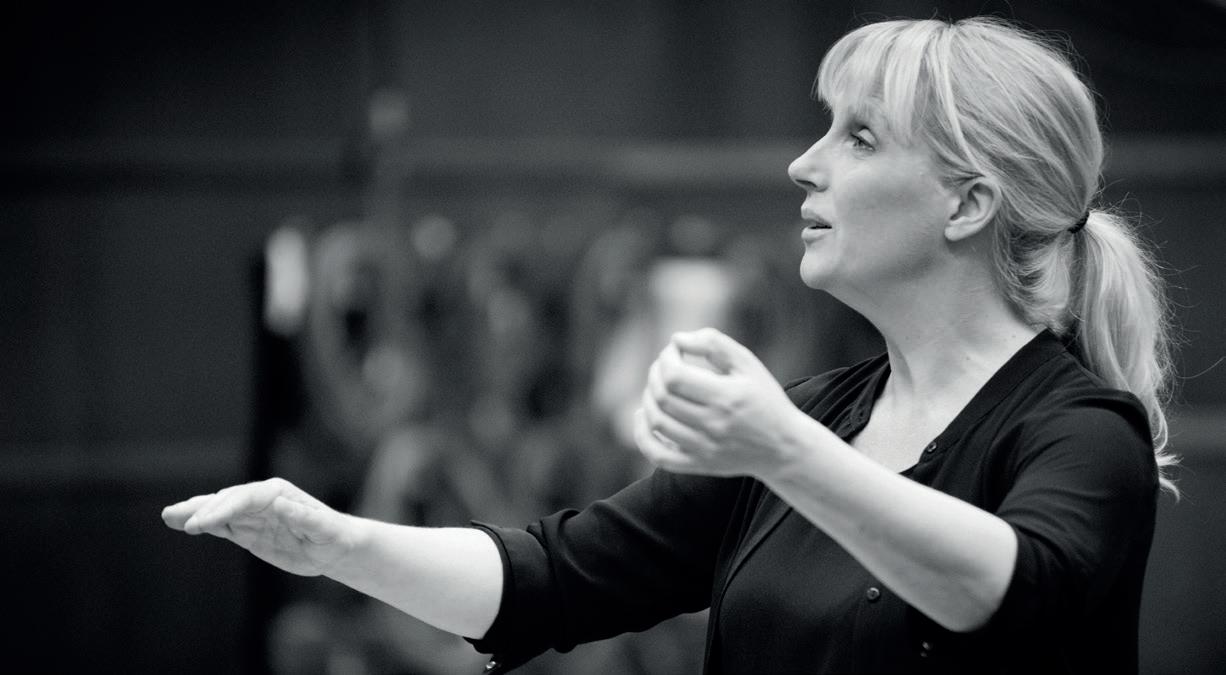
This year, the Royal College of Organists honours five distinguished musicians for their achievements in organ and choral music with the award of the Medal of the Royal College of Organists (‘The RCO Medal’): Professor Graham Barber, ‘in recognition of distinguished achievement in organ performance, pedagogy and scholarship’; Dominic Gwynn, ‘in recognition of distinguished achievement in organ building and scholarship, in particular with respect to UK organ heritage’; Sofi Jeannin, ‘in recognition of distinguished achievement in choral directing’; Dr Stephen Layton MBE, ‘in recognition of
Former Sub-Dean of Westminster Abbey, Canon David Hutt, has presented a bronze maquette of Benjamin Britten to the Abbey Choir School, to celebrate his eighty-fifth birthday. The eighteen-inch tall sculpture, by Ian Rank-Broadley, is one of a limited edition (based on the full-sized statue that will be erected in Britten’s boyhood home town of Lowestoft) and shows the composer as a young boy of around fourteen.
distinguished achievement in choral directing’; and Dr David Ponsford, ‘in recognition of distinguished achievement in organ performance and scholarship’.
President of the RCO, David Hill says: ‘The 2024 honorands are both respected and celebrated in their respective fields. The RCO Medal acknowledges their many achievements, and we warmly congratulate them and thank them for their immense contribution to choral and organ music.’ Four of the recipients were presented with their medals at Southwark Cathedral in March; Sofi Jeannin will be awarded her medal at the 2025 ceremony.
Cathedral Music Trust has announced a new cohort of Future Leaders, who will work to shape the future of cathedral music in the UK and beyond: James Bartlett, Nicholas Bown, Isobel Chesman, Alistair Donaghue, Charlotte Gauthier, Iris Lam, Meg Rees, Jordan Theis, Ben Thompson, David Whitworth and Daisy Widdicombe join nine existing Future Leaders. This year the whole group will establish a Future Leaders’ Network, to offer professional development opportunities to young people working within the sector. Thanks go to the outgoing Future Leaders –Thomas Allery, Daniel Maw, Eilidh Owen and Rupert Scarratt – for their contributions over the past two years. A special mention goes to Imogen Morgan who steps down from the role of Co-Chair having established the Future Leaders as essential to the work of the Trust alongside Elizabeth Leather, who continues as CoChair (with David Whitworth) for the coming year.

To celebrate its fortieth anniversary, the Pratt Green Trust, which exists to further the cause of hymnody, has announced a hymn-writing competition, encouraging the creation of new words or the composition of a new tune for a text by Dr Fred Pratt Green; he was a prolific writer of hymns, including the ever-popular ‘When in our music God is glorified’, ‘For the fruits of his creation’ and ‘Long ago, prophets knew’. To enter, visit prattgreentrust.org.uk by the closing date of 10 May 2024.
Andrew Lumsden, Organist and Master of the Choristers at Winchester Cathedral, has been awarded an honorary doctorate by the University of Winchester ‘in recognition of his immense contribution to church music in Hampshire and beyond, as well as directing one of the leading Cathedral Choirs and Music Departments in the country’.
The Women’s Sacred Music Project has published a new collection of hymns, entitled Resounding Voices, which complements its 2003 publication Voices Found; the two volumes feature the work of female authors and composers, and are published in conjunction with The Hymn Society in the USA and Canada.
The 2024 Southern Cathedrals Festival will take place in Winchester between 11 and 14 July, with services and concerts given by musicians from Chichester, Salisbury and Winchester cathedrals; for full programme details, visit southerncathedralsfestival. org.uk
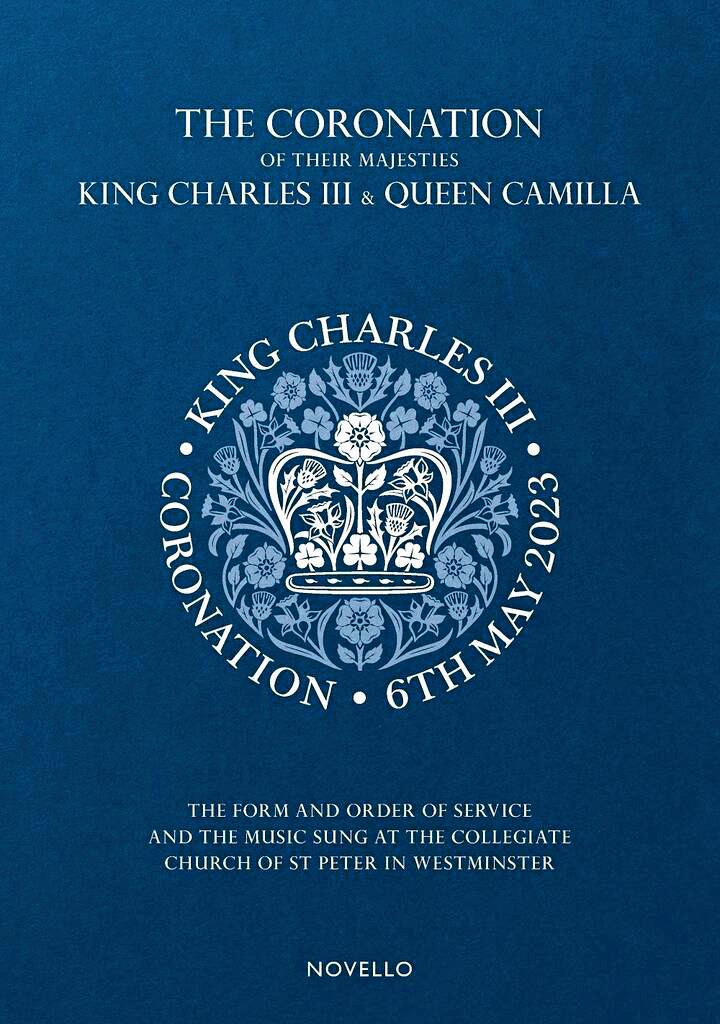
Novello & Co. has published the full order of service and vocal scores of all the choral music performed at the coronation of King Charles III and Queen Camilla on 6 May 2023 at Westminster Abbey. The 224-page book includes the six new commissions heard in the service – Coronation Kyrie (Paul Mealor), Alleluia (O clap your hands) – Alleluia (O sing praises) (Debbie Wiseman), Make a joyful noise (Andrew Lloyd Webber), Coronation Sanctus (Roxanna Panufnik) and Coronation Agnus Dei (Tarik O’Regan) – and the arrangements of ‘Christ is made the sure foundation’ and ‘Praise, my soul, the King of heaven’ made by James O’Donnell and Christopher Robinson respectively.
Cathedral Music Trust’s 2024 conference will focus on themes of education and participation, diversity and inclusivity, the intersection of theology and music, the chorister experience, and liturgical music in the twenty-first century. Perspectives of the current generation of participants and perspectives of the new generation of cathedral music researchers will make this conference a vibrant, exciting event for everyone involved in this field. Leading academics, practitioners and musicians will be presenting alongside postgraduate researchers, including many of the Trust’s Future Leaders. The event will provide opportunities for dynamic conversations and fresh insights, interdisciplinary collaboration and the exchange of innovative ideas.
19–20 September, Sarum College, Salisbury. More information, including how to book, will be available on the Cathedral Music Trust website from 3 May.
The Multitude of Voyces foundation, which promotes music and performance by and with those from underrepresented and marginalised groups, is fundraising to bring the music of Elizabeth Poston back into the public consciousness. Best known for her carol Jesus Christ the Apple Tree, Poston left many manuscripts on her death in 1987, and Multitude of Voyces is continuing the work of Dr John Alabaster in creating new editions of out-of-print and unpublished works. For more information, or to donate, visit multitudeofvoyces.co.uk
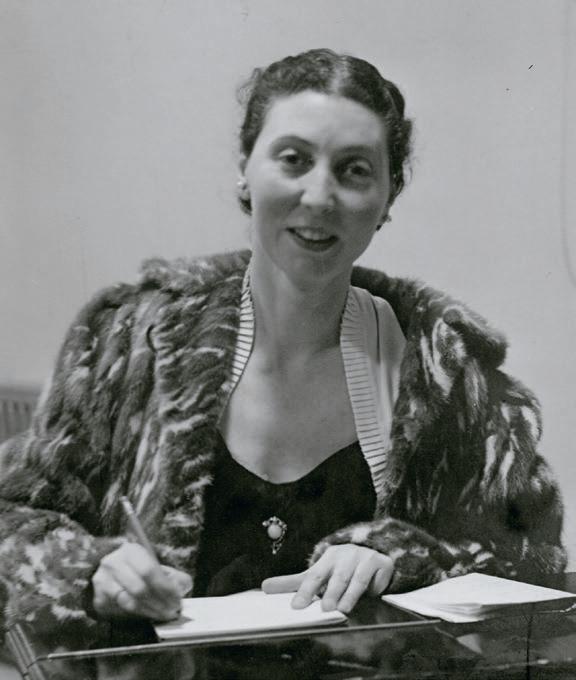
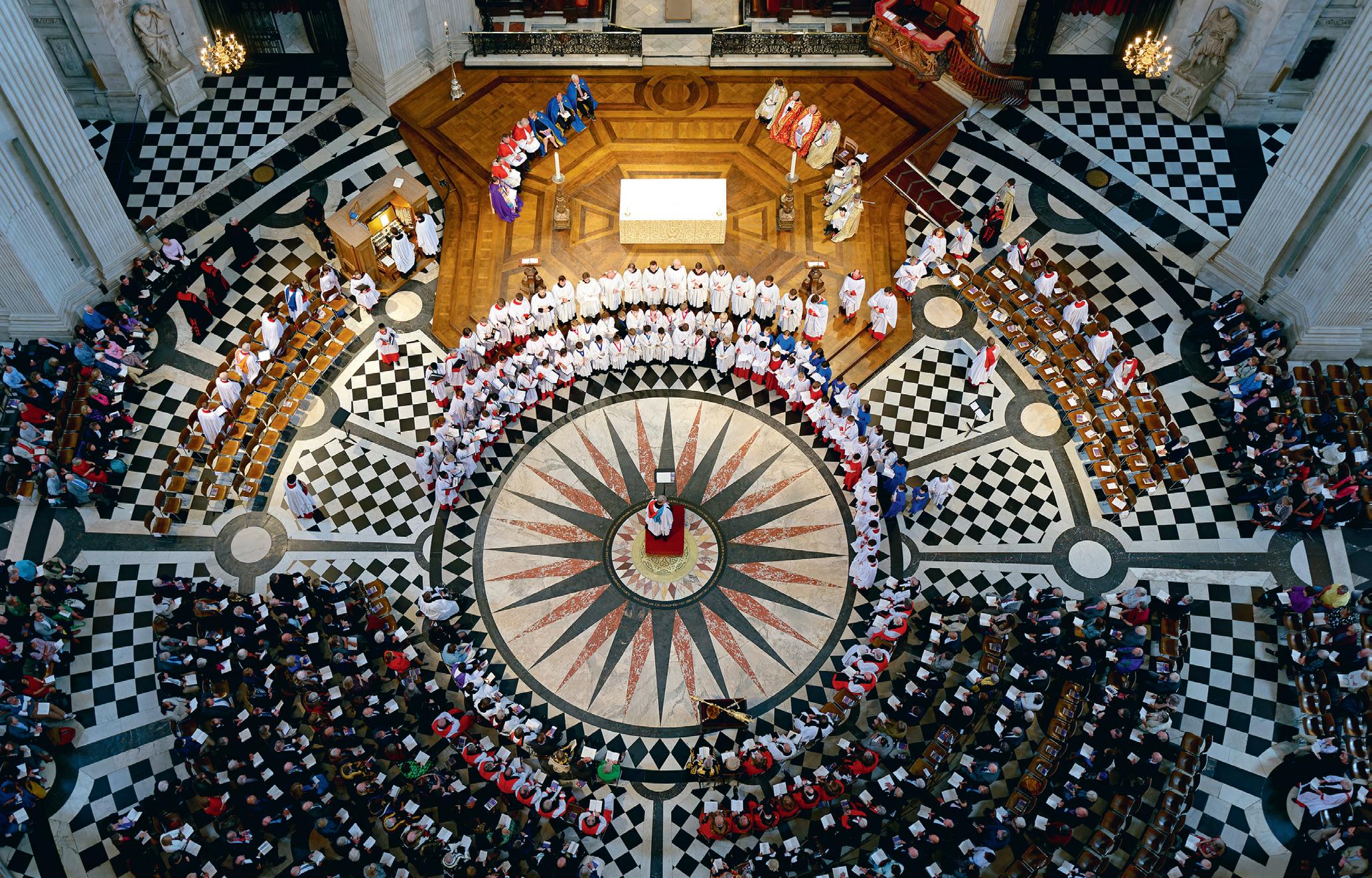
The Clergy Support Trust Festival Service will be held for the 369th time this year, for which the choir of St Paul’s Cathedral will be joined by those from Durham and Rochester cathedrals; the sermon will be given by the Most Reverend Andrew John, Archbishop of Wales and Bishop of Bangor.
The Festival Service is the occasion, more than any other, that helps to bring the work of the Clergy Support Trust (CST) to a national and international audience. Chief Executive of the CST, Revd Ben Cahill-Nicholls, explains that the Festival Service is three things. ‘First, it is an act of worship. Second, it is an occasion of thanksgiving for the work of the charity but also for ministry in all its fullness.
‘Third, it’s a choral service on a grand scale, and one that really demonstrates the power of the choral repertoire – when you have 120 singers together under the dome of St Paul’s it’s impossible not to be moved and thrilled in equal measure. And since cathedral choirs from
across the country are invited to take part on rotation, each combination of choirs has never been heard before, which is quite a moving thought.
‘We’re particularly excited about the music planned for this year’s service, which is a real choral journey. There will be pieces from Gabrieli through to Cecilia McDowall, and a real highlight is Elgar’s Give unto the Lord, which all three choirs will be singing together: it was written for the Sons of the Clergy [the forerunner to the CST] Festival of 1914, and so it’s lovely to be reminded of the history of the event.’
The CST’s history is a great deal longer than those 110 years; founded in 1655 to support clergy who had been made destitute during the Commonwealth, today the charity supports over 22% of Church of England clergy and their families, and in 2023 helped more than 2,700 households.
Cahill-Nicholls points out that the CST is ‘a rare organisation, in that we have essentially been carrying out
the same work since our creation, albeit with a few changes of name along the way – we have been providing the same kinds of support to more or less the same groups of people for nearly four centuries.’
Returning to the topic of the Festival Service, Cahill-Nicholls recalls how central choral music was to his journey of faith and to discerning his vocation, and talks enthusiastically of ‘how undervalued, underfunded and underappreciated’ Anglican choral music is.
‘Faith and music form such a powerful relationship, and cathedral music is a world that really shows that on a day-to-day basis; whether clergy or musicians, all of us are leading worship, both on an occasion such as the Festival Service or at a weekday Evensong, and I believe that is something to be extremely thankful for.’
This year’s Festival Service takes place at 5pm on Tuesday 7 May; to book a free ticket, visit clergysupport.org.uk/festival-2024.

The tenth anniversary of girl choristers in the choir of Canterbury Cathedral was celebrated at Evensong on 28 January with the premiere of a specially-written
The winners have been announced of the 2023 BBC Young Chorister of the Year, the first time the BBC Young Chorister of the Year competition was run along Junior and Senior categories rather than selecting a boy’s winner and a girl’s winner. Belinda Gifford-Guy – a former chorister at Wells Cathedral and now a specialist singer at Wells Cathedral School – won the Junior category, while Natalie Fooks – a student at Sheffield Girls’ High School –won the Senior category.
anthem by Gabriel Jackson. A setting of verses from Psalm 147, O praise the Lord, was commissioned by the Dean and Chapter of Canterbury and conducted by David Newsholme.
Norwich Cathedral has announced that from January 2024 girls will be able to audition alongside boys to join the Cathedral Choir and take up chorister scholarships at Norwich School. This will offer choral opportunities to boys and girls alike from the age of six to eighteen, increasing the range of opportunities available and ensuring the finest young voices can contribute to the Cathedral’s rich musical life. Until now, places for the Cathedral’s younger choristers have been open to only boys, although in 1995 the Cathedral started a senior girls’ choir for eleven- to eighteen-year-olds. Additionally, there are now plans to create a new group of senior boy choristers, giving teenage boys the opportunity to sing at Norwich. Both the senior boy and senior girl chorister groups will be open to young people from any school across Norfolk.
The choristers of Winchester Cathedral, Stephen Barton (composer and former chorister), and American composer Gordy Haab have won a Grammy Award for the Best Soundtrack for Video Games and other Interactive Media. Accepting this prestigious award, Stephen said, ‘A special moment for me on this, was [that] we had the choristers from The Pilgrims’ School in Winchester come and record on this. It reminded me about music teachers being the most important thing, so I dedicate this to mine.’ Back in 2022, Stephen engaged the choristers to take part in a recording project at Abbey Road Studios in London. The choristers, who sing with the Winchester Cathedral Choir and are educated at The Pilgrims’ School, can be heard on the soundtrack for the new video game, Star Wars Jedi: Survivor. Director of Music at Winchester Cathedral, Andrew Lumsden, said of the choristers’ achievement, ‘This is fantastic news for all of us at the Cathedral and The Pilgrims’ School but particularly for the choristers. They are thrilled to have won the award and are over the moon with excitement. It is also very exciting that we have similar projects already in the pipeline.’
The Grand Organ of Liverpool Metropolitan Cathedral has recently undergone restoration work. The project, which involved removing, cleaning and restoring each of its 4,565 individual pipes, took eighteen months to complete at a cost of over £1 million. This work was carried out by specialist organ builders Harrison & Harrison. Dr John Rowntree, Organist and Director of the Choir at Douai Abbey, acted as adviser for the project, and reports on the work.
The 1967 Walker organ of Liverpool Metropolitan Cathedral is iconic. It followed the influential, 1954, neo-Classical, electro-pneumatic organs of the Royal Festival Hall (Harrison) and Brompton Oratory (Walker). However, by 2015, the mechanisms, especially the schwimmers and compensators regulating the wind supply, were failing. The organ was unable to stay in tune: it was time for renovation.
The concrete organ chamber provided by the cathedral architect, Francis Gibberd, was problematic, being high at the front and low at the rear; this made it difficult to place big pedal pipes, some of which remain in a trench at the rear of the chamber. The adviser in the 1960s, Richard Wright OSB, a monk of Ampleforth Abbey, had wished the Liverpool organ to have more stops than the 104 in the Ampleforth Walker instrument; however, the chamber proved inadequate for even the 88 stops eventually installed, which were shoehorned in, without walkways for maintenance.
Equally unsatisfactory was access to the gallery, which was via an iron ladder twenty-six feet in height up narrow concrete channel from the car park beneath the cathedral.
Discussions began in 2015 and stalled. In 2019 four organ-builders were asked to tender. Concerns included: lack of power, extending the platform for more organ, a new nave section, mobile console, and re-voicing. One firm even suggested
replacing the organ entirely –providing a highly detailed submission. It was refreshing that the Cathedral Organ Committee –Dr Christopher McElroy, Director of Music; James Luxton, Assistant Director of Music; Richard Lea, Cathedral Organist; Terry Duffy, Cathedral Organist from prior to its opening in 1963 to 1993 and Director of Music 2004-07; and myself as Adviser – were unanimous that the organ had successfully served the cathedral since its installation in 1967 and should retain its integrity.
Harrison & Harrison were selected to undertake the work. The organ layout was re-configured for tonal egress and balance, and walkways for maintenance were installed. After the reconfiguration design was approved, the contract was signed and work commenced. Asbestos was then found in various parts of the organ. This led to a considerable delay, as mechanisms and pipework had to be decontaminated with the
assistance of asbestos experts. Finally, work recommenced.
One tonal change was agreed. The Postive had two 4ft flutes. One was replaced by a 4ft Principal to give better internal balance, and cohesion when coupled to the Great.
Tuning the Positive Cymbale, on the gallery edge, was hazardous. It was relocated to the rear of the chest. A safety restraint was installed for tuners! The Great Trumpets were moved from behind the Swell box to behind the Great chests.
Gibberd had not provided the gallery with a floor, merely a series of concrete upstands. The discarding of the schwimmers meant the new wind trunking had to go up, over, and around the upstands. Happily, amidst all the new technology the mechanical connection from console to swell boxes, 140 feet in length, was retained. The work was completed in 2023, and the newly restored organ was formally unveiled in early 2024.
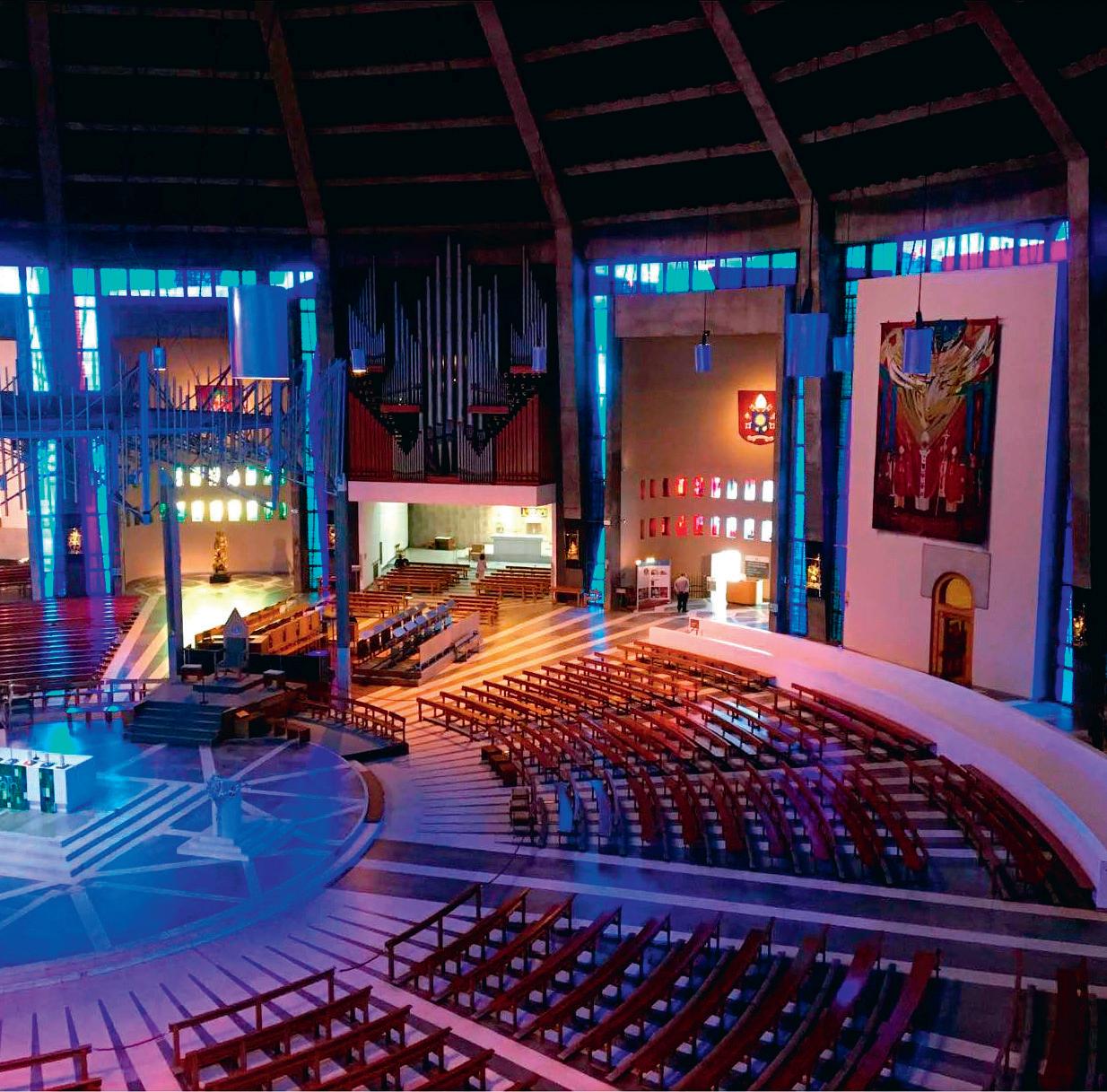
Five patrons from across the worlds of public service and the arts have lent their support to the St Margaret’s Choristers – a new girls’ choir founded at St Margaret’s Church, Westminster, in 2023. The patrons are: actress and author Baroness (Floella) Benjamin; Baroness (Sue) Carr, Lady Chief Justice; broadcaster Katie Derham; Sir Lindsay Hoyle, Speaker of the House of Commons; and Baroness (Genista) McIntosh, Senior Deputy Speaker of the House of Lords.
The St Margaret’s Choristers began meeting last September. The choir is made up of twenty girls aged between 11 and 17, drawn from schools across London, who receive free singing tuition as well as a generous scholarship. Under the direction of Greg Morris, Director of Music at St Margaret’s, they have the opportunity to perform some of the great cathedral music repertoire alongside the professional singers of the St Margaret’s Consort.

The Three Choirs Festival has announced the programme for its 2024 edition, with a celebration of nature and its enduring influence on composers and musicians at its heart. Highlights of this year’s festival include the UK premiere of Sarah Kirkland Snider’s Mass for the Endangered, Elgar’s The Kingdom, Gustav Holst’s The Cloud Messenger and Bob Chilcott’s The Angry Planet, with performances from the Three Choirs Festival Chorus, the Festival Youth Choir, Festival Voices, Three Cathedral Choirs, the BBC Singers and orchestrain-residence, the Philharmonia. There will also be smaller, more
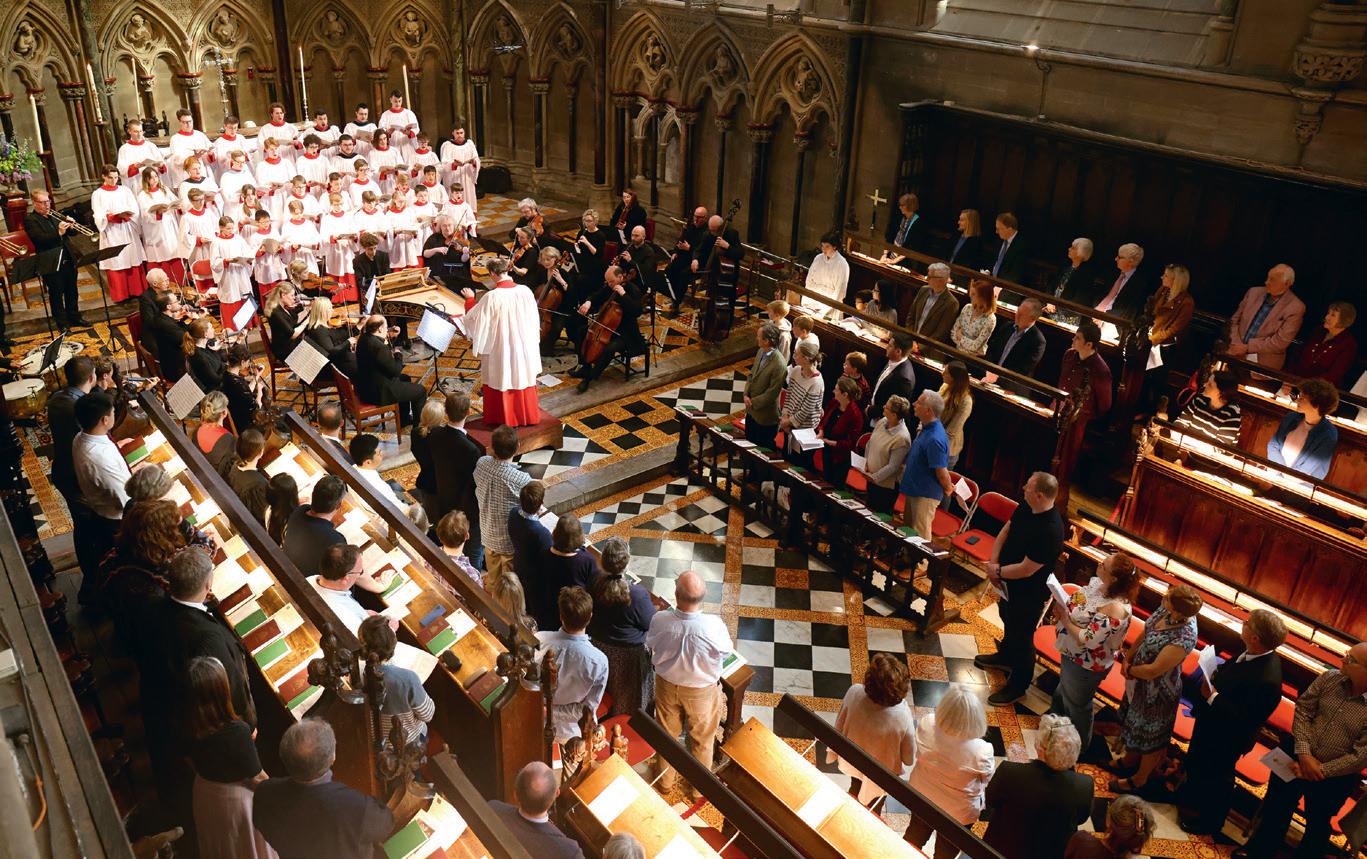
intimate concerts and a lively programme of family events, with soloists and performers including Anna Lapwood, Marta Fontanals-Simmons, Robert Plane, Francesca Chiejina, Jocelyn Freeman and Toby Spence. The 2024 festival marks Holst’s 150th anniversary, the 100th anniversary of Stanford’s death and the 70th birthdays of Judith Weir and the late Steve Martland, as well as including festival commissions from Nathan James Dearden, Paul Mealor and Luke Lewis.
The Three Choirs Festival takes place between 27 July and 3 August in Worcester; 3choirs.org
The Choir of St John’s College, Cambridge has premiered a triptych of works by composer Joanna Marsh and poet Malcolm Guite. The first part, The Hidden Light, was performed at the Choir’s Advent carol services last year; Refugee was performed at the Epiphany carol services in January 2024; and Still to Dust was premiered in March. The Choir will record the three pieces in the summer for release on the St John’s imprint label on Signum Classics in 2025.
Michael Whitefoot NATURE The Choir of St John’s College, Cambridge and Director of Music Christopher GrayWe offer our congratulations to the following, who are on the move

Helen Brookes has been appointed Singing Partnerships Lead at Canterbury Cathedral, where she will design and deliver opportunities for high-level musical engagement in the local community
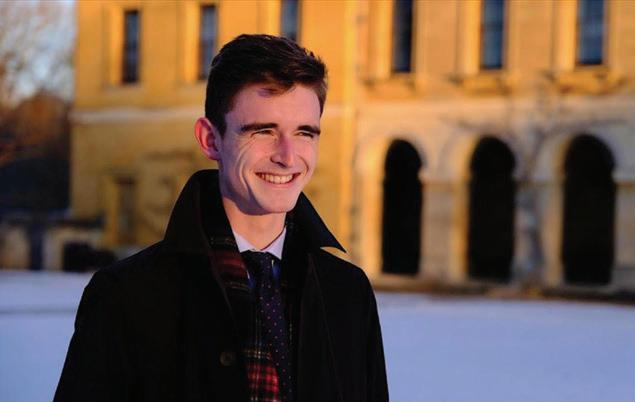
William Fox has been chosen as Director of Music at St Albans Cathedral; currently Assistant Director of Music at St Paul’s Cathedral, he was Organ Scholar at Magdalen College, Oxford and at Hereford and Wells cathedrals

Timothy Parsons, Director of Music at St Edmundsbury Cathedral, will take up the same position at Wells in September; he was formerly Assistant Director of Music at Exeter Cathedral
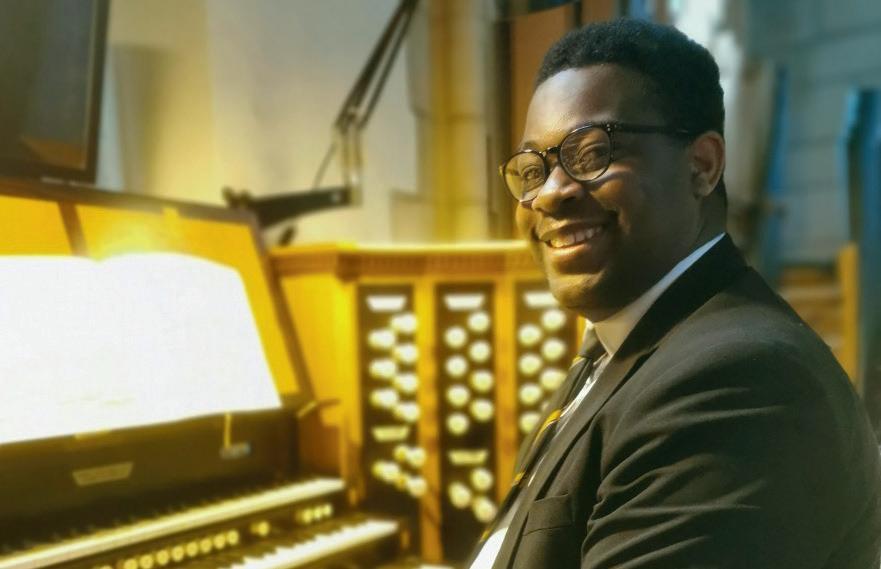
William Campbell has been appointed Organist at Leeds Cathedral. He was Organ Scholar at Canterbury Cathedral, and formerly held posts at St Helen’s, Stonegate in York and Leeds Minster
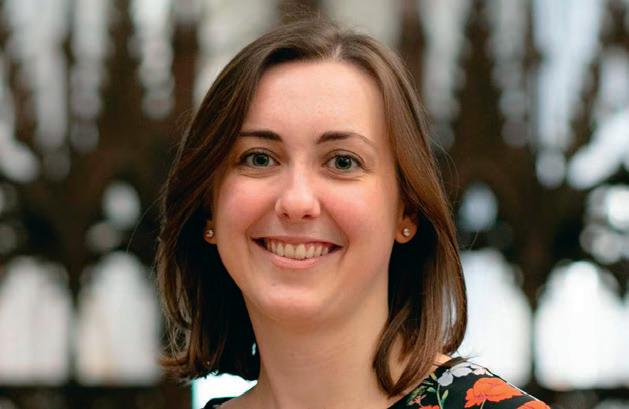
Claudia Grinnell has been appointed as Director of Music at St Edmundsbury Cathedral. SubOrganist at Winchester Cathedral since 2017, she was formerly Organ Scholar at Salisbury Cathedral and Peterhouse, Cambridge
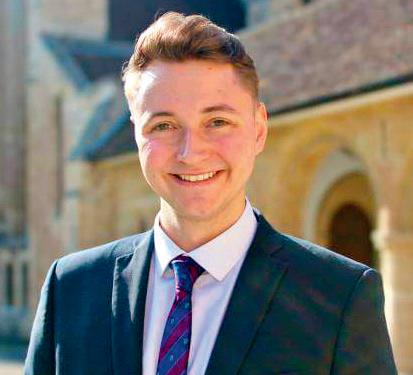
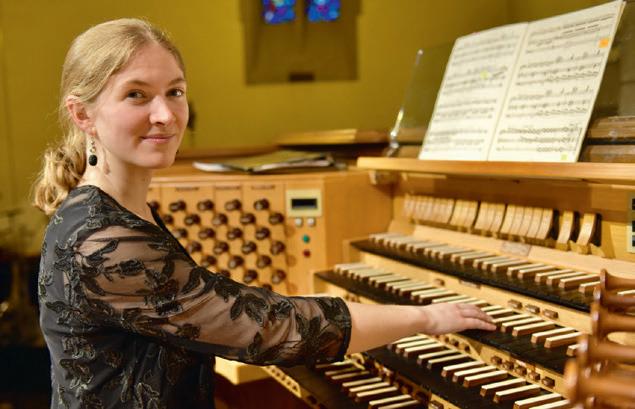
Carolyn Craig has been appointed Assistant Director of Music at Wells Cathedral; she is currently Organ Scholar of Westminster Abbey, and was previously at Truro Cathedral and Westminster Cathedral
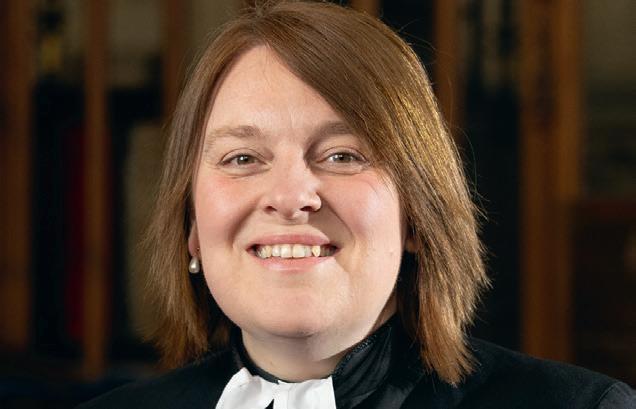
The Revd Canon Dr Victoria Johnson is the new Dean of Chapel at St John’s College, Cambridge, having been Canon Precentor at York Minster; she has a PhD in biochemistry and was a research scientist before ordination


St Paul’s Cathedral has announced three new appointments. William Bruce (left) has moved from Choral Director for the Diocese of Leeds to become Artistic Director of Choral Partnerhips; Jeremiah Stephenson (centre), who remains Associate Director of Music at All Saints, Margaret Street, is the new Organ Education Lead; and Alexander Knight (right) has been appointed Organ Scholar following his studies at the Royal College of Music


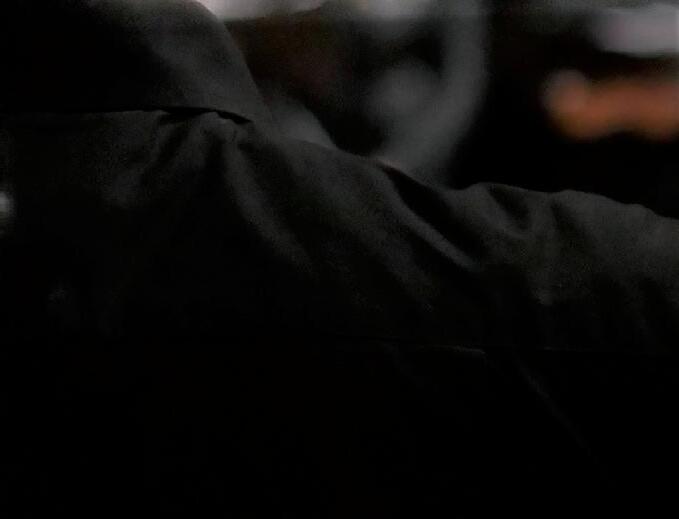





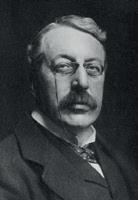

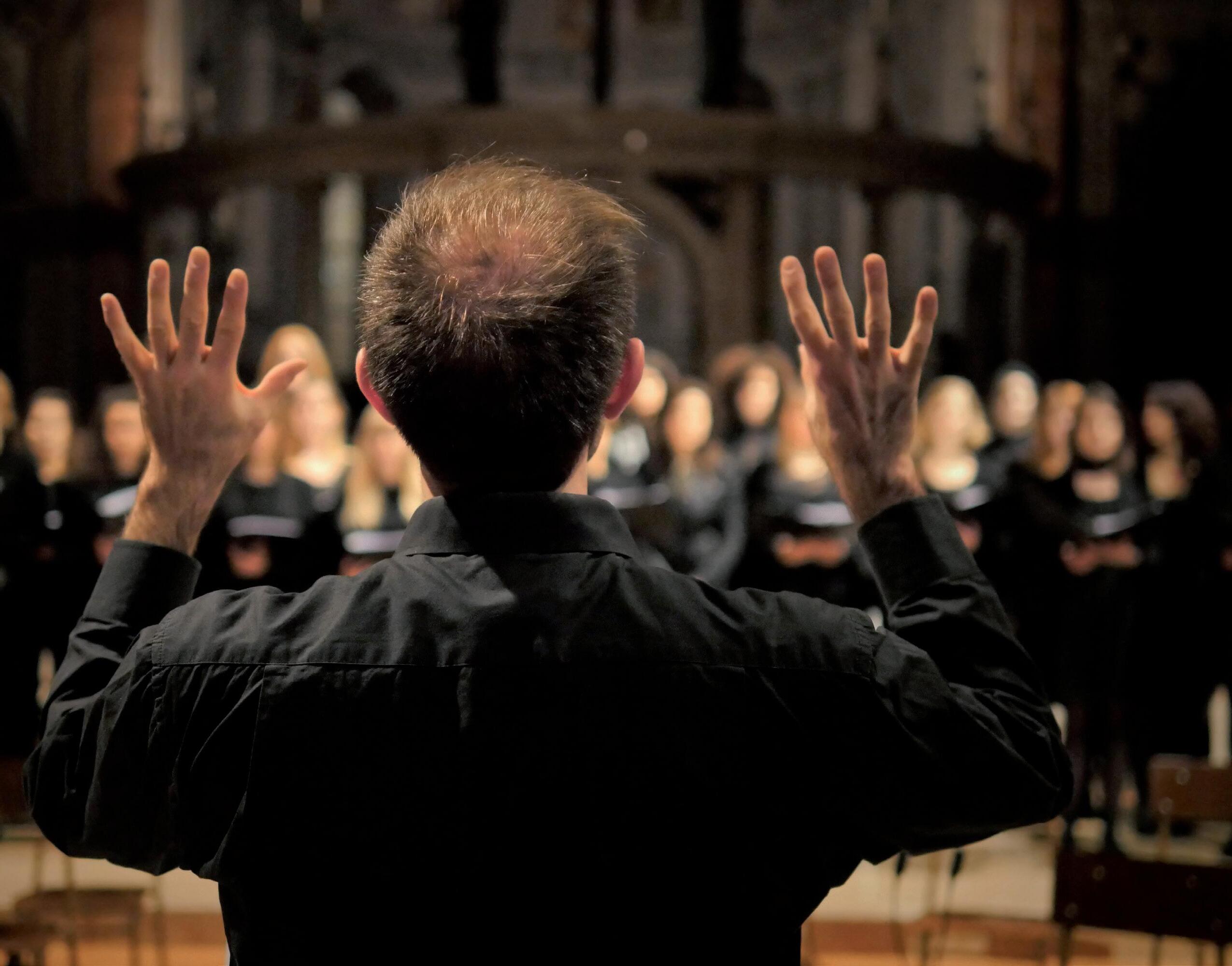



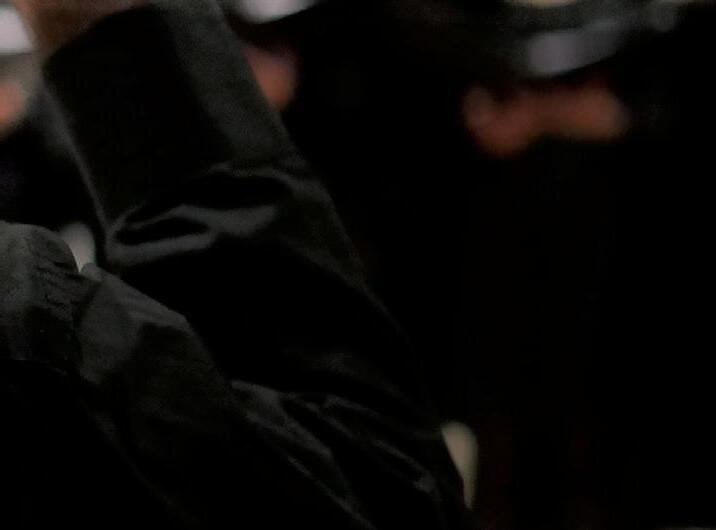
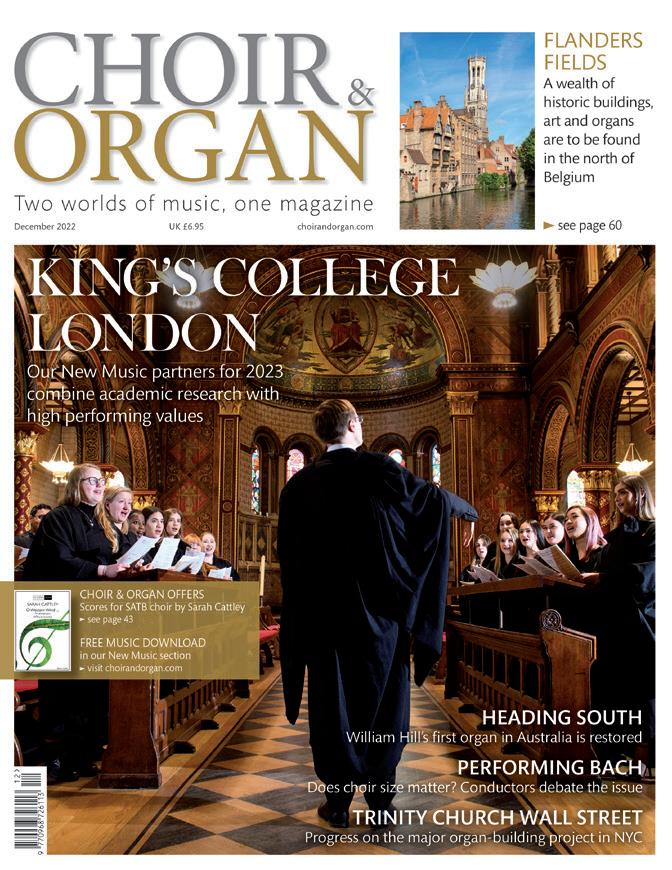
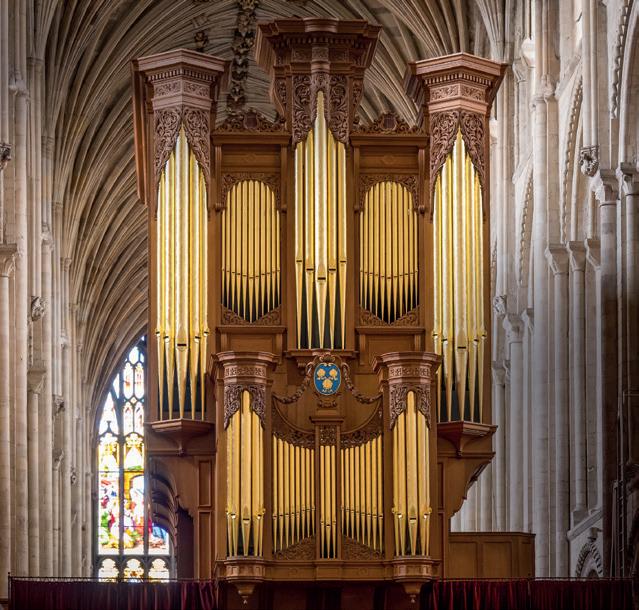

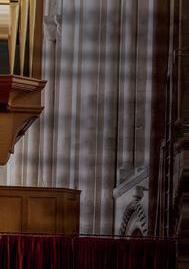


Don’t miss the opportunity to join a Cathedral Music Trust gathering near you


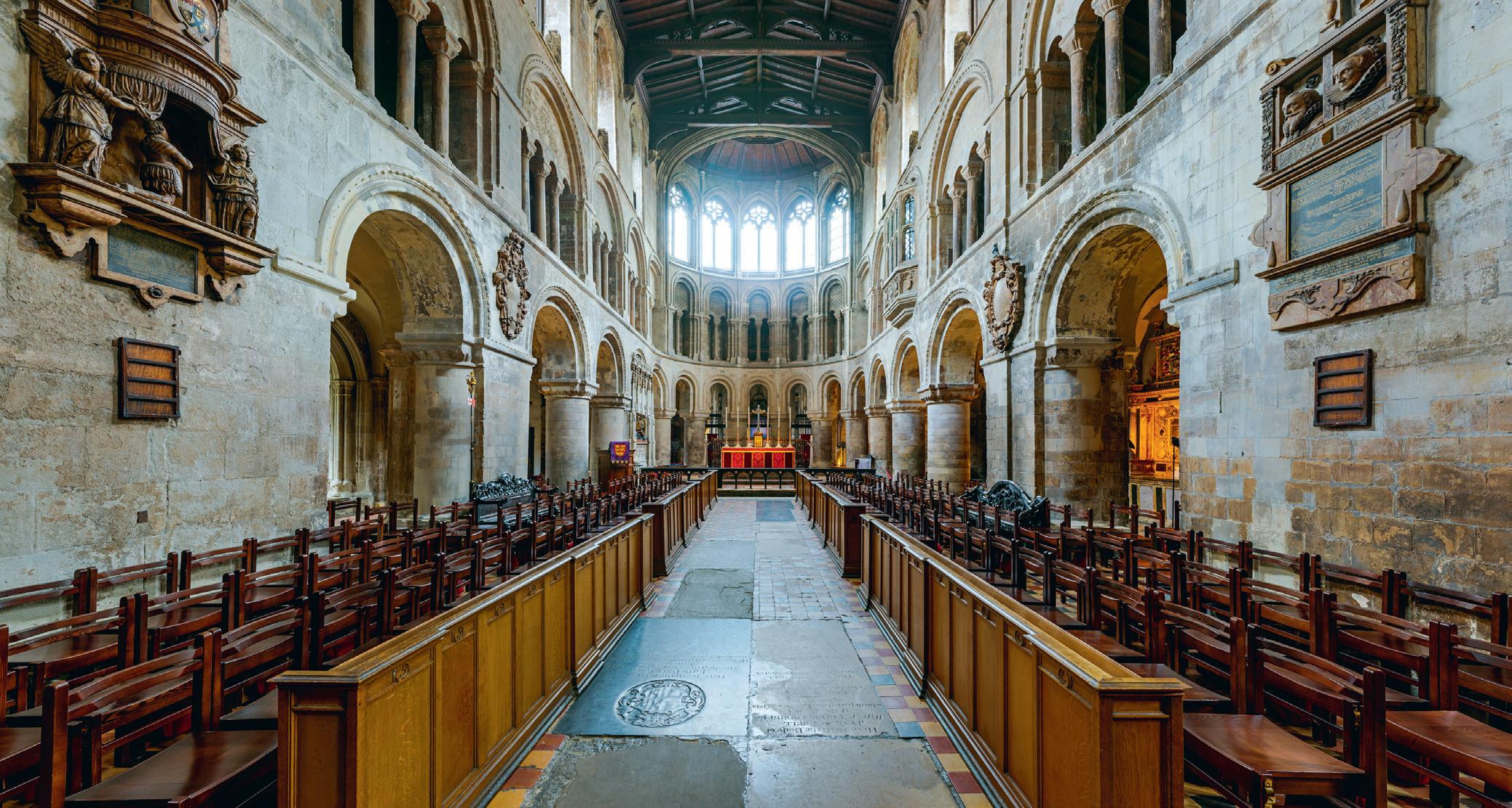
SUNDAY 2 JUNE 2024
Tower of London Gathering
Book now for a service of Choral Matins in the Chapel of St Peter ad Vincula. The service will be followed by a talk and organ demonstration, and the chance to visit St John’s Chapel in the White Tower.
SUNDAY 9 JUNE 2024
St Edmundsbury Cathedral
Observe the choir’s rehearsal for Evensong before attending the service, followed by a concert of organ duets by Timothy Parsons (Director of Music) and Richard Cook (Assistant Director of Music).
THURSDAY 19–FRIDAY 20
SEPTEMBER 2024
Cathedral Music: New Generation Perspectives
Cathedral Music Trust’s academic conference will focus on themes of
education and participation, diversity and inclusivity, the intersection of theology and music, the chorister experience, and liturgical music in the twenty-first century. Booking opens 3 May.
FRIDAY 20–SUNDAY 22
SEPTEMBER 2024
Salisbury National Gathering
Book now for our Autumn National Gathering and spend a long weekend with fellow cathedral music lovers in Salisbury, including all choral services, plus a talk by David Halls (Director of Music), an organ recital by John Challenger (Assistant Director of Music), and a choice of tours around the cathedral, cloisters and close over the three days.
TUESDAY 8 OCTOBER 2024
St Paul’s Cathedral, London
Save the date for ‘The Musicians of
St Paul’s’, taking in Choral Evensong, a talk by Director of Music Andrew Carwood and a concert of Stanford part-songs by the Vicars Choral.
SATURDAY 16 NOVEMBER 2024
St Bartholomew the Great
Save the date for a joint gathering of Cathedral Music Trust and the Prayer Book Society, including Choral Mattins, a talk by Rupert Gough (Director of Music) on the history of music at St Bart’s, an organ recital by James Norrey (Assistant Director of Music) and a service of Choral Evensong.
For more information or to book, visit www.cathedralmusictrust.org.uk/ events, email
info@cathedralmusictrust.org.uk, or call 020 3151 6096 (Mon–Fri, 9am–4pm).
As a Friend or Patron of Cathedral Music Trust, the support that you give allows us to make grants to cathedrals and churches all over the UK to fund their work. In 2023 the Trust made thirty-three awards totalling nearly £500,000; we profile a selection of last year’s recipients to see the impact that their awards have had
By ADRIAN HORSEWOOD
Liverpool Metropolitan Cathedral received a grant of £25,000 to support choral and organ studentship pathways for former choristers
For Dr Christopher McElroy, Director of Music at the Roman Catholic Metropolitan Cathedral of Christ the King, Liverpool, an important word is ‘young’.
‘We’re an unusual cathedral because of when it was built, in 1967 – making us one of the youngest cathedrals in the country. Also, the contribution of children to our music is huge and always has been ever since the cathedral was consecrated.’
Although there have been boy choristers since the 1960s, it was only in the 2000s that girl choristers were introduced – building on the Youth Choir first set up by McElroy in 1999 when he was Organ Scholar at the cathedral, which marked the first time that girls’ voices were heard in the building.
‘We now have two excellent sets of choristers who all attend the two cathedral choir schools, as well as the Youth Choir –now predominantly made up of former choristers in school years 9 to 13 – which has grown greatly over the last seven to eight years.
‘What we felt was an important next step was to create a pathway for former choristers to continue with their musical education, for boys from the age of around twelve or thirteen, and girls when they stop being choristers at sixteen.
‘We were continually seeing these former choristers with as much musical talent, knowledge and enthusiasm as university students – I personally know of at least ten former choristers from this cathedral who are studying at music college or reading music at university – enjoying being able to sing with the Youth Choir, but in a way it was all going to waste without something more formalised.
‘We already had several more advanced singers, for whom choral music could potentially be a career, coming to sing with the lay clerks at every service – among our lay clerks and deputies we have ten former choristers – but we wanted to take things up another level.’
Funding from Cathedral Music Trust has gone towards supporting several schemes for former choristers of the cathedral: an Organists’ Pathway, which sees organ students accompany and direct the Youth Choir and also occasionally work with the Cathedral Choir; and choral students, who also help with the Youth Choir and some of the chorister rehearsals.
‘This year, the funding has allowed us to appoint three choral students and two organ students, each of whom works three or four days a week in the cathedral. They also have their own rehearsals each week, and receive singing lessons; this includes the organ students, as it’s extremely useful for organists to be able to sing and talk to singers about singing.’
The selection process for the studentships was ‘rigorous – as tough as applying for a scholarship at Oxbridge,’ according to McElroy, ‘and deliberately so. They had to fill in numerous forms and attend interviews and auditions. We had twelve applicants for the three choral studentships, so we didn’t make it easy for them!’
The grant from Cathedral Music Trust has also helped to fund a director for the Youth Choir, who is a former girl head chorister at the cathedral.
‘This and the studentships all enable choristers and their parents to see that there is a clear path for choristers: they will get to sing from eight to eighteen and learn so much more along the way.’
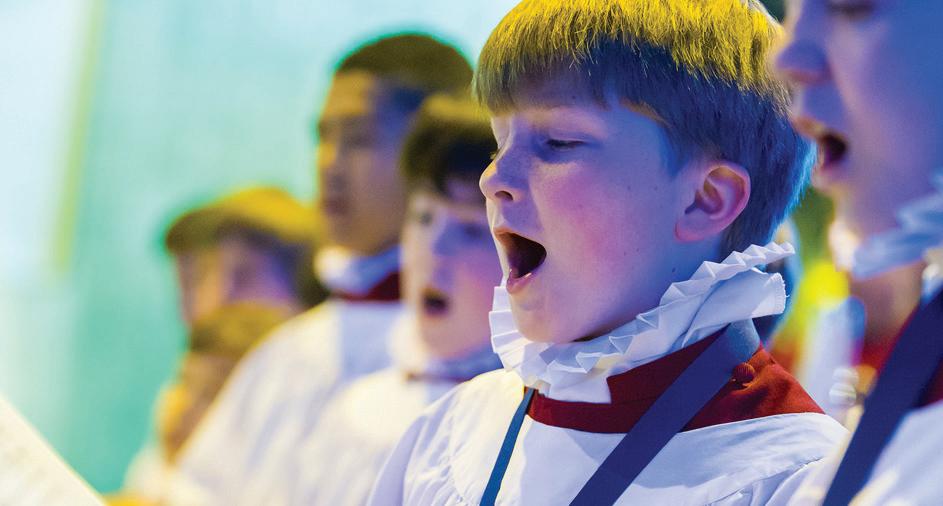
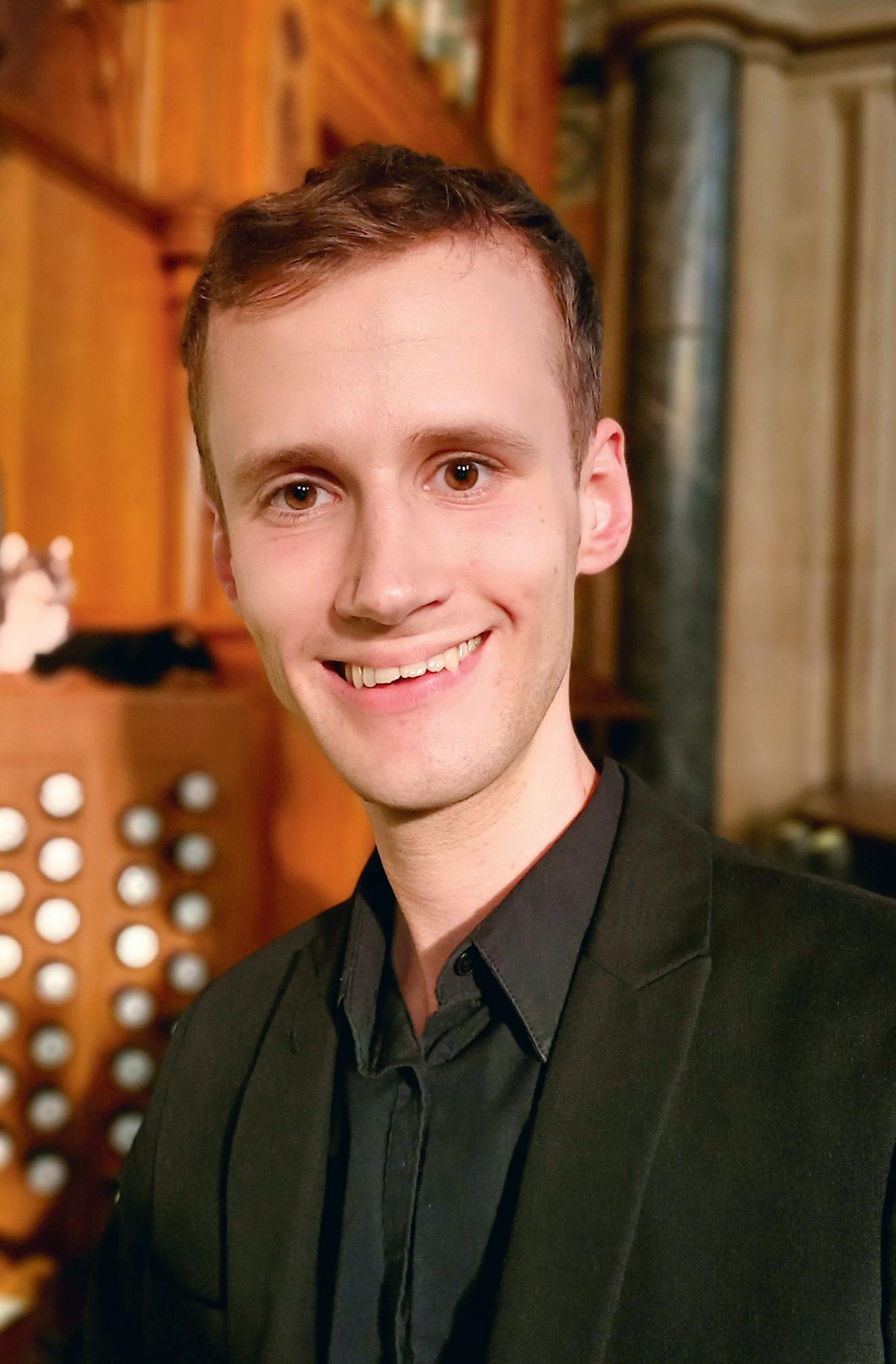
Chester Cathedral received a grant of £25,000 to support an organist who will also lead the development of a music outreach programme
The appointment of Daniel Mathieson (pictured above) as Head of Music Outreach and Assistant Organist at Chester Cathedral in September 2023 – supported by a grant from Cathedral Music Trust – heralded a new beginning in more ways than one.
As well as bringing the permanent music staff at Chester back up to three – its usual number, but which had not been the case since before the Covid-19 pandemic began in 2020 – Mathieson is spearheading the cathedral’s drive to bring its musical offering to a wider audience through projects and
collaborations across the local community and diocese.
Philip Rushforth, Organist and Master of the Choristers at Chester, is full of praise for how much Mathieson has achieved in such a short space of time – although he is also quick to acknowledge the hard work of Sub-Organist Alexander Lanigan-Palotai, during the pandemic.
‘Our current outreach work certainly isn’t new, but was definitely negatively impacted by Covid, and I’m very grateful to Alex for all that he has done to hold the fort during these last few years.
‘That said, we’re absolutely delighted with how smoothly Dan has set things in motion since his arrival. He has already organised two “Be a Chorister for the Day” events –one each for boys and girls – which were the first since 2020. They were both hugely oversubscribed, with over 100 enquiries in the first week alone; we’ve had to set up a waiting list for subsequent events later in the year.
‘Dan is also leading our partnerships with local state schools – we’re building up to holding a Schools Singing Day, in collaboration with Abbey Gate College, which we hope will also aid our chorister recruitment.
‘Before Alex and Dan joined us I was doing the bulk of working with schools, which I enjoyed, but it ended up being rather piecemeal and not very coordinated, to fit around my duties at the cathedral.’
Another facet to Mathieson’s role is overseeing the cathedral’s Saturday Singing Club for children aged between six and eleven; directed by one of the deputy lay clerks, it is a ‘useful trickle for finding choristers’, according to Rushforth.
‘In short, while we always worry about chorister recruitment, we worry much less now that Dan is on board and the music department feels complete again.
‘He helps us to tick all the boxes in terms of what we would like to provide musically for the cathedral and our local community, and to be honest it already feels as if he’s always been here!’
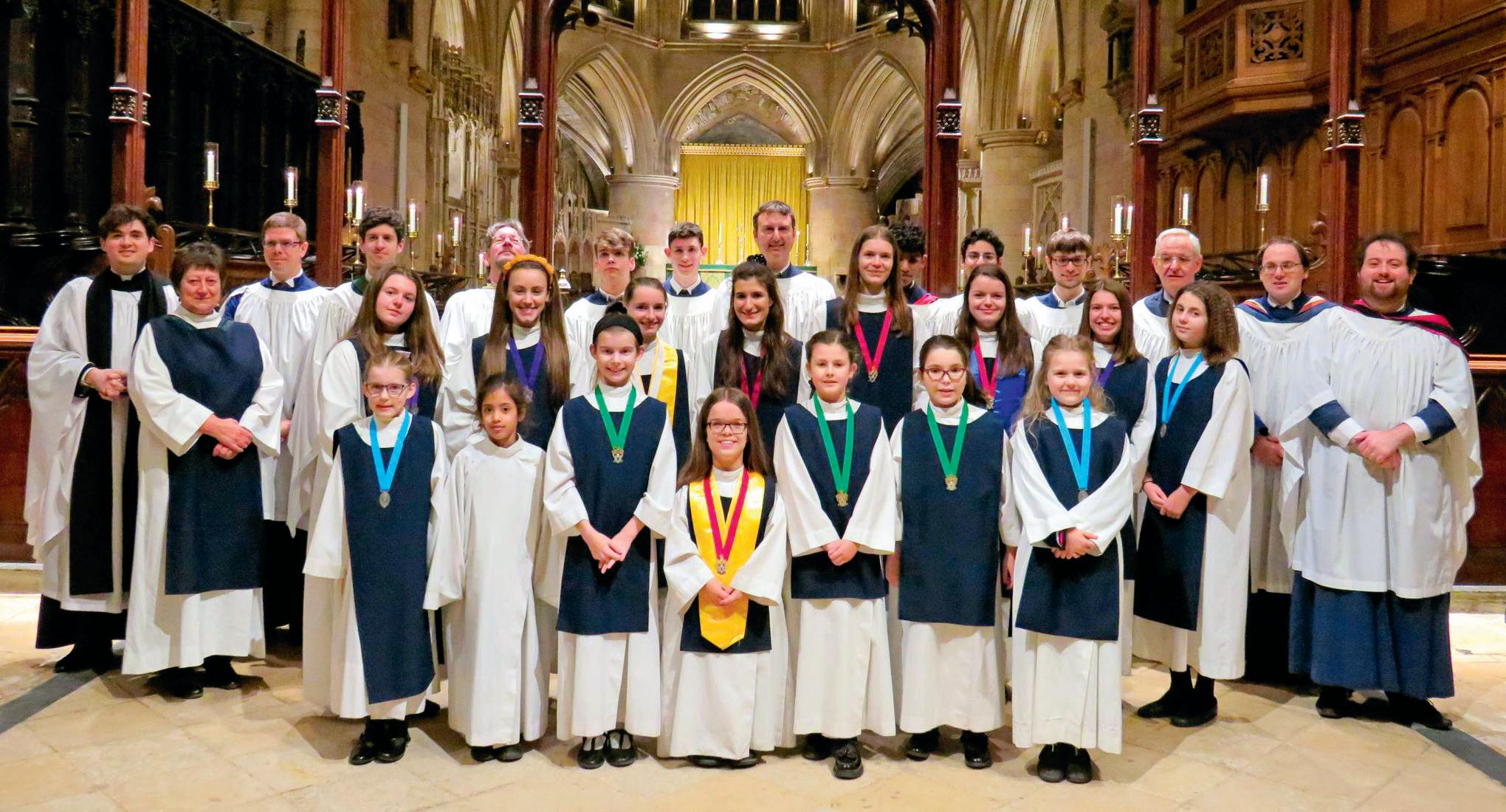
St Alphege, Solihull received a Church Choir Award of £6,000 to support a choral outreach project in local schools
St Alphege is the principal church in the parish of Solihull, and Director of Music Christopher Martin Thomas presides over a busy choral programme that sees five choirs regularly singing services each week: the Junior Choir (for children in school years 3–6), Boys’ Choir (former choristers include organist Iain Simcock, founder-director of Tenebrae Nigel Short, and Christopher Monks, director of the Armonico Consort), Girls’ Choir (whose alumnae include Alice Halstead, BBC Young Chorister of the Year in 2008), Men’s Choir (with choral scholars regularly moving up from the Boys’ and Girls’ Choirs), and the Ladies’ Choir.
Alongside this the Minims group is for five- and six-year-olds, who enjoy a thirtyminute musical fun session that overlaps with the Junior Choir’s Friday rehearsal, acting as a conduit for the youngest children.
Thanks to a Church Choir Award from Cathedral Music Trust, St Alphege has recently expanded its thriving choral offering to local primary schools, with its ‘Rising Stars!’ outreach project for Key Stage 2
children, running in partnership with Tudor Grange Primary Academy Yew Tree, Sharmans Cross Junior School, Widney Junior School and Oak Cottage Primary School – all within 1.5 miles of the church.
In March the four school choirs combined to perform Michael Flanders and Joseph Horowitz’s Captain Noah and his Floating Zoo at St Alphege’s, and in June the church will host an All-Stars concert – a ‘talent festival’ in which each school choir will present a mix of choral pieces, solos and instrumental pieces, before all combining for a grand finale.
For Thomas these are the encouraging fruits of much labour and dedication. ‘The first two terms have gone very well, and the Church Choir Award has meant that we could approach schools and say, “There is no charge to you or your pupils to take part”.
‘It’s a refreshing change from some of my previous jobs, when I found myself constantly fighting those who doubted that this kind of choral outreach work by a church could actually benefit schools. Many headteachers see it as just an add-on to whatever music provision they might already have, and don’t appreciate the wider benefits to the schools. The choristers play a big part in school choirs and help to encourage their friends, who in turn become interested and potentially inspired to become choristers themselves.’

St Fin Barre’s Cathedral, Cork received a grant of £15,000 to support singing lessons for choristers and junior lay vicars
When Peter Stobart was appointed Director of Music at St Fin Barre’s Cathedral, Cork in 2015, it was immediately apparent that singer recruitment would be one of his priorities.
‘The girls’ choir was – and has always been – in good shape, but there were only eight boys, seven of whom had started only a month or so before me! Thankfully our numbers are now much healthier and we have a full complement of sixteen boys.’
One particular aspect Stobart quickly homed in on was how to maintain the boys’ singing beyond their voices changing. ‘This was a key point at which many of them started to drift away from the choir; also, as the move from primary to seconday school happens a year later than in the UK [i.e. after the year in which a child turns twelve], we found that parents were often keen for their children to focus on school work.’
This was a key factor in the application to Cathedral Music Trust for funding towards singing lessons for choristers and young lay vicars. ‘The choristers aren’t in the cathedral
every day, so any additional singing they do is helpful for their vocal health. It also encourages them to keep singing by giving them some technical know-how and support.
‘Also, put simply, it’s often hard to find adults who can turn up and sight-read, so it’s very important to keep hold of those I’ve trained as choristers and encourage them to continue to sing as adults.
‘We’ve already hit the ground running, having started weekly lessons in September 2023. We have two teachers, one for the younger children and the other for the older, and they’ve been very popular.
‘In particular, we found that after the Covid-19 pandemic, we had teenage boys whose voices had changed in the interim who came back wanting to sing, but clearly all the vocal training they’d received was as trebles, so they needed a different kind of support.’
Working with schools is also a key part of this focus on chorister retention. ‘In 2017 we set up the Diocesan Church Music Scheme to foster singing and musical education in schools and churches throughout the diocese of Cork, Cloyne and Ross, and my Assistant Director of Music and I visit five or six schools a week. We’re trying to create a culture of singing within the Church of Ireland primary schools in the diocese.’
Inverness Cathedral received a grant of £4,500 to support three choral scholarships and an organ scholarship
Home to the northenmost cathedral in the British Isles, Inverness has long had to contend with being off the beaten track. The remoteness was part of the attraction for Adrian Marple and his family, who moved to Scotland from Suffolk in 2019; but on his appointment as Director of Music at the cathedral in 2022, Marple felt that it was also important to think about how to offer opportunities to younger singers in Inverness and the surrounding region.
‘I was lucky to inherit a choir of loyal and long-standing adult volunteer singers – I was the youngest person in the room at rehearsals – who were also a close-knit group of friends. However, there hadn’t been any youth element to the cathedral’s music offering for many years, which was something I was keen to develop.
‘The grant from Cathedral Music Trust enabled us to recruit this year’s choral and organ scholars, who have made such a difference not only to the sound of the choir, but also to our whole approach to music and the liturgy – they’ve brought fresh ideas and asked questions about things that we older hands perhaps have done unquestioningly for years.’
The new scholars have a weekly meeting with Marple before the main Friday evening rehearsal. ‘Initially this was about showing them the ropes – talking about choral singing and repertoire, but also practical things about services and worship – but this has evolved into more interesting discussions about issues such as faith and the Psalms, which has been great to witness.’
Marple is particularly enthusiastic about how much the current organ scholar, Hannah Spencer, has benefited from her experience with the choir. ‘When Hannah joined us she had never played the organ before and was starting completely from scratch – although as a good pianist and traditional fiddler she was very musical. She had a background in a different church, so the Anglican repertoire and liturgy was all new to her.
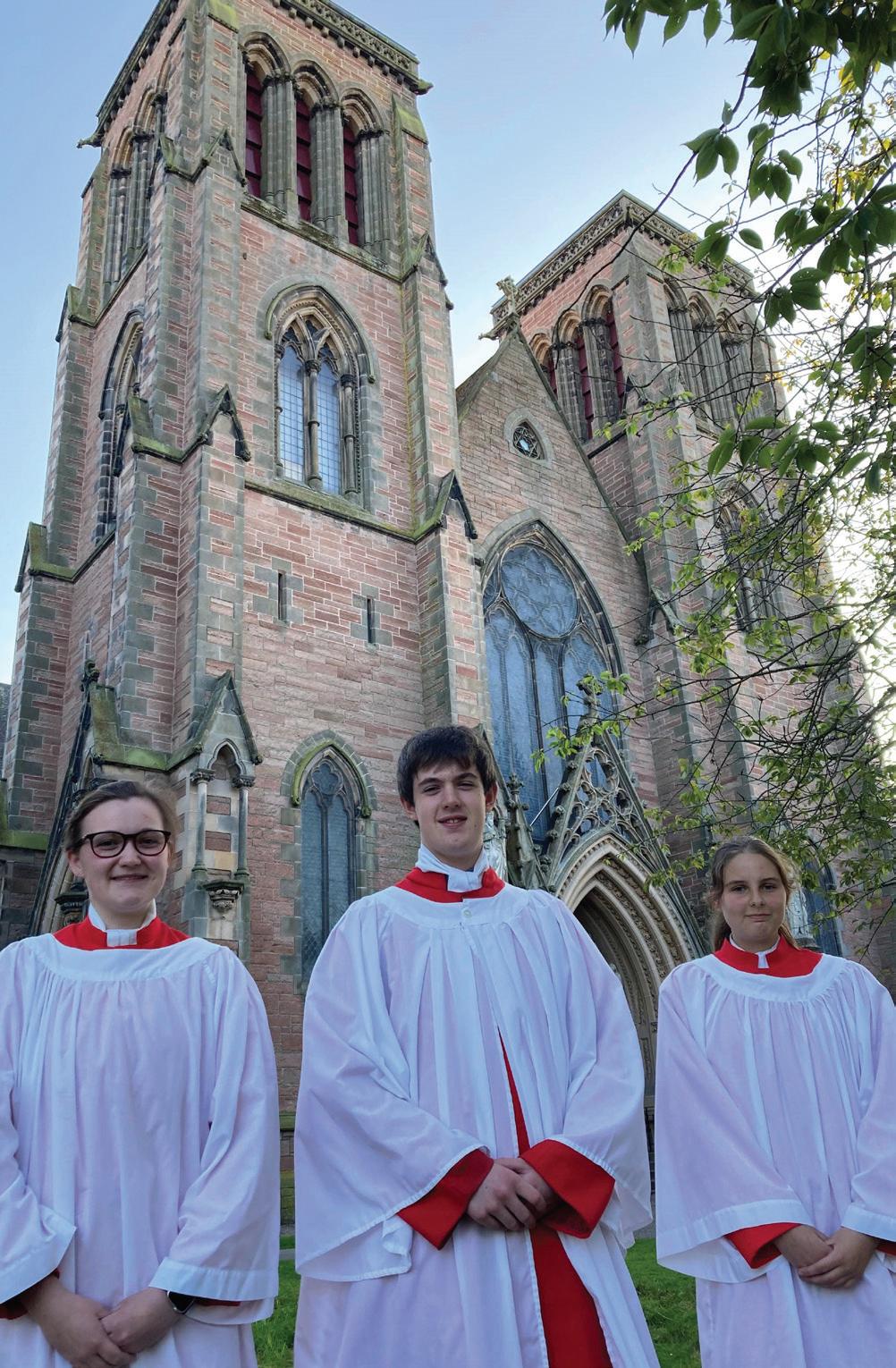
‘But she has been desperate to practise as much as she can, and also sings with the choir and plays for rehearsals; she has also recently accompanied her first anthem with the choir, and it has been fantastic to watch her development as a musician.’
As well as training the new scholars, Marple has initiated a Junior Choir at the cathedral for children aged between six and thirteen, which takes place after school on a Friday. ‘This started off as a small choir of just a few children who like singing, but has grown hugely – the next step is to include them in the liturgy from time to time. This is another aspect to cathedral music where the scholars have been invaluable.’
For more information on the Trust’s grant programmes and other recipients of awards, visit www.cathedralmusictrust.org.uk/grants
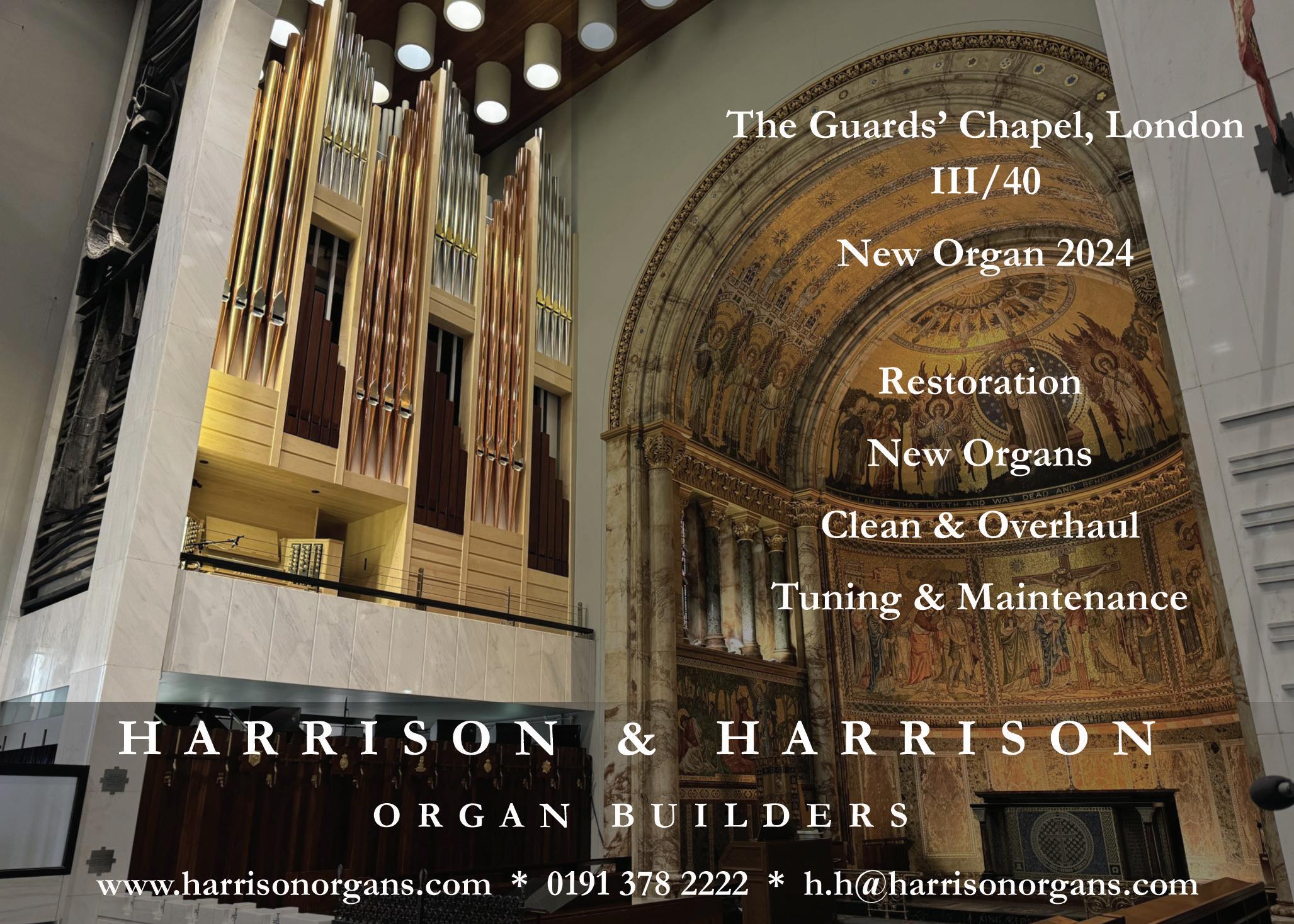

5 April - 7 November 2024, UK-wide tour
Something old, something new, something borrowed. Celebrating the art of imitation, the richly sensual music of Lassus and Josquin provides a stunning centrepiece to world renowned choir The Sixteen’s 2024 Choral Pilgrimage programme, inspiring a new work by Bob Chilcott and wrapping around songs from overlooked female composer Maddalena Casulana.
now


The ever-popular church music of Charles Villiers Stanford, the centenary of whose death falls this year, was but one part of the output of this extraordinary creative mind
By JEREMY DIBBLEABOVE RIGHT
With the exception of such works as the immutable The Blue Bird, the stirring Songs of the Sea and Songs of the Fleet and the Piano Concerto No. 2, Stanford’s reputation for most of the twentieth century resided in his unique contribution to music for the Anglican liturgy. Few would challenge the elevated status of its compositional originality, its intellectual qualities of invention or the high satisfaction derived from performing it from those who have participated in church, chapel and cathedral choirs across the English-speaking world. Indeed, to all who admire English church music, the name of Stanford is a household word. Yet we have perhaps never stopped to consider, given the strictures placed on the composition of liturgical anthems and settings of the canticles (there was always the restricted time factor to consider), what sort of creative personality came to write such music and what kind of creative stimuli contributed to its unequalled status and integrity.
In one respect, Stanford’s intensive background in church music at the two Dublin cathedrals during the 1850s and 1860s was undoubtedly a key formative experience, as were the twenty-two years he spent as a practising church musician and organist in Cambridge between 1870 and 1892. In this environment he learned not only to appreciate the entire history and changing styles of English church repertoire from the renaissance to the nineteenth century (and we know this from the surviving music lists at Trinity College, Cambridge), one which engendered a pioneering reverence for Elizabethan and Jacobean polyphony, Purcell and Blow, the more commonly accepted gamut of eighteenth-century composers such as Handel, Boyce, Greene, Nares and Travers (which still held sway in many cathedral and collegiate institutions), and the more contemporary voices of Thomas Walmisley (Stanford’s distinguished predecessor at Trinity), S. S. Wesley, William Sterndale Bennett and Stainer. In his role as Director of Music, Stanford also learned how to train and discipline a choir within the context of the typical Anglican services of Matins, Communion and Evensong, the liturgical details of which were in the constant process of incremental change. Yet, it should be understood that Stanford’s
church music was not composed in a vacuum. Even while his employment at Cambridge was circumscribed by the execution of the divine service and the exigencies of its liturgical parameters, his outlook as a musician was highly ambitious. On his return to Trinity College, in January 1877, he had become well acquainted with a host of European names such as Joseph Joachim, Johannes Brahms, Ferdinand Hiller and Clara Schumann; he was familiar with Wagner’s new Ring cycle which he had heard at Bayreuth in 1876, and during 1877 (which witnessed Wagner’s visit to London), he cemented friendships with Edward Dannreuther, George Grove, Hubert Parry and Hans Richter. Additionally, he was the author of chamber music, a symphony, songs, church music and incidental music for the theatre besides initial plans for his first foray into grand opera with The Veiled Prophet of Khorassan. In Leipzig and Berlin as a student under Reinecke and Kiel, Stanford had already produced impressive settings of the ‘Pater Noster’ of 1874 and two commemoration anthems for Trinity (In memoria aeterna) of 1874 and 1876, the techniques of which he had probably gleaned from the examples of Mendelssohn’s music for the Lutheran liturgy, but by the time he returned to Cambridge his mind was full of the new German symphonic music, particularly the symphonies of Schumann (especially those with their experimental formal designs of a cyclic nature), the new instrumental concept of Wagner’s music dramas (coupled with the larger theory of the Gesamtkunstwerk), and the epic Doric architecture of Brahms’s First Symphony. After placing the Cambridge University Musical Society on the map with the first English hearing of Brahms’s symphony in March 1877, the production of his first major chamber works – the Cello Sonata op. 9 and the Violin Sonata op. 11 –and the first (and only) performance of his own First Symphony at the Crystal Palace in March 1879, Stanford’s creative imagination gained a new momentum, a new-found propensity which manifested itself in the Morning, Communion and Evening Service op. 10, published in 1879.
The multi-faceted symphonic matrix of his Service op. 10, where, as he later stressed, the presence of musical form was imperative, established a model for all his later service
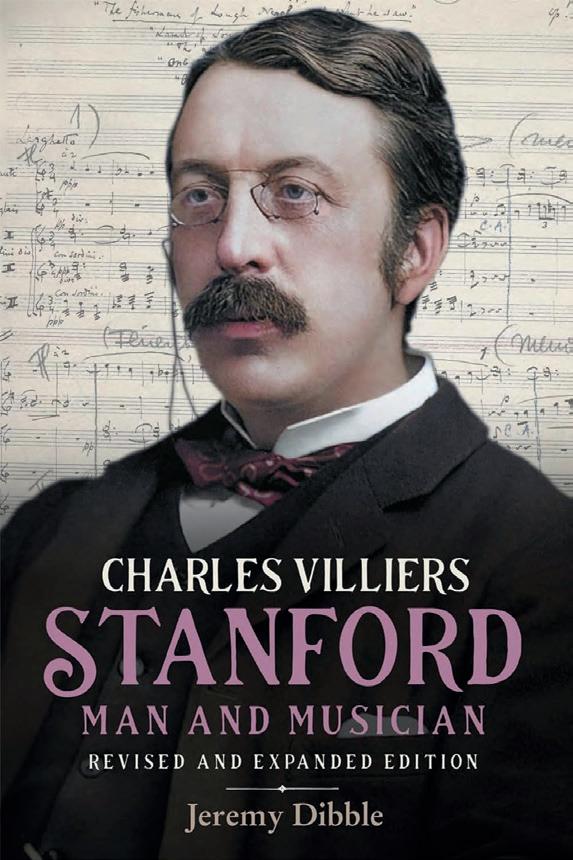
‘In terms of its quality, invention and innovation Stanford’s church music remains unequalled’
music and many of his anthems, and the cyclic method of thematic inter-relationships was also a concept he developed in all his later services. Moreover, it seems likely that Stanford wanted in some way to be able to re-create a version of Wagner’s Gesamtkunstwerk in his Service in B flat since, by thematically linking all his movements, a choir and congregation might take part in a broader experience of the Sunday liturgies, by way of the three main services of the day.
Stanford’s orchestral Service in A major op. 12, written for the Festival of the Sons of the Clergy, further crystallised his instrumental and formal approach to the composition of church music and this is nowhere more evident than in the orchestral role in the Nunc Dimittis which essentially dominates the structure. Similarly, the anthems Awake, my heart (1881), If then ye be risen with Christ (1883) and the masterly setting of The Lord is my shepherd (1886) are entirely symphonic in their processes of musical prose (which escape the regular phraseological periodicity of a good deal of Victorian liturgical music) and the manner in which the choir and organ (which might easily be replaced by an orchestra) closely interact thematically. Such questions of instrumentally-informed design are also worth examination in the later anthems such as the much neglected Arise, shine, for thy light is come (1905), the ebullient Easter anthem, Ye choirs of new Jerusalem op. 123 (1910), the bold setting of J. M. Neale’s translation from the Latin, Blessed city, heav’nly Salem op. 134 (1913) and the late How beauteous are their feet (1923), as well as the frequently overlooked Festal Communion
Service op. 128 (1910–11), a major composition which contains the often-sung Gloria, written for George V’s Coronation.
Stanford’s classical sense of discipline is also key to the understanding of a cappella works such as the Three Latin Motets op. 38 in which Justorum animae and Beati quorum via make inventive use of sonata principles while the through-composed, eight-part Coelos ascendit hodie reveals Stanford’s historical assimilation of seventeenthcentury antiphony.
This historical awareness lay at the heart of his six ‘hymn anthems’ op. 113 which draw on Baroque techniques of ‘chorale prelude’, while the magnificent Latin Magnificat op. 164 in eight voices, dedicated posthumously to Hubert Parry (1919), looks to the Bachian motet as well as the buoyancy of the Magnificat BWV 243.
As Stanford’s style matured, and the intricacy of his instrumental works intensified – we can observe this in the impressive catalogue of his later symphonies and chamber works – so did the conceptually experimental nature of his church music. The inspired rondo form of the Magnificat and the subtle monothematic canvas of the Nunc Dimittis from the Service in G op. 81, both of them idiomatic importations from the lieder tradition (as ‘songs’ of Mary and Simeon), are primary examples of this intellectual process. So are the ingenious (yet unlikely) variation techniques of the Magnificat in C op. 115 (1909) and the first of the Three Motets op. 135, Ye holy angels bright (1913) which were surely motivated by Stanford’s increasing preoccupation with instrumental variation forms, explored with great fecundity in his Concert Variations on an
‘Stanford’s church music was not composed in a vacuum … his outlook as a musician was highly ambitious’
English Theme ‘Down Among the Dead Men’ op. 71, the two string quintets opp. 85 and 86, the Scherzo of his Nonet Op. 95, and even more so later in his Seventh Symphony op. 124, the Irish Concertino op. 161 and the Variations for Violin op. 180.
as the imposing conclusion of the Fifth Symphony op. 56 (1894).
JEREMY DIBBLE
Jeremy Dibble is Professor of Musicology at Durham University and a leading expert on British and Irish music of the nineteenth and twentieth centuries
The idiom of song, seminal to the Evening Service in G, was also one which instigated the composition of Stanford’s Six Bible Songs op. 113 (1909). These works are now quite often sung as anthems, though it is clear from the dedications that they were intended for prominent soloists of the day - Harry Plunket Greene (nos. 1–3, 5 and 6), Britain’s leading baritone, and Agnes Nicholls (no. 4), well known in London for her roles in Wagner’s operas and the oratorios of Parry and Elgar. The Bible Songs are also songs with a difference. Accompanied by the greater tonal compass of the organ, more symphonic in their tonal behaviour and treatment of material, and more substantial in length, they acquire a different type of idiomatic identity, having more in common with an operatic or concert scena, and when concluded by their corresponding ‘hymns’ – which, in sharing thematic material from the song, assume the character of ‘chorale preludes’ (see above) –the idiom is persuasively suggestive of an eighteenth-century solo cantata, romantically transformed and re-interpreted. Such hybrid practices were typical of Stanford’s later experiments with genre and form. We should also not discount the principal area of creativity in which Stanford aspired to achieve beyond all others: opera. Although – with the exception of Shamus O’Brien op. 61 (1896) and perhaps some modest exposure with his Shakespeare opera, Much Ado About Nothing op. 76a (1900) and the opera-burlesque, The Critic op. 144 (1915) – success eluded him in the theatre, his instinct for drama can nevertheless be heard throughout the breadth of his fertile output, whether in such vivid choral works as the Wagnerian Elegiac Ode op. 21 (1884), the Requiem op. 63 (1896), the highly operatic Stabat Mater op. 96 (1906) and the closing, panoramic bars of the Songs of the Fleet op. 117 (1910) or in the symphonic works such
In this regard we cannot discount Stanford’s church music, where dramatic effect is everywhere in evidence. The climactic moments of the Te Deum, Magnificat and Nunc Dimittis of the Service in B flat (especially in their orchestrated forms of 1902–03) breathe an affinity for the stage, and the emotional highpoint of the Nunc Dimittis of the Service in A, with its triumphal entry of the trumpet (‘And to be the glory of thy people Israel’), was surely inspired by Stanford’s experience of hearing the closing scene of Das Rheingold. His funeral anthem, Blessed are the dead, written in memory of Henry Bradshaw, quotes from his second opera, Savonarola (1884). Drama permeates the pages of the Coronation Gloria, and even more so from the arresting war anthems Lighten our darkness (1918), notably its striking opening, and the exhilarating For lo, I raise up, a choral scena full of colourful imagery written for St George’s Chapel, Windsor in 1915.
As we focus this year on the centenary of Stanford’s death, it is right and proper that our veneration of his church music should continue in much the same way as it has endured for the last century. In terms of its quality, invention and innovation it remains unequalled and its regular place in Anglican music lists provides unambiguous evidence of its timelessness and immutability. However, our reception and critical acumen of Stanford’s music has also essentially been governed by our familiarity with his ecclesiastical output far above the considerable and varied music he produced in other genres; indeed, the church music has invariably been used as a prism to appraise his other works, whereas, in truth, we should invert this perception of his anthems and services by comprehending first and foremost that it was his formal brilliance, his technical versatility, classical discipline and his fertile creativity in other genres which ultimately determined the concept and originality of the liturgical music we know, sing and admire today.
The repair work on Notre-Dame de Paris is nearing completion, five years after the cathedral caught fire. Restoring the organ has been a joint effort involving three different companies
By PIERRE DUBOISOn 15 April 2019, the cathedral of Notre-Dame in Paris was engulfed in flames after a fire accidentally broke out in the attic. Onlookers and television viewers around the globe watched in dismay as the familiar neo-gothic, 96-metre-high ornamental spire erected by architect Viollet-le-Duc in 1859 collapsed onto the roof of the cathedral. Beyond the significant damage caused to the building, what all organists and organ-lovers feared was that the cathedral’s famous organ, which has been its voice and soul for at least three centuries, might be irretrievably lost. Amazingly, the instrument still contains pipes dating back to its early origins and its various successive rebuilds, which all coalesce into a magnificent whole. With 115 stops (156 ranks) on five manuals and pedal, and nearly 8,000 pipes, it is the largest organ in France as far as the number of stops is concerned. Thirtythree stops predate the French Revolution, and some fifty stops come from CavailléColl’s organ. It is an important part of the national heritage and it is no wonder, therefore, that it should have a strong symbolic value in the national psyche.
An organ was mentioned at Notre-Dame as early as 1357. A new instrument was built by Frédéric Schambantz in 1403, later enlarged and transformed; twelve pipes survive from this ancient instrument. Between 1730 and 1733 François Thierry erected a new instrument in a new case, which still constitutes the basis of the current organ. This was enlarged by François-Henri Clicquot, who built a new Positif, between 1783 and 1788. Between 1864 and 1868,
Aristide Cavaillé-Coll turned the instrument into a symphonic organ. Architect Viollet-leDuc asked for the Positif to be removed (its case is still extent; it was restored – albeit without its pipes – by the Quoirin workshop and is currently housed, together with Cavaillé-Coll’s former console, in an anteroom in the South tower leading to the loft).
In 1904, Charles Mutin modified the organ and added several stops upon the request of organist Louis Vierne. In 1924, an electric blower was installed, which was financed by Claude Johnson, Rolls-Royce’s Chief Executive Officer. In 1932, Joseph Beuchet, the then manager of the Cavaillé-Coll workshop; carried out extensive restoration work, including changes to the Récit. Between 1959 and 1975, under the influence of titulaire organist Pierre Cochereau, the organ was further altered by Jean Hermann and Robert Boisseau and its symphonic character was partly lost. The mechanical action with Barker levers was replaced with an electric action and a new console built. A set of chamades was installed. In 1990-92, a large-scale restoration was undertaken by Robert Boisseau and Bertrand Cattiaux, Philippe Émeriau, Michel Giroud, and the Société Synaptel. While the classical 32’ ‘Grand Choeur’ was preserved, the nineteenth-century symphonic character of the instrument was partly restored. In 2012–13, a new restoration was undertaken by Bertrand Cattiaux and Pascal Quoirin. The key action and digital system were upgraded
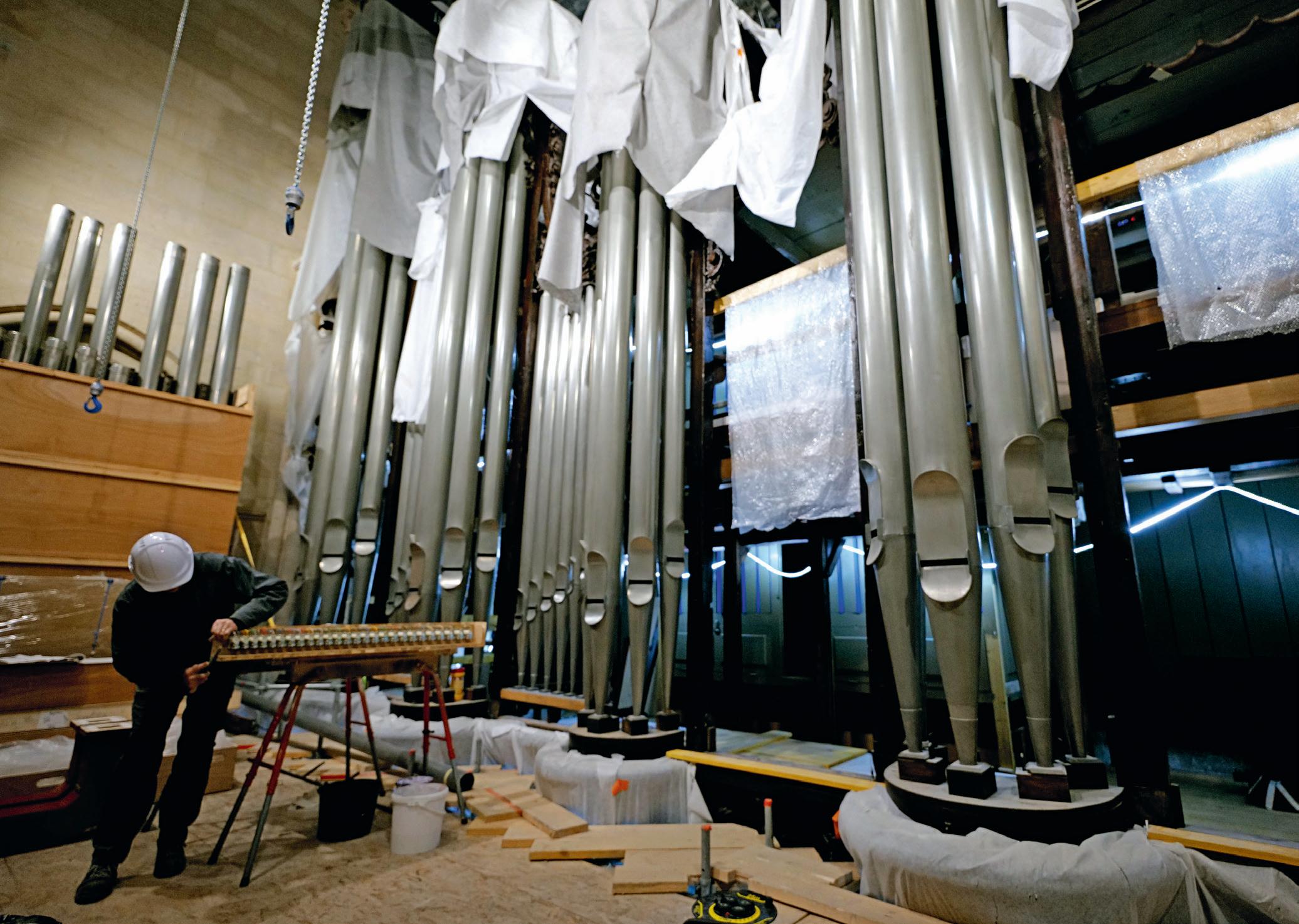
and Cavaillé-Coll’s stop action was replaced by new high-pressure pneumatic actuators. A new frame for selected components of the Hermann-Boisseau-Cattiaux console was installed, a new enclosed, floating division (‘Résonnance expressive,’ using pipework from the former ‘Petite pédale’ by Boisseau) was created, the organ case and the façade pipes were restored, and a general tuning was carried out.
Fortunately, during the 2019 fire, the organ was spared thanks to the stone terrace above the vaulting under which the instrument is placed. Christian Lutz, organologist and consultant technician approved by the Ministry of Culture and project manager for the restoration of the great organ, explains that when the spire collapsed, the sudden heat wave inside the building must have bounced back against the wall behind the organ. Inside the instrument, traces of that deflagration were visible at the back of the case while the front was hardly affected. Although covered in lead dust, neither the case nor the pipe-work (which it was feared might have melted because of the heat inside the building) was destroyed and, during their intervention, the firefighters managed to avoid flooding the organ. However, unlike the great organ in the west end, the chancel organ (two manuals and pedal, 30 stops and
37 ranks) was heavily damaged by waterlogging and its restoration is still under study.
After the fire, it was immediately decided to rebuild the cathedral within a very short span of time, a mammoth task which seemed impossible but which has proceeded steadfastly under the project management of the public organsiation ‘Rebâtir Notre-Dame de Paris’ especially set up for the restoration project and chaired by General Jean-Louis Georgelin, appointed by President Emmanuel Macron. After General Georgelin’s accidental death in August 2023, he was succeeded by Philippe Jost, his former right-hand man. To cover the cost of the restoration of the cathedral and its organ, donations were sought. 340,000 donors from 150 countries have responded, and 846 million Euros have been collected.
Organ advisers Christian Lutz and Eric Brottier were chosen to supervise the restoration of the instrument. A call for tenders was launched by Rebâtir Notre-Dame de Paris on 1 April 2021. Due to the magnitude of the task, the sheer size of the instrument and the rather short delays granted for its restoration, which is due to be completed by the end of 2024 (the cathedral is set to be ▷
ABOVE Setting of electromagnets under the windchests. The Grand-Orgue façade pipes, which are too large to be taken out, had to be repaired on the spot
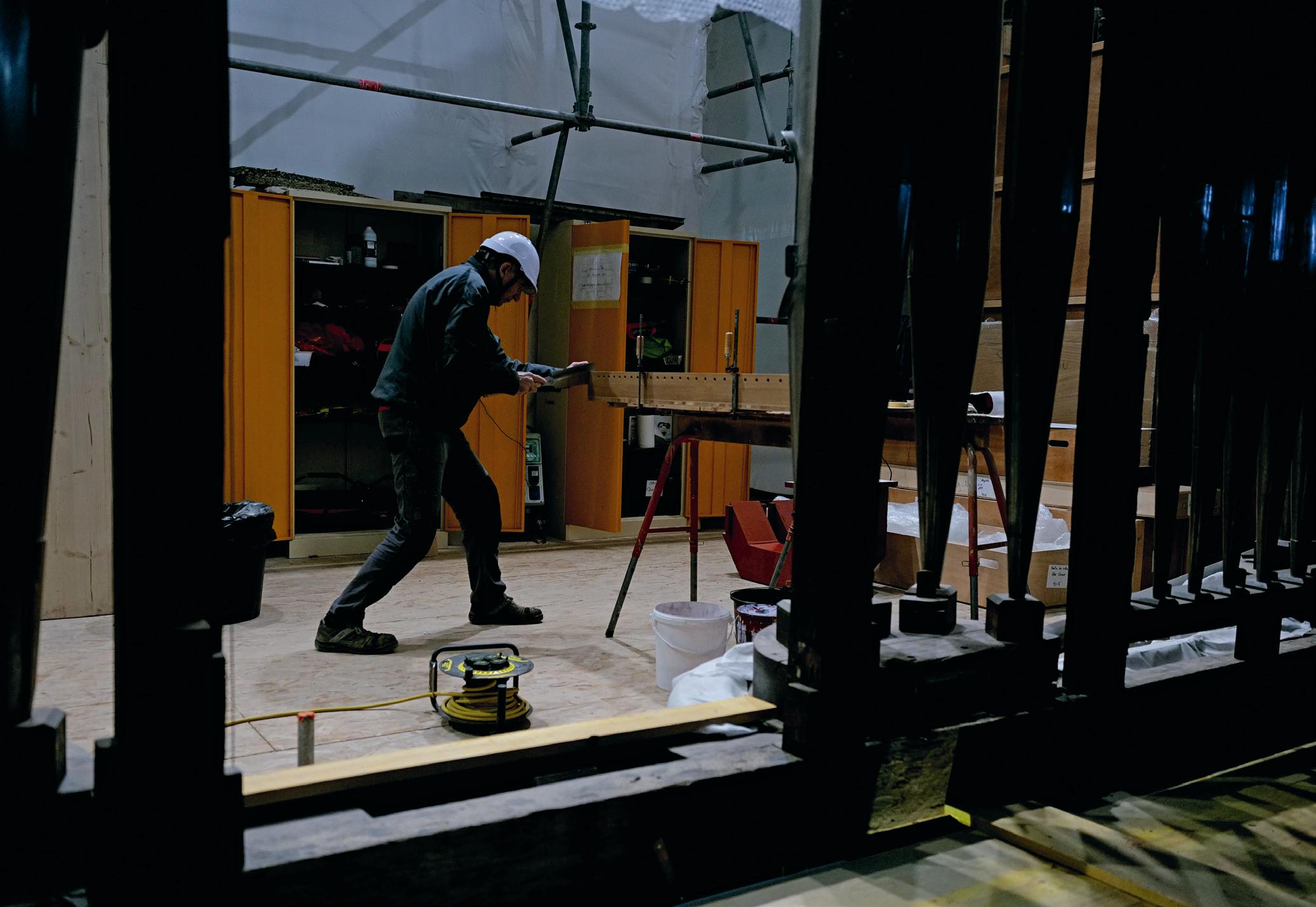
‘The re-setting up of the organ, which has been the voice of Notre-Dame de Paris since 1733, symbolises the return of the spiritual dimension’
ABOVE Setting of electromagnets under the windchests
OPPOSITE, ABOVE
One of the Cavaillé-Coll Grand-orgue windchests. One of the pallet boxes is open on the right hand-side. The blowing mechanism on the left is used to check if the windchest is air-tight
OPPOSITE, BELOW
The new electromagnets
PIERRE DUBOIS
A retired professor of English, Pierre Dubois is a specialist in eighteenth-century music and literature. He was assistant organist and then titulaire of the historic F.H. Clicquot organ of Souvigny from 1984 to 2000.
opened to the public on 8 December 2024), it was thought proper to entrust the work to three companies working together, since, unlike other countries, France does not have very large organ-building companies: the workshops of Pascal Quoirin in Saint-Didier (Vaucluse), Bertrand Cattiaux and Olivier Chevron in Liourdres (Corrèze) and CharlesEmmanuel Sarélot (Manufacture Languedocienne de Grandes Orgues –M.L.G.O.) in Lodève (Hérault) are the country’s principal workshops. Around thirty workers in all are involved in the dismantling, cleaning, repairing, reassembling, voicing and tuning of the instrument.
All the parts of the organ were taken down between 3 August and 9 December 2020. After the three companies to which the restoration was entrusted had been selected in the summer of 2021, the various elements were transported to their respective workshops. First, the nineteen wind-chests (sixteen of which are by Cavaillé-Coll) were
decontaminated in the Quoirin workshop before being sent to the M.L.G.O. for restoration. Each windchest requires around 450 hours of work. The quality of CavailléColl’s windchests, which are made of firstrate oak, played an important role in the preservation of the organ. They had to be cleaned and decontaminated, of course, but did not undergo any serious alteration. The work consisted mainly in making sure they function properly and are perfectly air-tight.
Meanwhile, the decontamination and restoration of the pipework (7,952 pipes) was undertaken by the Cattiaux-Chevron team. After the pipes had been cleaned, the curves of each and every one of them were checked and all the pipes tested on the voicing machine in the workshop before being put back in. The largest pipes were left in the cathedral and restored there. The case too had to be decontaminated in situ and restored by a specialist painting restorer, under the management of Philippe Villeneuve, the chief architect of historical monuments.
The organ was reassembled at the end of the summer of 2023. Initially, only two or three ranks of stops were put back in (the rest of the pipes still being stored in boxes) for various digital and mechanical tests before the voicing could start in spring 2024. A further timescale of six months is envisaged, so the voicing of the organ should be completed in the autumn.
Two different teams will be in charge respectively of the voicing and tuning of the instrument: one led by Cattiaux, with Itaru Sekiguchi (who trained with Cattiaux and had already worked on the Notre-Dame organ in 2014), and another one, led by Pascal and Raphaël Quoirin.
The organ is to be restored to its 2014 state without any alteration or addition to the stop list. Only two changes are to be made: Bombarde 16 resonators by Clicquot that have been found in the former Jean-Loup Boisseau workshop will be reinstalled. And the key action, which, after Hermann’s rebuild, still used the Cavaillé-Coll mechanical links, will now be placed at the end of the wind-chests electromagnets so as to reduce mechanical noises. The Quoirin workshop have prepared and set the 850 electromagnets that will control the opening of the valves in the windchests, and the 180 pneumatic jacks that are to operate the draw-stops.
At the time of writing, the organ loft is fenced off to protect the organ from the dust in the church, so the voicing process cannot yet be started. The question that remains is whether the acoustic of the building will have changed drastically because the stone-work is now much cleaner than before. Bertrand Cattiaux, who knows the organ well since it will be the third time he has dismantled and rebuilt it, believes the changes will only be marginal, while Christian Lutz suggests the top ranks might however sound a little brighter or brasher.
Whatever the final answer is, the cathedral should soon be filled again with the glorious sounds of its famous pipe-organ. Philippe Jost, Chairman of ‘Rebâtir Notre-Dame de Paris’, says: ‘While the spire and the roof framework have found again their place in the skyline of Paris and given back its familiar outline to the cathedral, the re-setting up of the organ, which has been the voice of the monument since 1733, symbolises the return of the spiritual dimension. I thank the organ builders for their admirable dedication and the outstanding work they are accomplishing.’
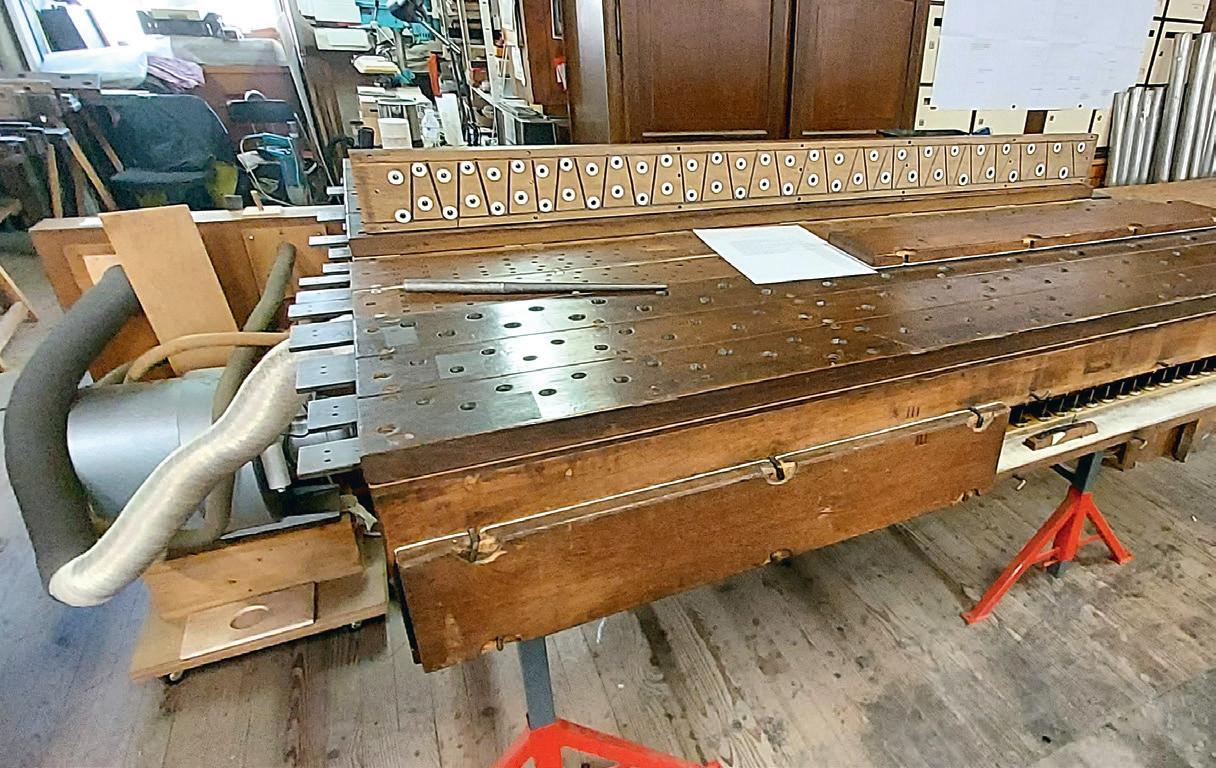
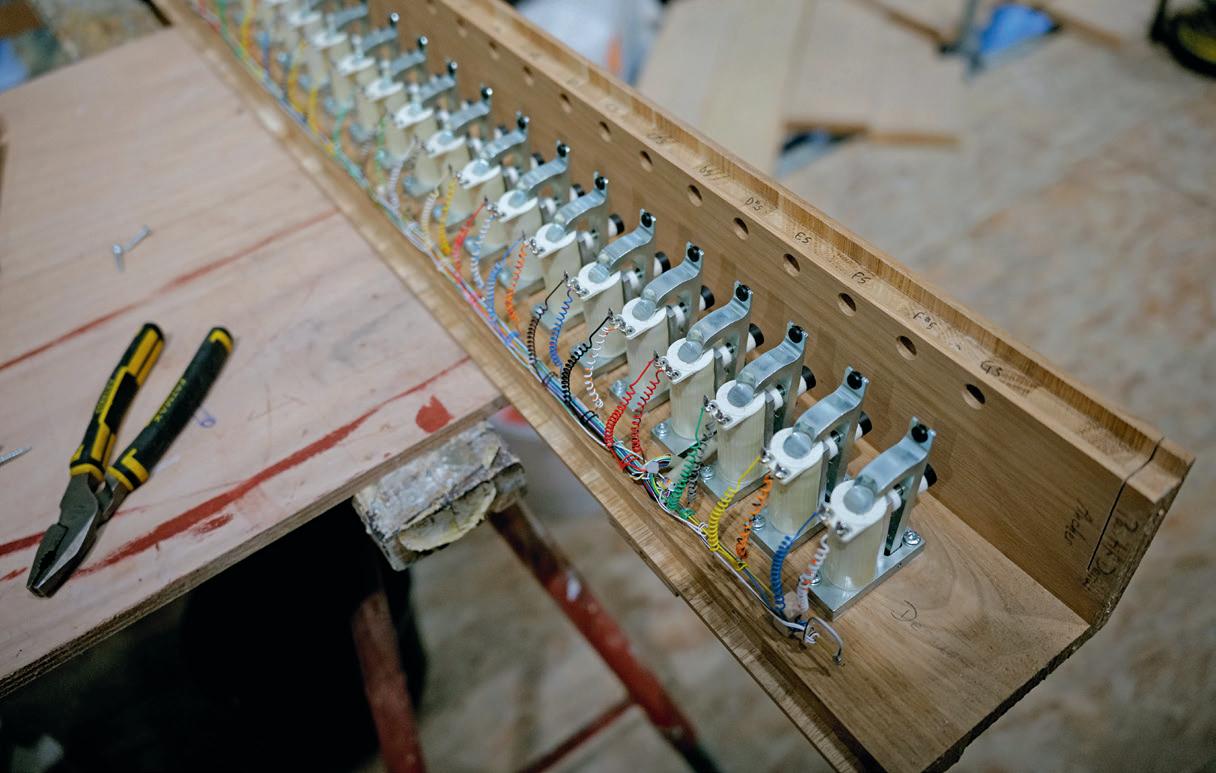
1402: Frédéric Schambantz
1415: Jean Chabancel
1458: Jean Bourdon
1476: Jean Robelin
1540: Pasquier Bauldry
1564: Nicolas Dabenet
1609, 1610, 1617 and 1620: Valeran De Héman
1636 and 1646: Pierre Thierry
1672: Jacques Carouge
1691: Alexandre Thierry, Hippolyte Ducastel
1730–33: François Thierry
1784–88: François-Henri Clicquot
1812–13: Pierre-François Dallery
1833–38: Louis-Paul Dallery
1863–68 and 1894: Aristide Cavaillé-Coll
1902: Charles Mutin
1932: Société Cavaillé-Coll, under the management of Joseph Beuchet
1959–65: Jean Hermann
1965–75: Robert Boisseau
1989–92: Boisseau-Cattiaux, Émeriau, Giroud, Société Synaptel
2012–14: Bertrand Cattiaux, Pascal Quoirin
2021–24: Atelier Bertrand Cattiaux taken over by Olivier Chevron; SCOP Quoirin, under the management of Laurent Mesme; Manufacture languedocienne de grandes orgues, under the management of Charles Sarélot
A fresh chapter in the cathedral’s history began in November 2021 with the arrival of a new Dean, the Very Revd Abigail Thompson, who moved from St Albans Cathedral to take up her new role. She was a familiar face in the diocese; she was both ordained deacon and married in the cathedral, was a vicar in Rotherham for eight years and was Dean of Women’s Ministry on the Bishop of Sheffield’s staff team from 2015 to 2018.
Dean Abi, as she is known, is also a gifted singer and pianist. As a teenager she was a member of the renowned Cantamus Girls’ Choir in Mansfield, Nottinghamshire and she graduated in music before training for the priesthood, so she was well placed to oversee the rebuilding of the cathedral’s music department. She says, however, that her work as a parish priest, which took her into a number of housing estates and state schools and allowed her to see how few musical opportunities were then open to the children of South Yorkshire, was in some ways more influential in how she approached the task. By November 2022 she was ready to announce a new vision for the foundation, which would have children at its heart, in partnership with the National Schools Singing Programme (NSSP) and with Sheffield Music Hub; a few weeks later the cathedral advertised for a new Director of Music and Schools Singing Programme to lead its implementation.
Enter Tom Daggett, who when the advertisement appeared happened to be on a mini-sabbatical from St Paul’s Cathedral, London, where he had been OBE Organ Outreach Fellow for nine very active years. As well as promoting the organ, he had launched a music partnership programme for schools, working with 3,000 children each year in diverse inner-city communities, and established Sing at St Paul’s – choral workshops for school choirs to prepare them for recitals and services in the cathedral. Was he head-hunted for the job at Sheffield? ‘No,’ says Daggett, ‘it was a wonderful coincidence. The cathedral had been on my heart for a number of years – I read the first sentence of the role description and I had a very strong feeling that I wanted to do this.’ The partnership work he had helped to set up at St Paul’s was securely embedded in the work of the music department there, and was ripe for being handed over to somebody else to continue; and on a personal level, after twelve years working in London he was ready to return to his native Yorkshire.
‘It seemed as though it was the right time, the right place and the right context. I knew the situation in the aftermath of the pandemic and everything else that had happened would need really careful handling, but also a pastoral heart to make the music here tick again – which is really what I’ve been doing as a musician for the past ten years, putting communities and people at the centre [of church and cathedral music].
‘I care deeply about unlocking new pathways into choristership, and the Dean and Chapter of Sheffield articulated a clear and ambitious vision for music with creative breadth and energy. I had a strong sense of calling to be here.
‘It’s an important and an exciting time to be leading the music at Sheffield. The Director of Music and Schools Singing Programme role requires me to take a holistic view of what music is about and what the constituent parts look like. It’s not only about making great music for our liturgy, and it’s not just about education; rather it’s about holding together a huge number of competing interests as to what our space is for and who we are.’
For example, he cites the Yorkshire Miners’ Memorial Service, ‘one of the most moving services I can remember,’ attended by people who had lost their fathers or brothers in mining accidents, or who had campaigned for miners’ safety, some of whom laid wreaths in front of a lit miner’s lamp on the altar. Musicians taking part included the Dodworth Colliery Band, many of whom had been involved in mining themselves.
‘That really brought the space alive. As Director of Music I’ve got to give just as much priority to people like them as to choral scholars, professional singers, choristers or prospective choristers, children in schools, head teachers, or members of the choir we had here previously. So there are lots of aspects of the work that necessitate a sensitive and pastoral approach, which I believe will allow us to build something exciting here for generations to come.’
Daggett was appointed in March 2023, and before taking up the post later that year he spent as much time as he could in Sheffield, getting to know the community. This included attending the first service of the Steel City Choristers (SCC) as guest choir at the cathedral; SCC is an independent choir of children, young people and adults that was formed after the closure of the cathedral choir, as a social activity and to maintain the children’s musical education and vocal
‘We are a place for people who need to come in and light a candle because they’ve lost a loved one, often in tragic circumstances’

development. It has grown into a thriving organisation which gives concerts, runs community workshops and sings services at different churches in the city and increasingly in the surrounding area. SCC was awarded charitable status in September 2021. Eleanor Jarvis was appointed as music director in May 2022; the legendary singing teacher and conductor Vivien Pike is vocal coach; Kate Caroe, whose family was closely involved with the Sheffield Cathedral choir, chairs the trustees. Membership of SCC is free and it is supported by fundraising activities and by grants from various trusts and foundations.
‘They have been doing wonderful work,’ says Daggett. ‘It’s been great to get to know them over the past few months, as a sign of where we are and what I want our relationships to be like.’ SCC sang with the cathedral choir for the first time in Epiphany, and will be returning later in the year. ‘Those two moments for me are things of rejoicing, that we are in a new chapter, a new phase of our life here.’
How does one person cope with the wide range of responsibilities involved in leading Sheffield Cathedral’s reimagined music programme? Importantly, Daggett says he has a strong and honest relationship with Dean Abi, who is his line manager, and has given him the executive autonomy to take decisions quickly, particularly in relation to the schools’ singing programme.
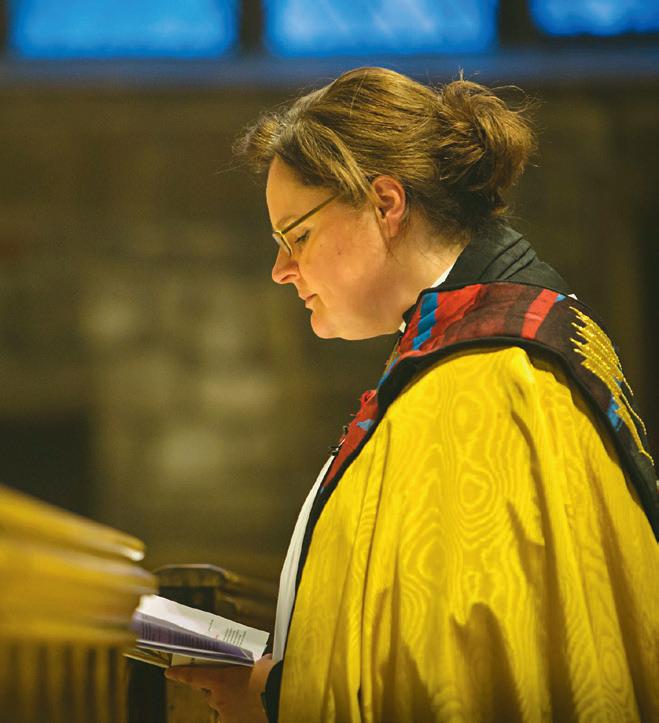
means that people need to be responsible for their own areas.’
Daggett’s aim is to build a team of people who understand and share the vision and the drive to make it happen. ‘We do have significant pressures, with our everincreasing numbers of services and with the breadth and diversity of the people for whom we’re a platform. My role is to work out how we plug in the missional work we’re doing through music across the diocese directly to the cathedral choir and our life and musical ministry – those things need to work handin-glove.’
Practising what he preaches, he drew up a role description with a similar level of independence to his own for the post of Cathedral Organist and Head of Keyboard Studies, which is supported by Cathedral Music Trust. James Mitchell joined the music department from Gloucester in September and has responsibility not only for playing for cathedral services and organising recital and organ festival programmes but for catalysing a Keyboard Studies programme, inspired by the model in the Diocese of Leeds and, in due course, leading plans for commissioning a new cathedral organ.
His particular enthusiasm is for contemporary music of all styles, and his book The Pipe Organ: A Composer’s Guide has recently been published by Oxford University Press [and is reviewed by Imogen Morgan on page 64 of this issue].
ABOVE LEFT
ABOVE
‘Dean Abi and I share similar backgrounds and we both believe that music gives us a depth of encounter that changes the whole course of our lives, something we want to see unlocked in other people. We’re both pulling in the same direction, which is a very helpful thing for a Dean and a Director of Music to be able to say. I’m a collegiate person who believes in institutions working well and that
‘James has a vision for collaboration with the organ as an instrument which includes artists from wildly different genres, be they bands or jazz musicians,’ says Daggett, ‘and he’s keen for the cathedral to encourage people to hear different instruments and young musicians to go and play them. He has been a breath of fresh air for me in terms of the organ world and he’s also a great
accompanist, a very good player and a strong colleague.’
For the past few months the music team has also included James Caroe, a former chorister of the cathedral and member of the Steel City Choristers, who was appointed as Junior Organ Scholar in January. A second Junior Organ Scholar, Chiara Nel, has since been appointed, sharing responsibilities for assisting at the console, singing, and playing with James.
Rebuilding a traditional SATB choir including a team of trebles will be a slow process; for the moment Daggett is working with a combination of local professional singers and choral scholars, four of whom he appointed within his first month, with a remit to be involved in delivering the schools programme and the development of new toddler music groups and children’s choirs, as well as singing services. ‘One of our sopranos, Beth Winter, is a brilliant singer but also a secondary school teacher who now has a business bringing really high-quality toddler music groups to different parts of the region. She now runs two Rhythm Time family music sessions in the Cathedral on Thursdays, which have proved so popular that we’re already in the uncomfortable position of having to turn people away. The place is flooded with the sound of toddlers beating drums and mums and dads or child-minders singing and moving together joyously, and then enjoying lunch in the cathedral café. We’ve also started a Little Lights choir for four- to eight-year-olds.’
Initiatives like these, he says, may turn out to be the seedlings for future choristerships. He describes a visit by the Duke and Duchess of Gloucester at which the cathedral choir sang with thirty children from a primary school on a local estate, ‘so anybody looking from afar and projecting their own thoughts about what we should be doing would be assured, I think, that we are already doing things in the right way, with huge potential for growth. My expectation is that all our musicians would see themselves as having a vocation here, which should include sharing the gifts of music with others who haven’t yet had the chance to experience it.’
Asked to talk more specifically about the diversity of Sheffield’s population and how the cathedral reaches out to communities of all faiths, Daggett first cites work in schools that have hitherto suffered from a dearth of musical opportunities. One example is Hucklow Primary School, situated next to the Northern General Hospital, which is
predominantly Muslim but also has children from Orthodox Roma families, a small number of Pentecostal Christians, as well as children from no faith background. ‘One small Yamaha keyboard from 1990 is the only musical instrument they have access to, so we are breathing musical life into that group of children and adding some cultural capital to that great breadth of religious or ethnic identity, inviting them for example to give a Christmas performance in the cathedral for their parents. The diversity of the audience was obviously as strong as the diversity of the children.’
Daggett goes on to talk about the Archer Project, an award-winning homelessness service based in the cathedral crypt with a GP, a dental service and a bank of clothing and daily food provided and all manner of support from immigration to mental health – and, crucially, skills development, to take people who have come off the streets and give them some agency in their own lives. ‘For example, they might be given a job in the cathedral canteen and progress to the kitchen and on to becoming a team leader. What’s been missing up to now has been a musical element, so we trialled an Archer Project choir at Christmas that met on Wednesdays just before people had lunch – we took requests, and I brought some upbeat songs. This is a key priority for me, and I’m working with the Chief Executive, Tim Renshaw, to explore long-term partnerships with various arts organisations.
‘So within a week we can have people making music in the cathedral who have come through homelessness or experienced serious poverty or limited life chances, and at other times we host the Cutlers’ Company events, where the business and civic leaders from the region come together and use the space for special services or champagne receptions. What’s wonderful for me is how we can be authentic as a cathedral to all of those groups.
‘We are a place for people who need to come in and light a candle because they’ve lost a loved one, often in tragic circumstances, or where people who have had to leave their families in a different part of the country come and find solace and good conversation. That might be a conversation with me about their favourite rock band or about the fact that they don’t see their children any more.’
That brings us back to the cathedral’s strapline. ’Yes,’ says Daggett, ‘this is “a place for all people”. I can really see it happening.’
The much anticipated rebuild, by Harrison & Harrison, at Norwich Cathedral merges new pipework into a restored tonal palette with brilliance
By STEPHEN FARROver the course of the twentieth century, the organ of Norwich Cathedral underwent an eye-opening – and for contemporary listeners, probably ear-opening – transformation. From the relatively modest Norman and Beard instrument in place at the turn of the century (around sixty speaking stops, including an Echo division) it had become, after the Hill, Norman and Beard (HNB) rebuild of 1938-42, an instrument of more than 100 stops (the Echo of the 1899 instrument now disconnected). Around half of the pipework of this organ was new. By 1970, after further work by HNB, the instrument was essentially two organs, facing in two directions, and arguably attempting to marry two mutually exclusive approaches to tonal design. Facing
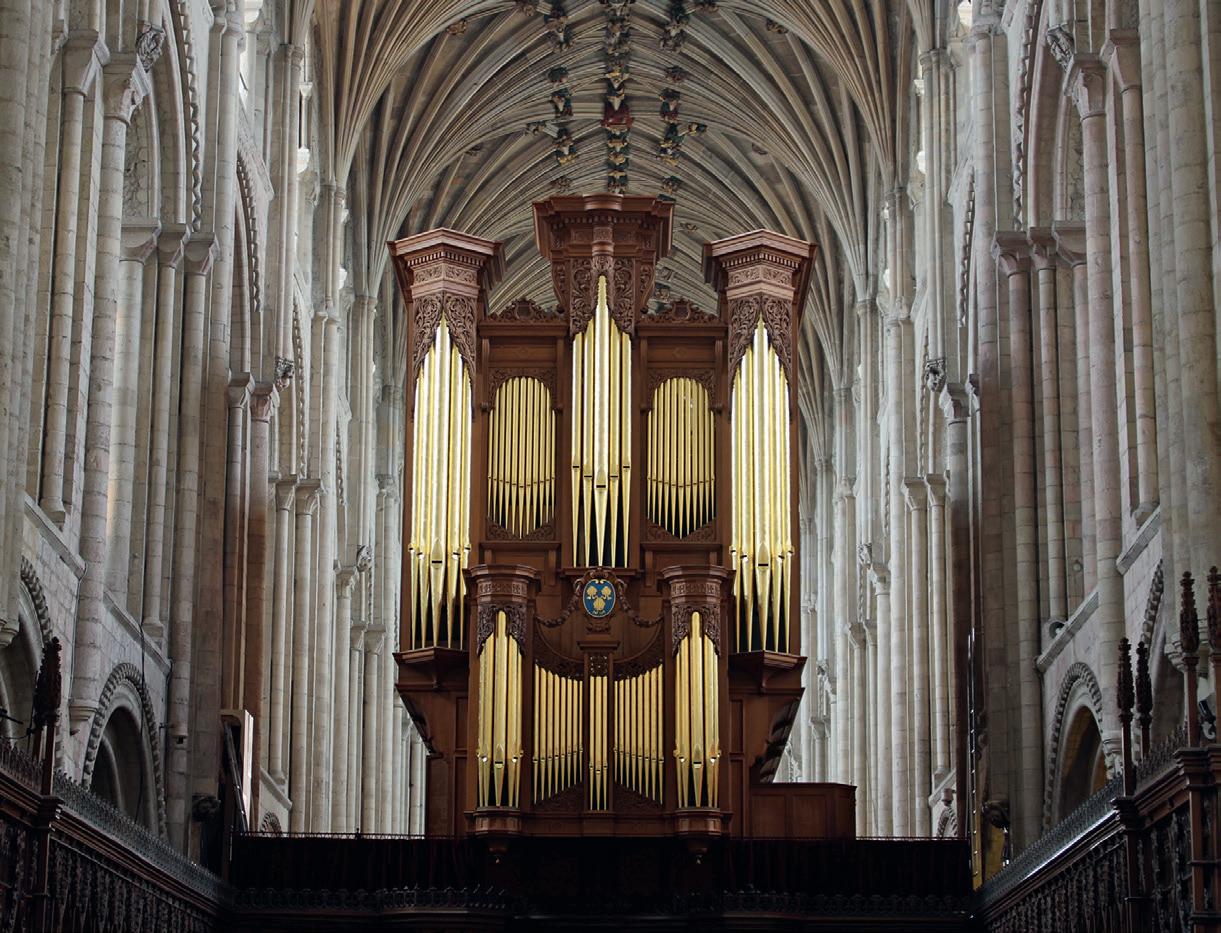
east was a small two-manual organ for choral accompaniment purposes, with an enclosed Choir–Swell division and a Baroque-style Positif. Facing west were the Swell and Solo (this latter division further demarcated acoustically by an internal wall inside the case, barring egress of sound towards the choir stalls), two Great divisions (one on the screen and one in the north triforium, the screen Great voiced with a strong tendency towards the neo-Classical and the Primary Great in the triforium leaning more towards the traditional). The whole was completed by a large Pedal division which made generous use of borrowing and extension.
In this incarnation, the instrument presented notable challenges of internal balance and overall cohesion, despite its many rewarding aspects; it was in many ways a rather baffling organ. Post-1970, the voicing of the newer chorus work (and in places the revoicing of existing stops) sat uneasily with the still substantial amounts of earlier HNB material, and the placing of divisions within the screen case (the notably elegant creation of Stephen Dykes Bower, 1950) resulted in severely limited options for choral accompaniment, which of course remained the main function of the organ. The westfacing divisions of the instrument were of limited usefulness in the eastern half of the building; the east-facing divisions offered too limited a palette of timbre and dynamic range; and the Pedal could overwhelm unless used with extraordinary discretion.
By the end of the twentieth century, as the instrument began to show inevitable signs of age, it became increasingly clear that these
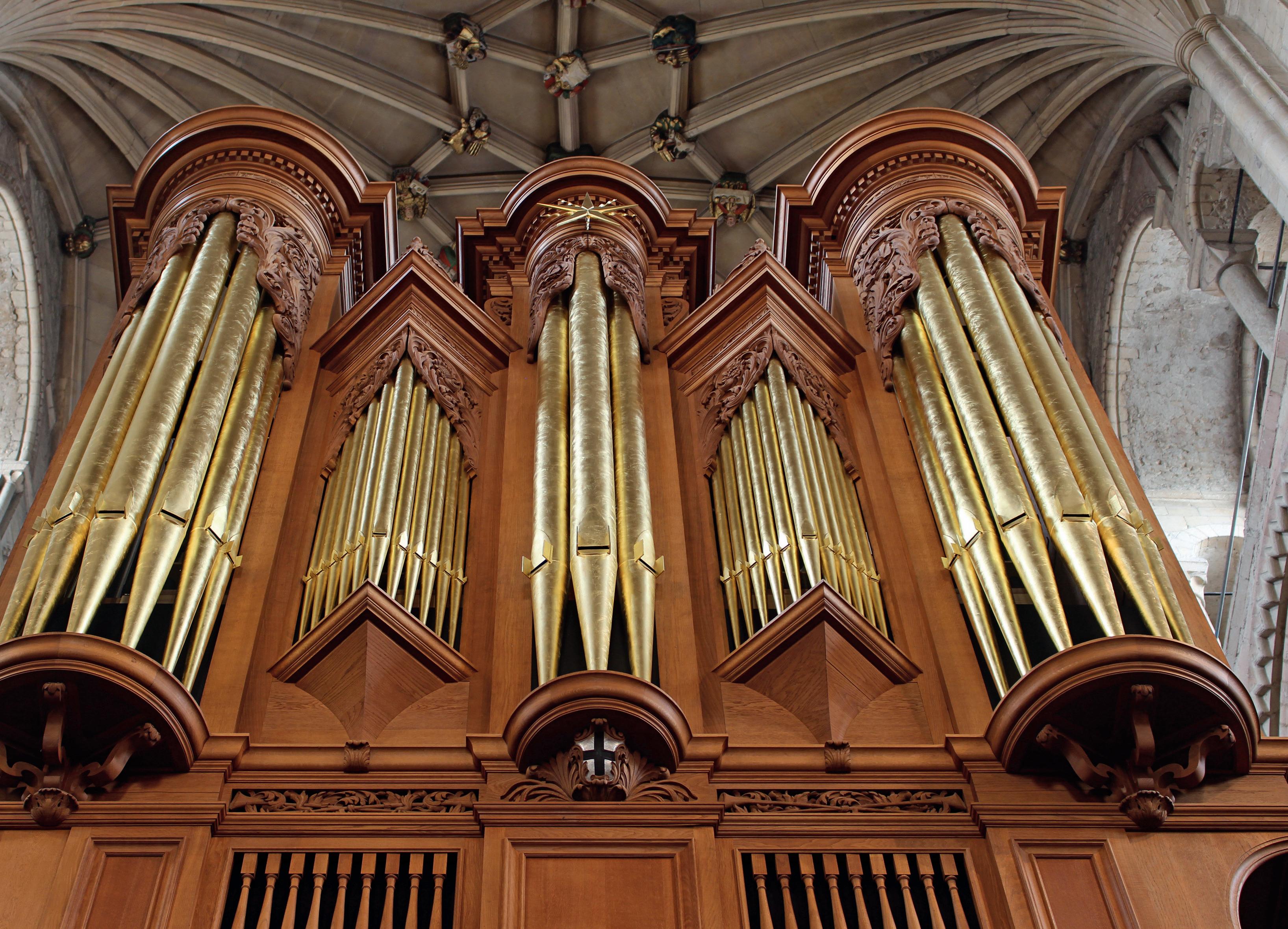
issues needed to be addressed if the instrument were to meet adequately the increasingly varied demands placed upon it.
The cathedral musicians (Ashley Grote, Master of Music, and David Dunnett, Organist) and consultant Dr Nicholas Thistlethwaite developed in consultation with Harrison & Harrison a creative but conservative scheme the aim of which was to improve the blend and projection of the whole instrument, while preserving the distinctive HNB timbres which were an important part of its still impressive effect.
The H&H team, collectively responsible with other colleagues for the resulting transformation of the organ, should be named at this point: Jim Reeves, team leader; Andrew Hale, head designer; Owen Woods, projects manager; Andrew Scott, pipe scaling; Andrew Fiddes and Daniel Rose-Jones, voicing; James Richardson-Jones, blower refurbishment, wiring and Cymbelstern; Robert Woodland and Debra Miller, gilding. Judged by the evidence of an evening spent on the instrument at the very end of 2023 (with the integral iPod recording device to assist assessment of the organ’s effect in the
building) the rebuild has been notably successful in achieving its aspirations. There have been (horribile dictu for some, perhaps) judicious and apposite tonal alterations – of which more later – but these have been conceived in tandem with another fundamental change: namely, the major realignment of the organ’s internal layout. The screen Great and Swell soundboards have been turned through 90 degrees; these departments now speak far more clearly in the east of the building and are at last brought into play as fully viable resources for accompaniment. The ‘roof’ over the screen Great has also been removed (its introduction was perhaps inspired by the tone cabinets of the 1960s, and design aspects of the Royal Festival Hall instrument). Ironically, this roof had the reverse of its intended effect of improving projection of sound; in reality, it prevented the division interacting optimally with the stone vault which runs like a spine along the building. This aspect of the instrument’s relationship to its acoustic environment is now greatly enhanced.
The flexibility of both Swell and Solo is much increased by the provision of two sets
ABOVE The 1950 casework (viewed from the west), arguably the finest of its type, is invigorated with freshly gilded pipework
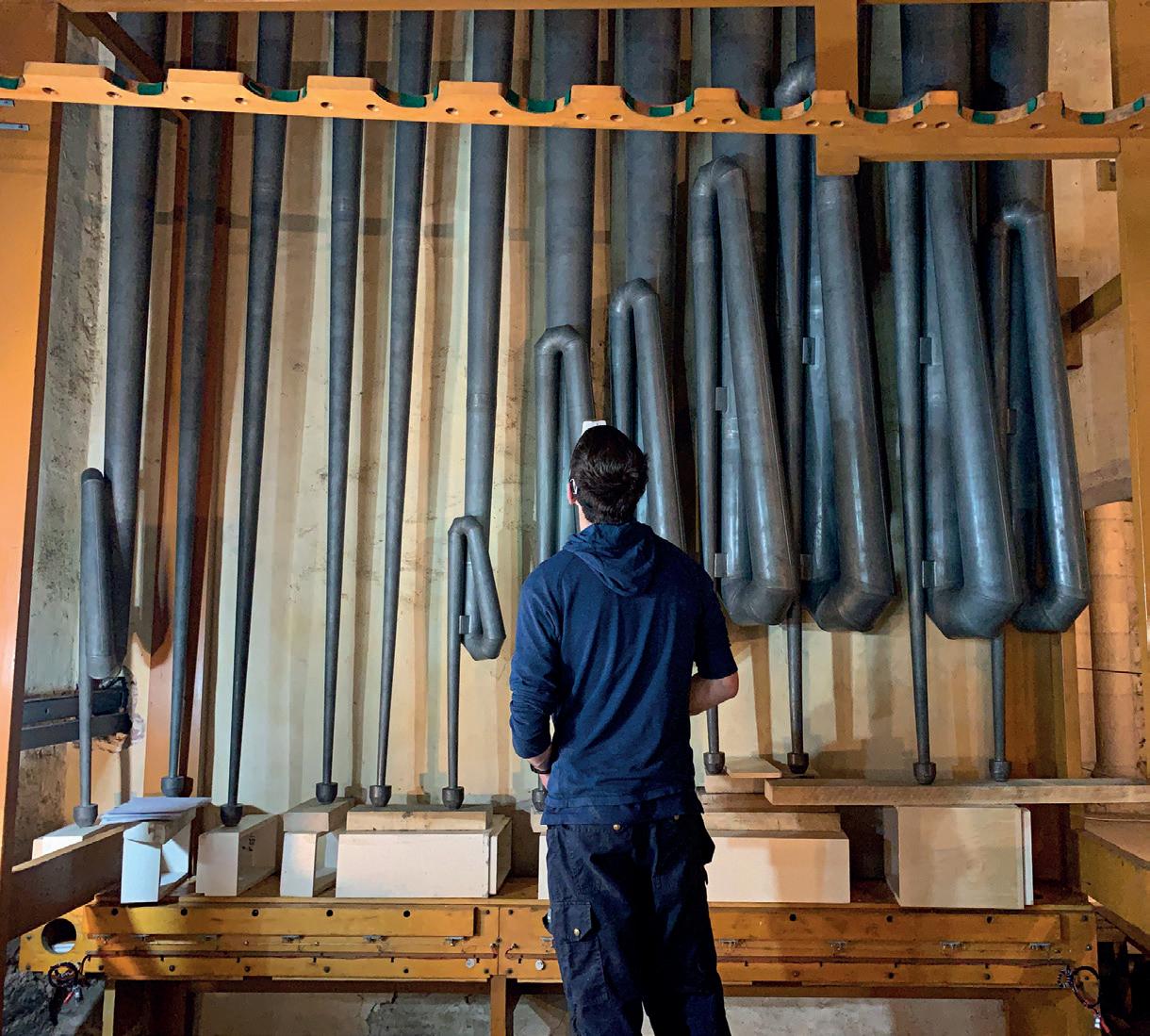
ABOVE David Beeby with the 32ft Ophicleide
OPPOSITE, ABOVE Grand and Pedal pipework in the north triforium OPPOSITE, BELOW
Voicer Andrew Fiddes with the Solo Contra Viole
of shutters for each department (facing west/north and west/east respectively), whose operation can be selected independently by drawstop. This nuance of design creates an additional reflective surface within the case – the non-operative shutters close when the relevant stop is selected – and allows the sound of each to be directed most effectively, opening up possibilities for creative use of the divisions’ position within the case. This was demonstrated to fine effect in a recent BBC Singers concert, when Ashley Grote (accompanying the choir on the west side of the screen) used the east Swell shutters rather than the west. This allowed use of full range of the division’s dynamics without overwhelming the singers and produced a striking sense of additional space and ‘bloom’ around the sound.
rather over-assertive Sharp Mixture removed. The Horn and some 8ft fluework has been revoiced; the 16.8.4 chorus reeds, Sesquialtera and strings are new. The Vox Humana has been transferred from the Solo and revoiced for its new position.
Pedal: new 8 and 4ft principals and Twelfth, and Mixture partly new, and provided to match the new screen Great chorus; Swell Double Trumpet 16 now available by borrowing.
Grand (previously Primary Great): pipework revoiced, with Harmonic Clarabella 8 added (revoiced Solo Harmonic Flute 8). Cymbelstern revoiced.
Great (screen): completely new, with some repurposing of existing pipework (Stopped Diapason taken from old Secondary Great Gedeckt 16, revoiced; Geigen 16 is from old Swell Geigen 16 revoiced; Cornet V existing register, revoiced).
Choir: new, except for Lieblich Bourdon 16, Open Diapason 8, Viole d’Amour 8, Gemshorn 4 and Fifteenth 2 (these originate in existing Choir–Swell and Positif pipework, in part revoiced). Great Primary Quint repurposed in part for Rohr Flute 8.
Stephen Farr is an internationally active recitalist, accompanist and continuo player, with a discography that extends from the sixteenth to the twenty-first century. He is Director of Music at All Saints Margaret Street in London, and Chief Examiner of the Royal College of Organists
Turning to matters of tonal design –inevitably more controversial – a substantial part of the builders’ work has been to repair and tidy existing pipework, with new pipework introduced only where existing resources were not viable for reuse. Only the Positif and Secondary Great have been (almost) entirely removed from the instrument. Division by division, the main changes are as follows:
Solo: the French Horn is new, replacing a famously capricious and much revoiced register. The Harmonic Flute 8 is likewise new, and there has been some revoicing and regulation of soft orchestral reeds.
Swell: the Mixture has been recast, and the
The most far-reaching tonal change is self-evidently in the provision of new screen Great and Choir divisions. These introductions seem on the basis of (a) a brief but thorough test drive, and (b) in-recital experience with their previous equivalents, to be entirely successful. They offer, as a starting point, a wide range of blended and internally balanced chorus combinations, underpinned in archetypal plenum combinations by a Pedal division which allows a wide range of dynamic shading (two enclosed 16ft Pedal reeds do not seem a luxury in this context). The screen Great chorus now speaks clearly and supportively into the choir stalls, while the triforium Grand keeps its assertive – indeed, thrilling – character, but with revoiced reeds whose speech reflects rather less of the county’s proud agricultural heritage than was perhaps previously the case. The effect of this division is not confined to the nave: it adds perceptible weight and brilliance to the sound east of the screen as well and the tutti is magnificent in effect. The provision of a substantial flute, which does double duty as a solo stop of great lyricism to the east of the screen, is an inspired stroke.
‘Visually, the instrument is restored to full magnificence’
The Choir division is an equally welcome newcomer. Mutations and reeds (the Trompette 8 is ideally scaled for the space) allow the mixing of much subtle colour (the Cornet offers a distinctly different timbral experience to the winsome new Swell Sesquialtera, but of equal finesse) and the division speaks into the surprisingly confined choir stalls with what seems to be a perfectly calibrated balance of intimacy and clarity, even when the full chorus is drawn. Harrison & Harrison’s approach to the marriage of older and newer material is at its most subtle here; the inclusion of the Viole from the previous organ adds characteristic colour to flue combinations, sitting so perfectly within the sonic character of the new pipework it seems they were always together.
It goes without saying that the console design is elegant and uncluttered. It’s both amusing and oddly salutary to have a reminder of the epic dimensions of its predecessor, whose outer wooden frame remains in position, and of which the location of the Swell Clarion drawstop somewhere near Birmingham (or so it used to seem) was such a characteristic feature. Mechanically too, the instrument satisfies; playing actions are crisp and clean, allowing enough rapidity of repetition to make the Duruflé Prélude et Fugue sur le nom d’Alain easily manageable, and electrically assisted swell boxes helpfully still offer the essential ergonomic feedback of mechanical systems.
Visually, the instrument is restored to full magnificence, with the regilding of the case pipes in the exquisite proportions of the case especially resplendent. Many regard the 1950 Norwich case as one of the finest of its type; the instrument now housed within it provides a suitable aural foil to that elegance of proportions, and a musically well-reasoned symbiosis of newer and older approaches.
An extended version of this article was originally published in the Spring 2024 issue of Choir & Organ.
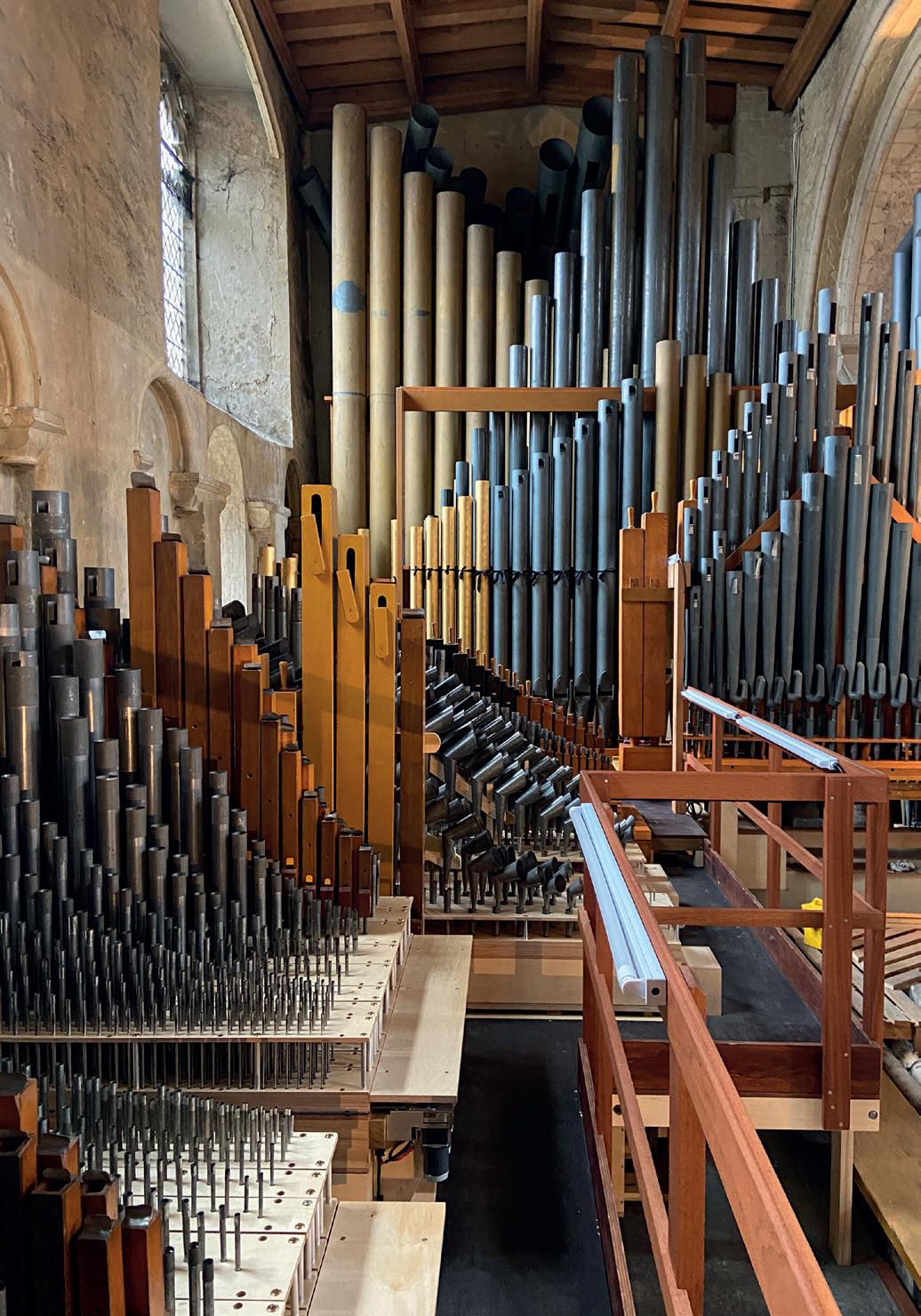
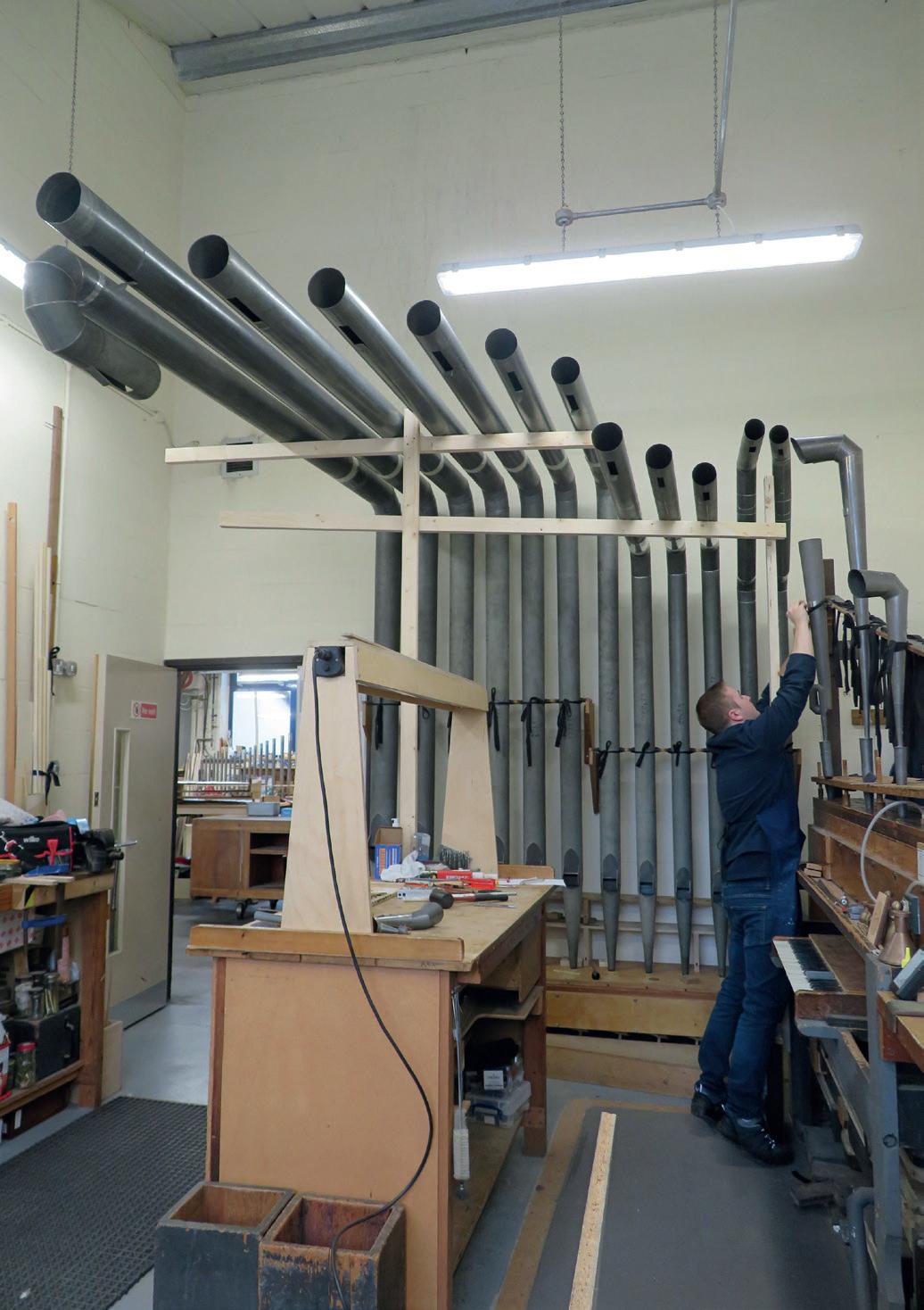

In his work for unaccompanied mixed choir,
uses imaginative vocal effects to create a dream-like atmosphere
By MATTHEW POWEROriginally aiming for a career in the film industry, and beginning a degree course in film studies, Marcus Rock soon recognised the precarious nature of artistic control and its reliance on many collaborators and backers. When one of these fails, your artistic intentions are unfulfilled. Rock took a leap of faith, left his film course and pondered how, with little more than a keen interest in music and no formal training, he could enter a conservatoire.
Needing to create and submit notated scores required theory lessons and as much practice at composition as he could get. ‘My musical intentions became more intuitive,’ he recalls, and after applying to the Royal Birmingham Conservatoire (RBC) he was offered a scholarship. Now in his fourth year there, he has studied with Sean Clancy, Andrew Hamilton and Edwin Roxburgh. ‘They’re drastically different creatively, but constantly supportive and generous.’ Rock has also taken part in external programmes including the Cheltenham Music Festival Composer Academy (2022) and has written pieces for players from Chineke! and the London Symphony Orchestra.
Last year he won a place on the BrittenPears Young Artists’ Programme, with mentoring from Colin Matthews and Mark-Anthony Turnage. ‘Again, very lovely, generous people. It’s an intensive and enjoyable course, and rather than stepping on the composers’ toes, they were just there looking over our shoulders and providing support. “How are you doing? How do you feel?” And I can reach out to them whenever I need to.’
At the Red House, Rock benefited from the camaraderie of living alongside the other composers while they all worked on their own scores. ‘We pulled an all-nighter on the final day to get things finished. Although our work is very different, we all understood each other. Being a composer is so often solitary, so it was lovely to know that you’re never really that alone, and afterwards we all kept in contact.’
His creative process varies. ‘I’m a synesthete. So initially I start with sketches; I write down instrumental combinations or textural characteristics, depending on the instrumentation. For the orchestral work that I’m writing now, I have pages of combinations
and colours and textures. Sometimes I will sketch an idea on paper as a cross-section of how that could look in a larger setting. Before I go to the notation software, I make sure I can hear every technique or harmonic or melodic change, and what the timbre of the instrument is going to sound like in a live setting.’
A self-cognisant assessment of his music brings Rock’s compositions into two categories (internal and external). ‘Internal’ descriptors are: ‘chamber of emotion –impulse, desire, uninhibited’ and ‘chamber of thought – logic, constructed, ideation’.
Acidic Considerations (2020) for solo flute uses extended playing techniques with boundless energy: there is an animalistic sound to the breaths and drumming on the keys; the combination of these elements with expressive melodic writing reminds me of the way J.S. Bach implies a harmonic dimension to the melody of the cello suites. The solo flute sounds more like a chamber ensemble. ‘I was thinking about polyphony with a single instrument and how I could split up the technical capabilities and the registral characteristics of the flute to create a dialogue. I mapped a typical characteristic or a melodic feature to a tempo and then switched tempo and changed the characteristic. So it was, as you say, another way of exploring polyphony.’
Shadow Mania (2022) for violin and cello also has a sense of dialogue and a vividity to it. ‘That word – vividity – does characterise how I think about music. I’m glad that comes through because this immediacy of the writing is important.’
Conversely in Rock’s catalogue, ‘external’ expressions are: ‘extrinsic episodes –external realities, future, past and present’ (these are longer pieces). Soul Shards (2020) for string quartet has an expressionistic beauty. It’s a fifteen-minute single movement, written as Rock was coming to the end of his first year at RBC. What can he say about its form and language?
‘It’s an external narrative where these shards – episodes of recurring material –sometimes change, sometimes remain the same. They are sections of harmony and texture which never complete their arc but are interspersed and spliced together.
‘I’m a synesthete ... I write down instrumental combinations or textural characteristics’
Matthew Power works in London as a musician and writer; he is Organ & New Music Editor of Choir & Organ
‘I try to be true to what the piece requires rather than imposing what I want’
I imagined a single person sitting still and the entire atmosphere constantly changing around them. Each atmosphere is in its own grounded place. So switching between atmosphere A, atmosphere B, atmosphere A, atmosphere C, allowed me to build a longer arc until, at the end, some of these themes resolve.’
Death Drive (2023) for two pianos is minimalistic in texture (although with a freer central section). ‘That piece is part of a series which explores minimalism. The psychological concept of repetition leading to death made me explore how different types of repetition have different kinds of meaning. I felt that this idea of poetic death, and this kind of flickering light, a breath with shifting pulses in the music, presented a warmer perspective of this death process.’
In the preface to his piece Toe by Toe, Rock describes how, after not finding what he sought, he turned to one of his own texts from a collection of short stories. The imagery in that prose is vivid and the musical setting even more so. No extended vocal techniques are required, though imaginative scoring includes glissandi, speaking, whispering, free unconducted repetition and divisi with precise directions. Can Rock describe how the ‘oneiric’ – dream-like –sense of the music paints the text?
‘The oneiric instruction relates to immediacy of experience and immersion, like the French Symbolist idea that crossing over of the senses and experience of the object is
‘A New Song’ is a series of pieces for choir or organ by talented young composers , originally featured in Choir & Organ with support from PRS for Music. Visit
more important than the description of the object or action. My familiarity with the text made it easier to set; I knew I needed to include some unconducted narrative.’
The vocal lines are very singable and seem to come from an experienced choral composer. ‘No, this was my first choral piece, actually! I knew it was essential to sing through the individual lines – then I’d know it’s singable because I could do it. When does this person need to breathe? How are they going to approach this phrase?’ Some of the scoring may intimidate at first glance: I urge would-be performers to listen to The Marian Consort’s recording [it can be found in the introductory film on the Choir & Organ website] for reassurance and inspiration!
Looking to the future, Marcus Rock’s characteristic scrutiny of his creative direction points to ‘intratextuality’. Can he explain? ‘By creating a network of pieces, I’ll be able to, in however many years, look back and see certain similarities, creating a neural network of works that are all interrelated, not the same but connected. Not so much linear but nebular.’
Your own universe of music? ‘Yes. I still feel that I’m searching for a real voice. I hope that maturity reaches everyone in different ways and at different stages. I try not to place myself in the music that I write. Some of my pieces are minimalistic, some more melodic, others contain extended techniques. Rather than categorising myself as an aesthetic composer, I try to be true to what the piece requires rather than imposing what I want or what I think will be fashionable.’
bit.ly/3MX6vmo to register free of charge, see video performances of the pieces, and print unlimited copies free of charge. Toe by Toe is available under licence free of charge until 30 June 2024, after which copies must be destroyed as copyright reverts to the composer. The score includes the composer ’s contact details for future reference.
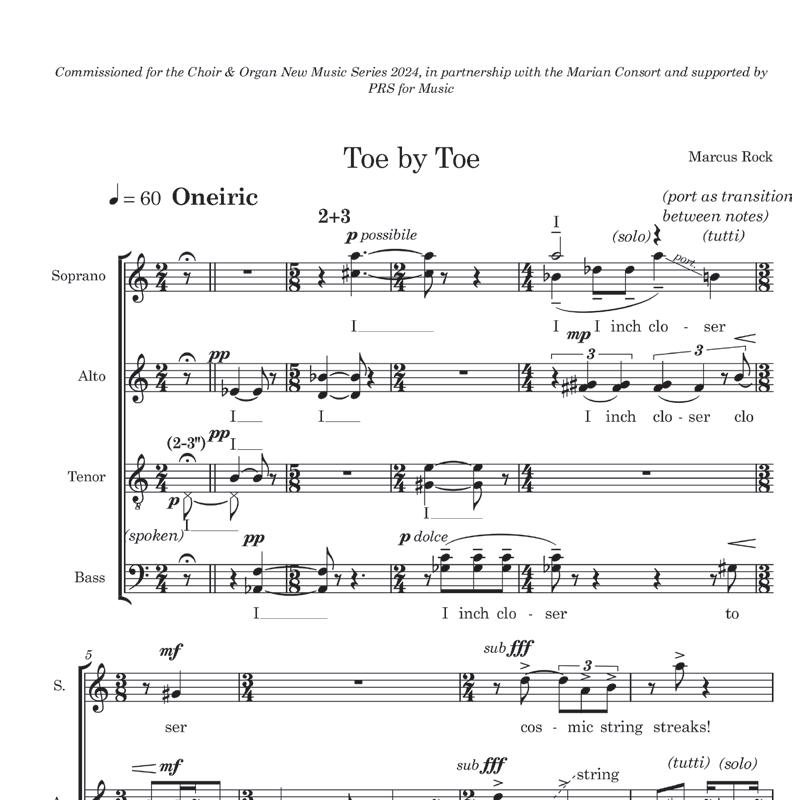
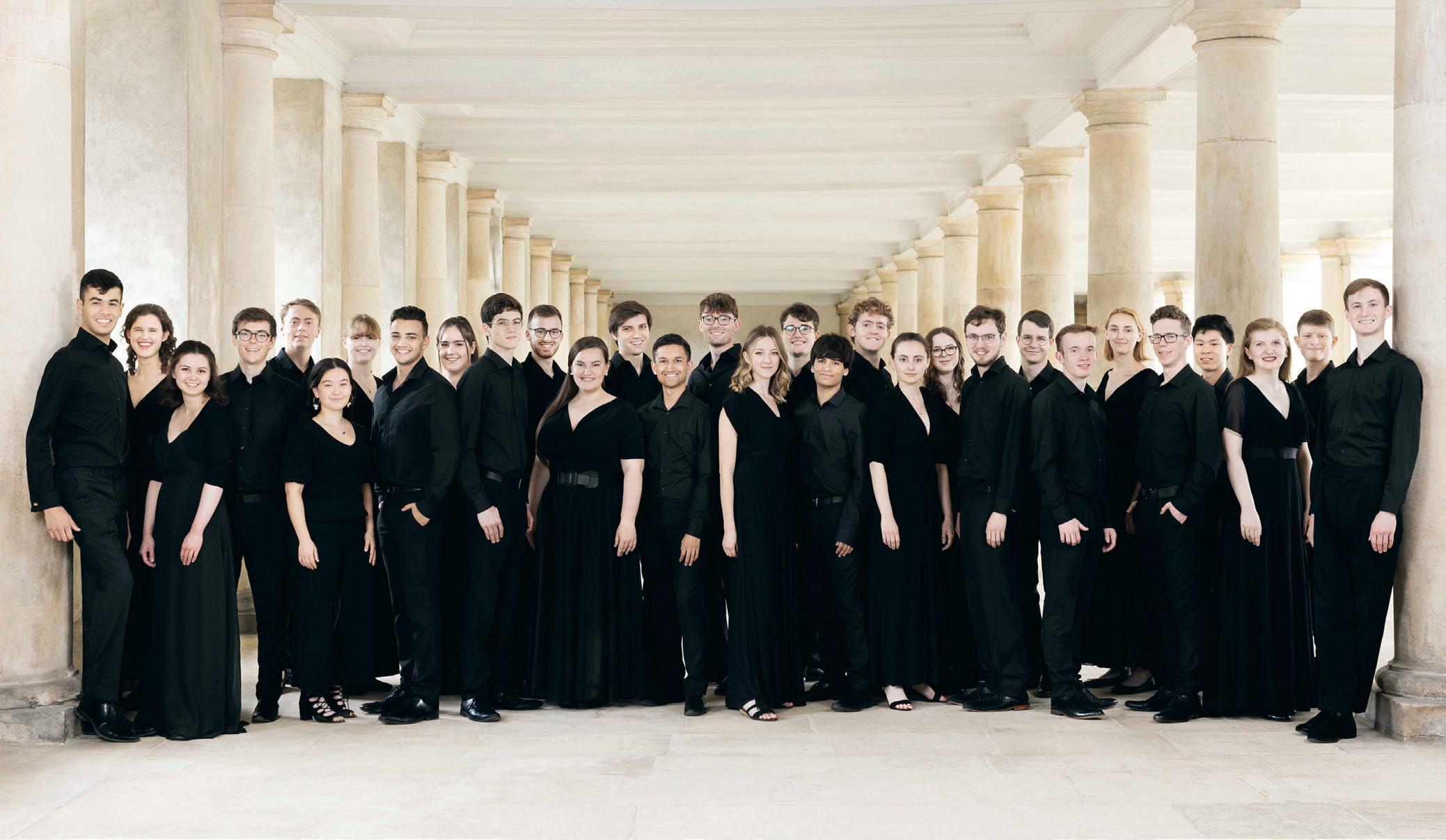
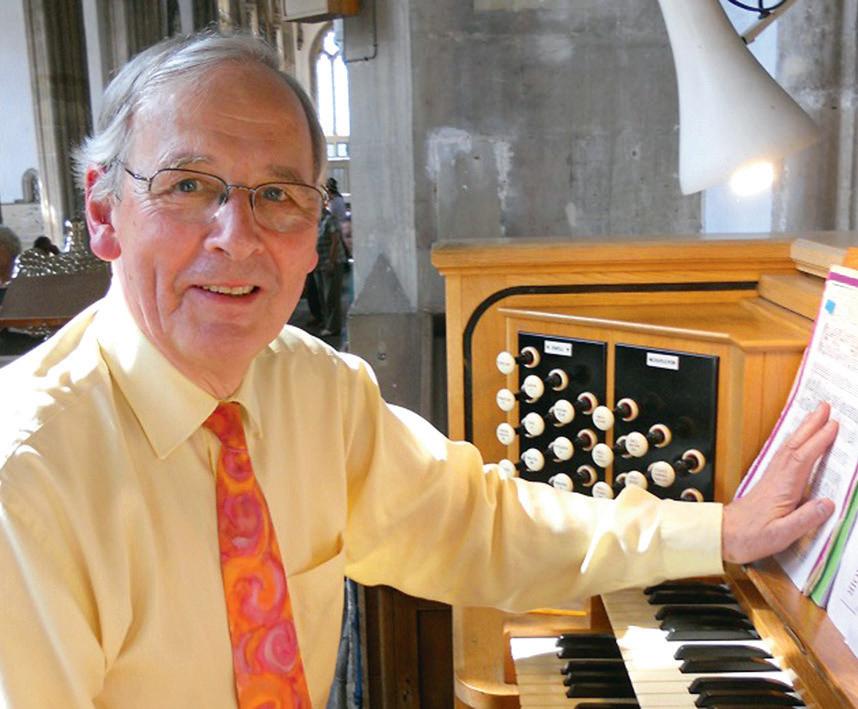
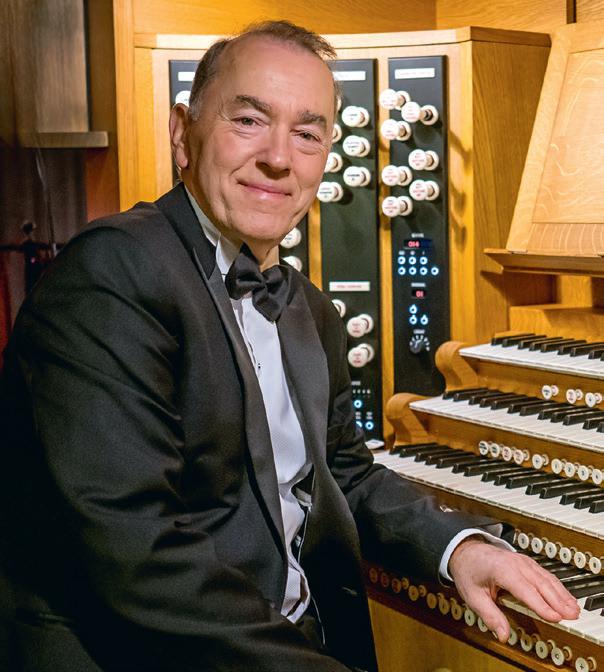
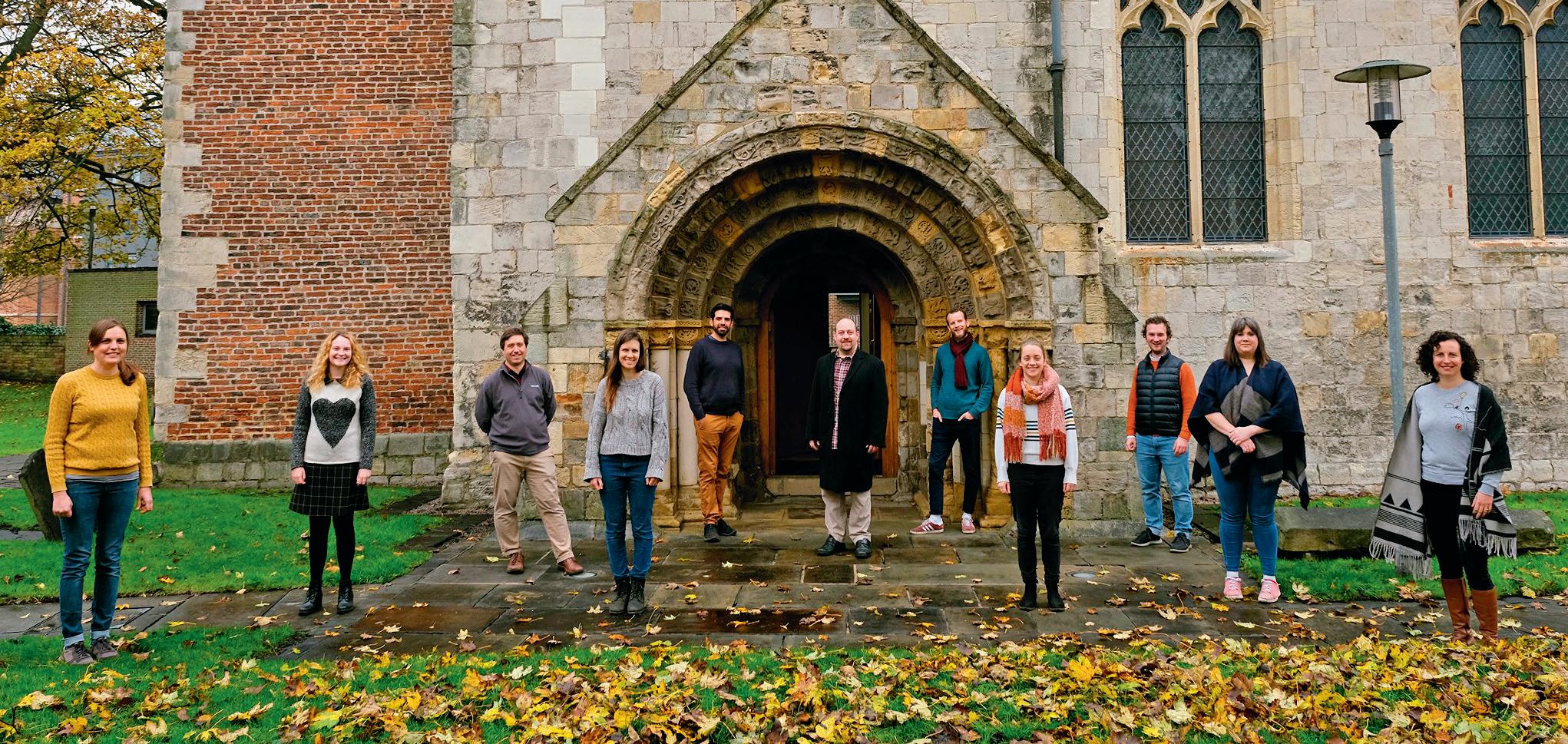
Mark
Chris
Rupert
Adrian
Bret
Imogen
Brian
Philip
Clare Stevens

Filipe de Magalhães: Masses Cupertinos, Luis Toscano (dir) Hyperion CDA68403 [76:01]
The ten professional voices of Cupertinos follow their splendid CDs of Cardoso, Lobo and Pedro de Cristo (reviewed in Cathedral Music Spring 2023) with more music from the golden age of Portuguese polyphony: two substantial masses by Filipe de Magalhães (c. 1563–1652) based on motets by Guerrero (Veni Domine) and de Manchicourt (Vere Dominus est), which are also included on this CD. As you might imagine, almost all the tracks here are first recordings.
Magalhães – who worked in Evora and, from 1623 to 1641, at the Royal
Court in Lisbon – seems barely remembered nowadays, even in Portugal one suspects, but the detailed researches of Luis Toscano, musicologist, director of the ensemble and one of its two tenors, reveal a significant figure with a distinctive compositional voice.
(No fewer than four of the ten singers here have contributed new performing editions from the original sources for this CD, which tells you much about the ensemble’s ethos and commitment.)
Musically there is much of interest, with delightful contrasts of texture - largely polyphonic but with occasional touching moments of homophony emerging at traditional places such as the Et incarnatus est. Tonality is equally varied and there is an engaging harmonic resource and feel for the tension and release of discord, an ebb and flow expertly realised by the singers with the musical rise and fall of individual lines. And it goes without saying that tuning, ensemble and balance are immaculate with this group.

Also included are two short six-voice motets and a substantial Magnificat – or rather a judicious compilation of two, which means polyphony throughout rather than the usual alternatim arrangement where alternate verses are sung to plainsong. I suppose some might miss the asceticism of plainchant floating gently in the large, resonant space of Braga Basilica, but the resulting continuous counterpoint here is luxury indeed – and it does have historical precedent, apparently.
Yet again, Hyperion’s recording engineer Dave Rowell and producer Adrian Peacock have worked something of a miracle in capturing the huge, atmospheric acoustic resonance of the basilica while ensuring the absolute clarity of every vocal line. Strongly recommended.
MARK BELLIS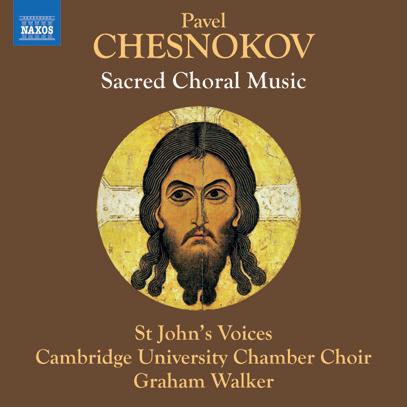
Chesnokov: Sacred Choral Music
Jessica Kinney (sop), Natalie Manning (alto), Tom Butler (bar), St John’s Voices, Cambridge University Chamber Choir, Graham Walker (dir) Naxos 8.574496 [65:42]
The Moscow-based choral conductor and composer Pavel Chesnokov (1877-1944) was responsible for 500 choral works, mostly sacred, designed for the Russian Orthodox tradition. From the Romantic opulence of his All-Night Vigil (his second account is recorded here), the most substantial work on this CD, to the
smattering of small-scale works, all disclose Chesnokov’s acute response to text and an accomplished use of texture. While perhaps lacking the last ounce of Russian authenticity to their sound, the assembled forces of St John’s Voices and the Cambridge University Chamber Choir under Graham Walker penetrate deep into this attractive corner of Russian repertoire. Their sound is gorgeously blended and resonant, aided only in part by the warm acoustics of St John’s College chapel.
PHILIP REED*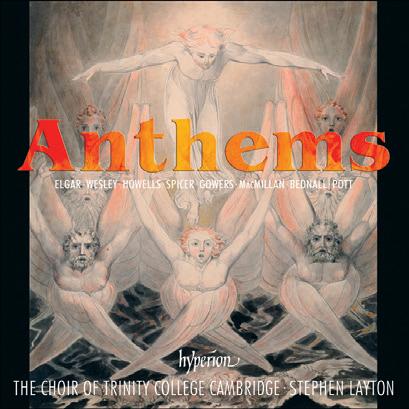
Anthems, Vol. 1
Choir of Trinity College, Cambridge, Stephen Layton (dir) Hyperion CDA68434 [78:43]
This has been something of an annus mirabilis (or two) for Stephen Layton and the Choir of Trinity College, Cambridge in terms of the number of their recording projects, with no fewer than three CDs reviewed in these pages, and another one in the pipeline: Duruflé’s Requiem and the Poulenc Lenten motets, recorded (like their Briggs: Hail, gladdening light CD) at Saint-Eustache in Paris, which promises to be a mouthwatering treat when it is released.
Anthems, recorded at Ely Cathedral, is a charmingly traditional (and none the worse for that) mix of old favourites and modern classics – all, it almost goes without saying, quite brilliantly done. The former are represented by S.S. Wesley’s famous The Wilderness – nicely realised, with secure solo work, and Elgar’s two blockbuster anthems Give unto the Lord and Great is the Lord – the latter with a lovely bass solo from Florian Störtz. Some might find the tempi in Elgar’s two late Romantic

pieces rather ‘driven’, but I loved these performances – a real whiteknuckle ride, with the thrilling (apparently) full organ (Harrison Cole and Jonathan Lee – both excellent) still not overwhelming the voices thanks to the expertise of Hyperion’s engineers.
Then comes something of a Howells rarity: The House of the Mind (1954) – beautifully realised – lyrical and Romantic – a counterpart to their previous Howells CD Collegium Regale, recorded at Coventry (reviewed in Cathedral Music Spring 2017) which some found too ‘muscular’ and lacking in atmosphere, but which I have to say I thought excellent.
The modern classics comprise Patrick Gowers’s wonderful Viri Galilaei (1987) – stunningly sung, a real highlight; Paul Spicer’s Come out, Lazar (1984) – superbly energetic; James MacMillan’s gripping O give thanks unto the Lord (2016), and David Bednall’s Everyone sang (2017) – something of a virtuosic organ ‘concerto’ with very extended range for the sopranos, but nevertheless ending the CD on an atmospheric, pianissimo note.
And we even have the treat of a Francis Pott organ work: Toccata (1991) – a ten-minute work, not his famous two-hour marathon Christus! – expertly played with an
excellent variety of registrations by Jonathan Lee.
After Stephen Layton’s departure from Trinity last summer, it will be fascinating to see how Steven Grahl puts his own mark on this prodigiously talented choir.
MARK BELLIS
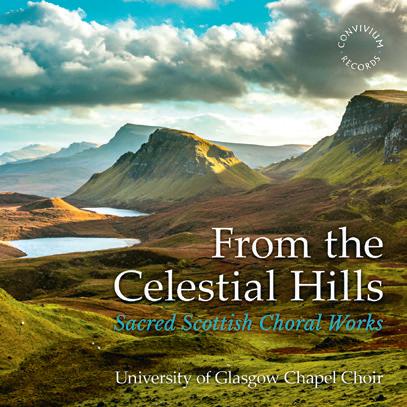
From the Celestial Hills: Sacred Scottish choral works
University of Glasgow Chapel Choir, Kevin Bowyer (org), Katy Lavinia Cooper (dir)
Convivium Records CR088 [50:55]
This programme features nearly 700 years of Scottish sacred music, ranging from ‘Aurora rutilat’, a fourteenth-century plainchant hymn for the feast of St Columba through to numerous twentieth- and twentyfirst-century works, including arrangements by Katy Lavinia Cooper and Kevin Bowyer, the current Director of Chapel Music and Organist respectively, at the University of Glasgow.
The music on this disc evidently seems close to the hearts of the thirty-seven members of the university’s Chapel Choir, who give impassioned and spirited performances, acting as convincing advocates for several works and composers who deserve to be better known: I was particularly taken with Janet Beat’s short Bow thine ear, O Lord and Drew Hammond’s Hymn to St Perpetua, but the whole disc is a worthy showcase both of the choir’s talents and of the riches of Scottish choral music that are (mostly) yet to be discovered.
ADRIAN HORSEWOOD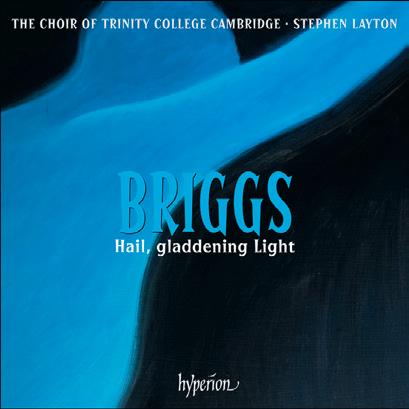
Briggs: Hail, Gladdening Light and other works
Choir of Trinity College, Cambridge, Stephen Layton (dir) Hyperion CDA68440 [61:47]
One of our most pre-eminent organists and of course, a master of the improviser’s art, one perhaps tends to forget that David Briggs (b. 1962) is also a highly accomplished composer, and this CD is a welcome reminder of his multi-faceted talents. Compositions dating back over the past twenty years are interspersed with four organ improvisations by Briggs, often based on the same plainsong melodies as the choir pieces. The latter are sung beautifully by the Choir of Trinity College, Cambridge conducted by Stephen Layton (like Briggs, a former organ scholar at King’s College).
Two services are included: the morning service written for St David’s in 2010 – a real firework display of virtuosity for both organ and choirand the recent (2020) Trinity College Fauxbourdon (evening) Service – a calm, unaccompanied setting in which plainsong verses alternate with more modern harmonies – sounding wonderful in the very resonant acoustic of Saint-Eustache in Paris. The organists for the choir pieces are two of our brightest young talents: Harrison Cole and Jonathan Lee who, remarkably, are by no means overshadowed in virtuosity by Briggs
himself, which is saying a lot.
If the scoring for the choir is occasionally rather more traditional in harmonic design – essentially tonal, but often with gentle, addednote discords - than the truly extraordinary harmonic explosions we get in the organ improvisations and accompaniments, this is only to be expected to ensure the singability of the vocal lines – indeed, some of the shorter pieces (God be in my head, for instance) seem well within the capabilities of more modest choirs than this ultra-professional ensemble. And occasionally, the choir seems to play second fiddle (as it were) to the organ – in Surrexit Dominus (2011), for instance – contributing the plainsong in unison, and ‘accompanying’ the brilliant organ part. However, these are very minor criticisms of an excellent disc.
Briggs gives us a dazzling, kaleidoscopic tour of the remarkable Saint-Eustache organ, built in 1989 by van den Heuvel. Indeed, his four utterly breathtaking improvisations, exploring a wealth of different colours and textures are worth the price of the CD alone, and it is hard to imagine another choir making a stronger case for the choral
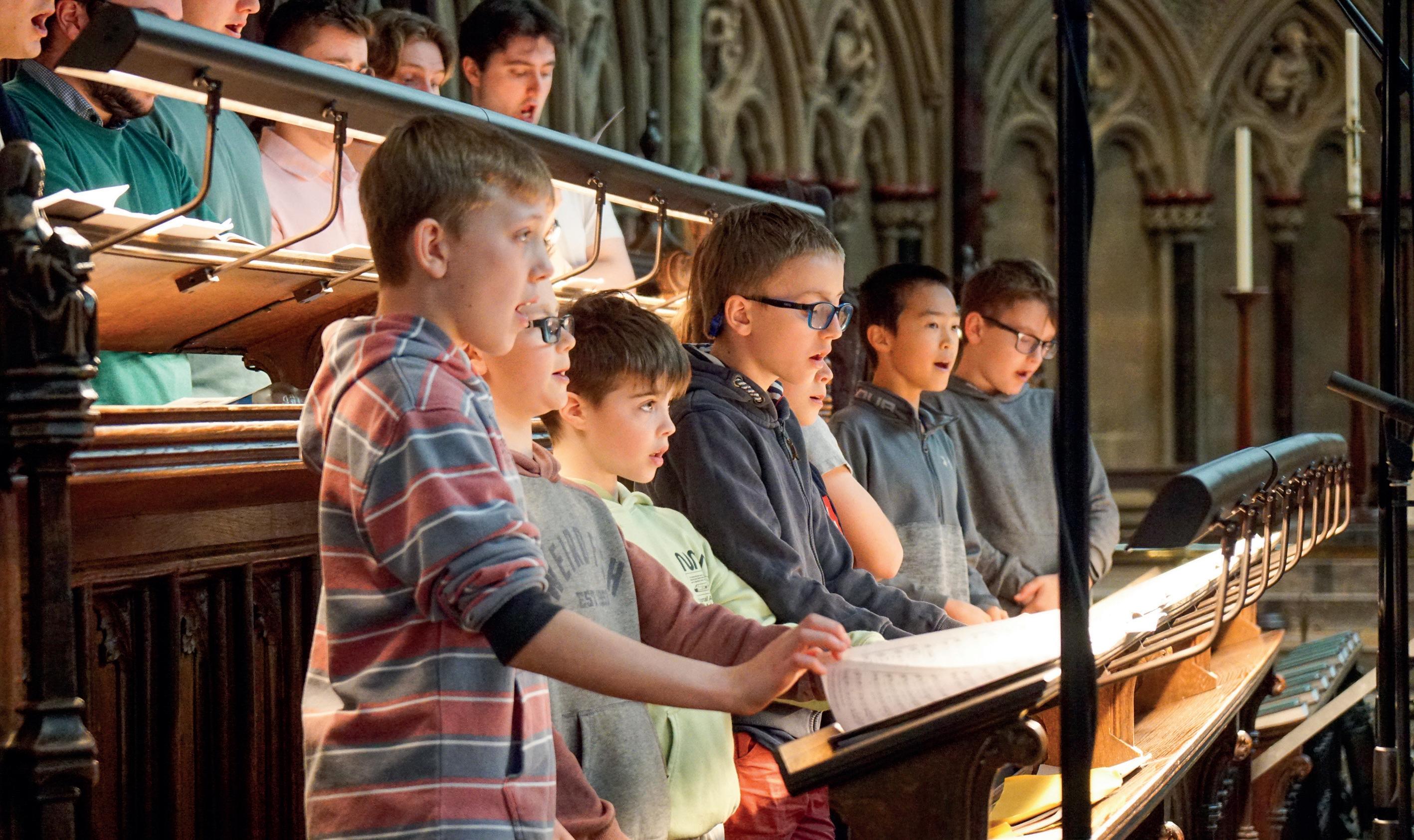
compositions than we hear on this excellent recording.
MARK BELLIS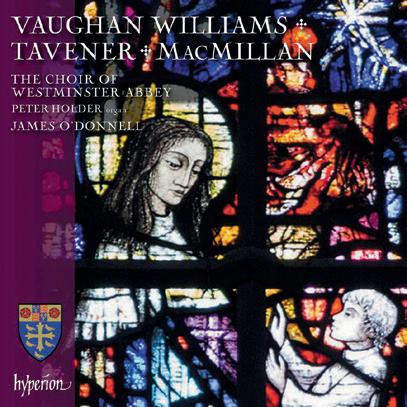
Vaughan Williams, Tavener, MacMillan
Choir of Westminster Abbey, Peter Holder (org), James O’Donnell (dir) Hyperion CDA68420 [72:17]
James O’Donnell, now a professor at Yale University, set the seal on his two decades as Organist and Master of the Choristers at Westminster Abbey with this final recording, made in 2022. It opens with the Vaughan Williams Mass in G minor, commissioned by R.R. Terry for Westminster Cathedral, where O’Donnell spent five years as assistant and twelve as Master of Music (though, as Jeremy Dibble’s notes explain, the Mass was actually premiered by the City of Birmingham Choir in 1922).
The treble sound is slightly more fragile in this piece than in the rest of the programme, but the ebb and flow of the music is exquisitely controlled; the solo quartet (which employs a mix of different singers for each movement) emerges seamlessly from the texture and back again. O taste and see provides an elegant transition to a sequence of pieces by James MacMillan, including his atmospheric Mass of St Edward the Confessor (whose shrine of course is in the Abbey), and the startlingly dramatic ‘mini sacred opera’ (MacMillan’s description)
A Special Appeal, setting words by Archbishop Óscar Romero of Salvador, who was assassinated while celebrating Mass in 1980, and from Psalm 31. Most of the music is a cappella, but in this remarkable piece organist Peter Holder really makes his presence felt – the pedal work is thrilling.
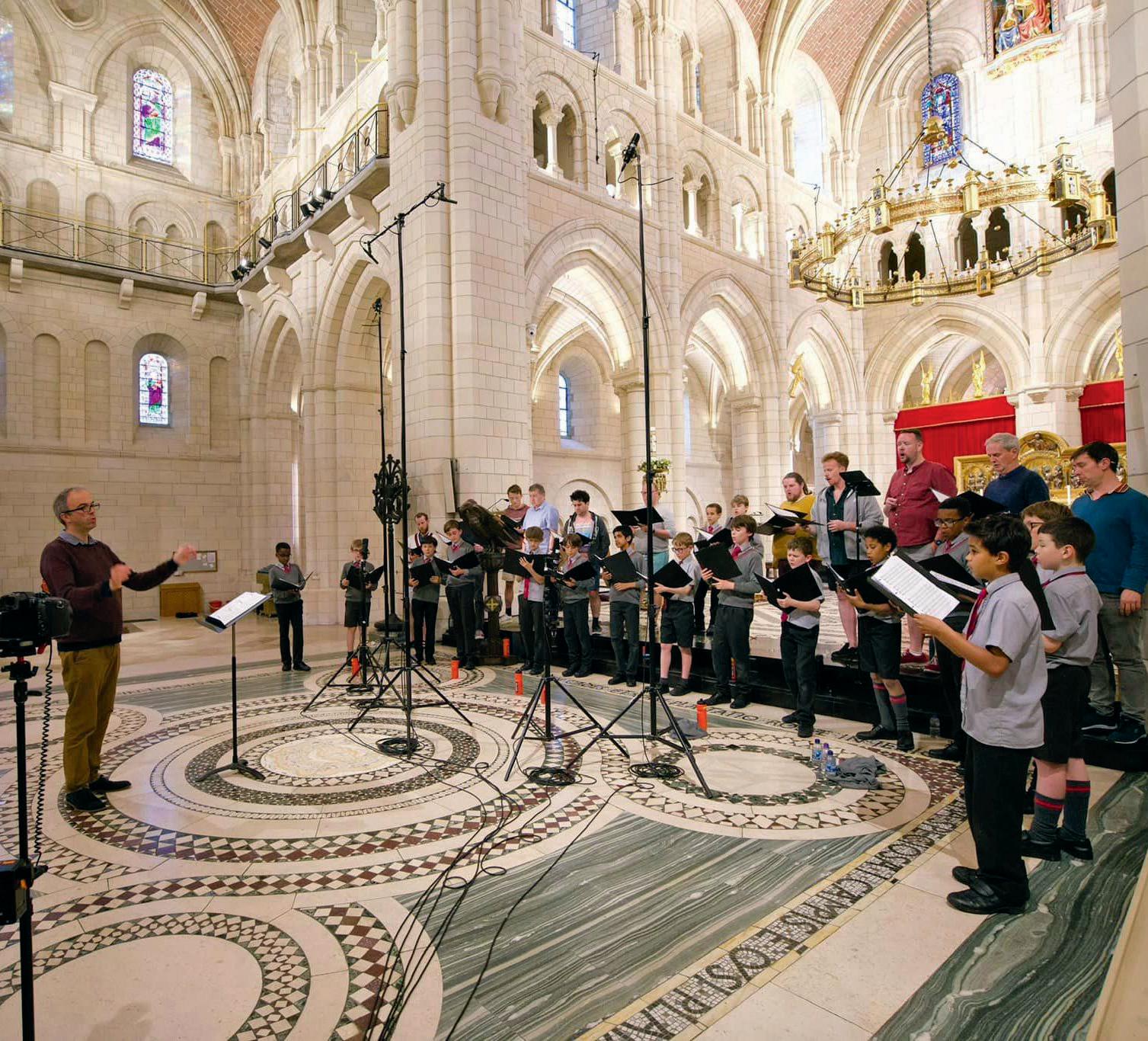
More conventional is MacMillan’s anthem Who shall separate us?, commissioned in 2011 in anticipation of the funeral of Queen Elizabeth II and so movingly sung at that service in October 2022. John Tavener is represented by a glorious performance of his ‘Collegium regale’ evening service and, closing this disc, Song for Athene, made famous at the funeral in the Abbey of Diana, Princess of Wales. I cannot imagine it better sung than it is here.
CLARE STEVENS*
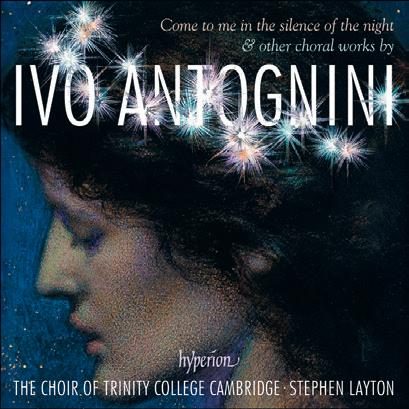
Hyperion CDA68425 [65:46]
Swiss composer Ivo Antognini, who turned sixty last year, studied jazz piano at Bern Jazz School and his choral compositions have become
popular both here and in the USA. The style is pleasant – tonal, with jazz-derived added notes, particularly at cadences. Much of the music here (all unaccompanied) is relatively slow and quiet, and this does lead to a certain ‘sameness’. There are sixteen tracks, many lasting less than about five minutes, so no really substantial works, and only a few – e.g. Canticum Novum (2020) and Jubilate Deo (2015) (the latter featuring an effective solo quartet) – generate some welcome rhythmic momentum. Even the lively setting of the Gloria (2018) soon relaxes into slower homophony. Harmonically, Lauridsen, Whitacre and perhaps Mealor come to mind, though often without their tonal inventiveness, with many pieces inhabiting the same key for long periods. An Emily Dickinson setting, Hope is the thing with feathers, does have some nice tonal contrasts.
Musically, the performances, by the Choir of Trinity College, Cambridge under Stephen Layton, are quite outstanding, with immaculate tuning, blend and diction – and what a rare delight to be able to hear the words so clearly! This is wholly secure singing, brilliantly
projected and featuring terrific soloists.
One really could not imagine a stronger case being made for the music than this disc.
MARK BELLIS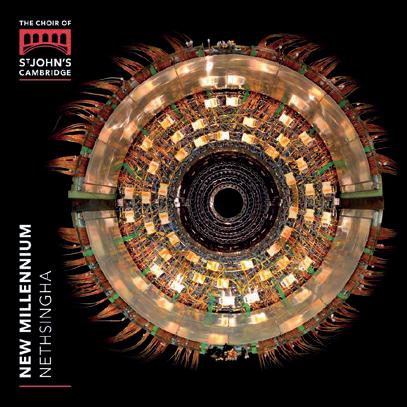
New Millennium Choir of St John’s College, Cambridge, Anna Ryan (fl), Sophie Westbrooke (rec), Alex Semple (vn), George Herbert (org), Andrew Nethsingha (dir)
Signum SIGCD750 [73:26]
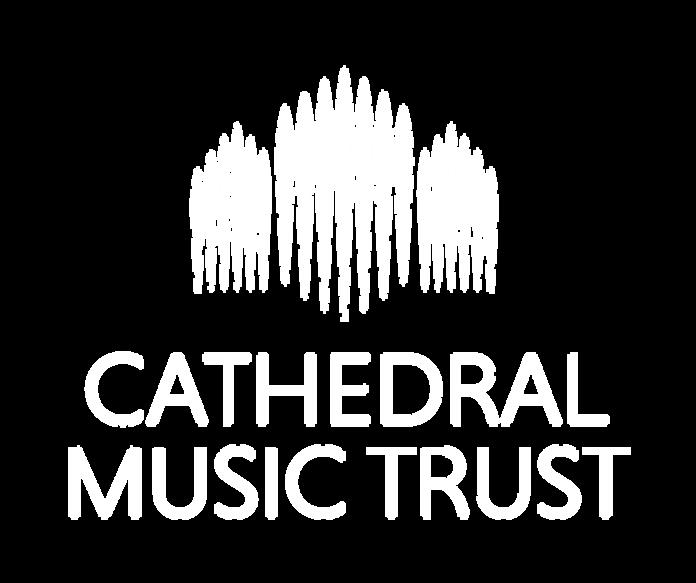
contemporary music during his fifteen years as Director of Music at St John’s College, Cambridge.
All the works are by living composers, from established names such as Judith Weir, James MacMillan and Cheryl Frances-Hoad to recent Cambridge graduates such as Ben Comeau, Anna Semple and Alexander Hopkins, a choral scholar at St John’s when his Salvator mundi, Domini was first performed.
Nethsingha says that generous sponsorship linked to the college’s annual Advent service and the invitation to be Choir & Organ’s inaugural New Music partners in 2010 were the main catalysts for a commissioning programme which has yielded rich fruit, including many of the pieces on this disc.
Recording sessions took place over two academic years with different cohorts of singers, including the choir’s first girl choristers, but the
Comeau’s haunting Vanity of vanities to Piers Connor Kennedy’s consoling O nata lux is particularly effective.
Abbie Betinis’s Cedit, Hyems (Be Gone, Winter!) for choir and flute magically describes the Advent progression from darkness to light, and David Nunn uses electronic sound generated from samples of water in his wonderful setting of Sicut cervus
George Herbert, winner of the Northern Ireland International Organ Competition 2023, skilfully negotiates the virtuosic complexities of some of the organ accompaniments, dazzles in two movements from Iain Farrington’s Fiesta! and contributes two further solo pieces, by Anna Semple and Francis Pott. The programme ends exuberantly with Farrington’s anthem Nova! Nova!, commissioned for Nethsingha’s last Advent service at St John’s. What a legacy he leaves!
Why not upgrade your support and join our Patrons? Secure a brighter future for the music you cherish.
Become a Patron online at bit.ly/cmt-patron

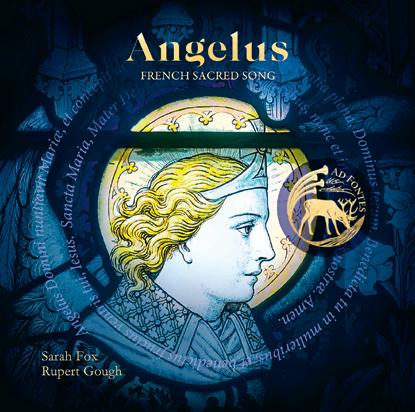
Angélus: French Sacred Song
Sarah Fox (sop), Cecily Beer (harp), Rupert Gough (org)
Ad Fontes ADF009 [69:57]
This is a lovely song recital by one of our most starry sopranos, Sarah Fox, accompanied on the organ by Rupert Gough – curator of this carefully chosen programme – and on five tracks, also by the harp of Cecily Beer. First come the three movements of Vierne’s wonderful Les Angélus, which move from gentle sunrise via the bright, scherzo-like excitement of noon to a reflective meditation on the evening bell. This is all a real treat, and one is immediately struck by not only the exquisitely projected vocal line but the convincingly authentic sound of the organ accompaniment. The recording venue is Buckfast Abbey and we have the absolute delight of their very extraordinary Ruffatti organ (2018) – the first in the UK –or rather two organs which can be played as one: the Italian-inspired Quire Organ and the Cavaillé-Collinspired Gallery Organ - the latter perfect for this repertoire, of course.
I was slightly underwhelmed by the other reasonably substantial work, the four movements of Speculum Vitae (Mirror of Life) –a rarity by Flor Peeters dating from 1935 – partly because of a rather clunky English translation (as opposed to the original Flemish) but again, the performance is top-notch, with beautifully shaped vocal lines and a wealth of exquisite, quiet organ registrations. On that point, it is perhaps slightly frustrating not to have a tour of this remarkable instrument’s louder and more quirky stops – it boasts both a Pontifical Trumpet (en chamade), an Abbatial Trumpet and a range of Italian special effects like a nightingale,
The Choir of
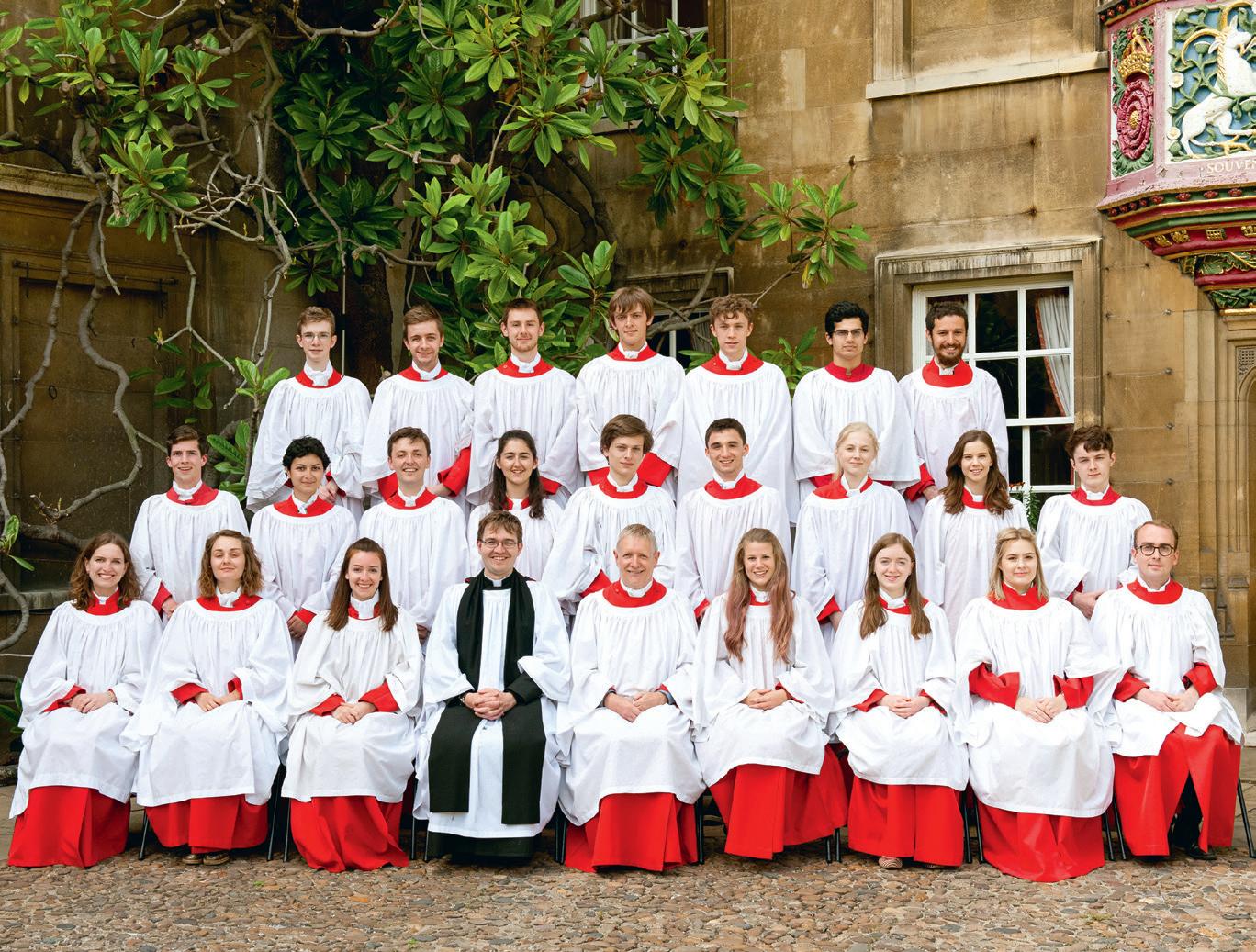
College,
drum and three bagpipes! – but one can’t have everything on a disc where most of the tracks are songs with organ accompaniment.
A few more popular items are included, for instance Franck’s Panis angelicus, and Messiaen’s O sacrum convivium: something of a surprise to hear a solo voice in both, rather than duetting voices in the case of the former, and instead of choir for the latter (though apparently sanctioned by the composer) but admittedly showing off the soloist’s beautifully sustained control over a very wide range. Other works include a touching Pie Jesu by Lili Boulangera very interesting work of painful chromaticism - dating from 1918, the year she died aged twenty-four, and dictated to her sister Nadia, who contributes a lovely setting of the Lux Aeterna in a conciliatory F major tonality. We also have a charming Christmas lullaby: Le sommeil de l’enfant Jésus by Henri Büsser, with organ and harp accompaniment, and a real ‘winner’ - much in the tradition of Adolphe Adam’s O Holy Night, and in the same key of E flat, come to think of it – which, if arranged for choir (perhaps someone has done this already?) would surely be a firm fixture at every carol service. Overall, a most carefully curated
programme, exceptionally well performed and recorded, in a very thankful acoustic for voice and organ. The only mystery is why Millet’s famous painting L’Angélus does not grace the cover, or indeed appear anywhere in the glossy sixty-page accompanying booklet - admittedly rather earlier than most of the music here, but it would certainly transport us to the right country immediately!
MARK BELLIS
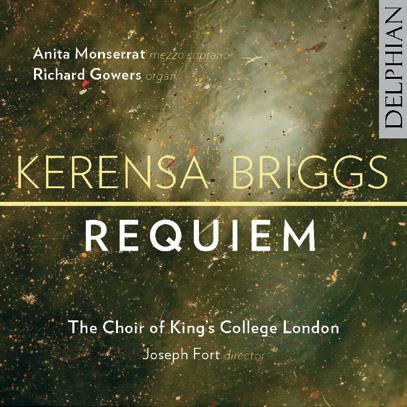
Kerensa Briggs: Requiem Anita Monserrat (m-sop), Choir of King’s College London, Richard Gowers (org), Joseph Fort (dir) Delphian DCD34298 [55:57]
The premiere of Kerensa Briggs’s quietly overwhelming Requiem was given by the threatened BBC Singers in November 2022 to mark the feast of All Souls. In this first recording of the work, the King’s College choir gives an equally strong and insightful performance. The elements of the
Requiem text are treated with unfussy reverence, as the work requires; the absence of vocal histrionics simply heightens the emotional impact. Joseph Fort keeps the singing tight and disciplined and a near-perfect recording means the mood is sustained to the very last. There are premiere recordings of some shorter Briggs pieces, which are welcome, but something of a distraction.
BRIAN MORTON*
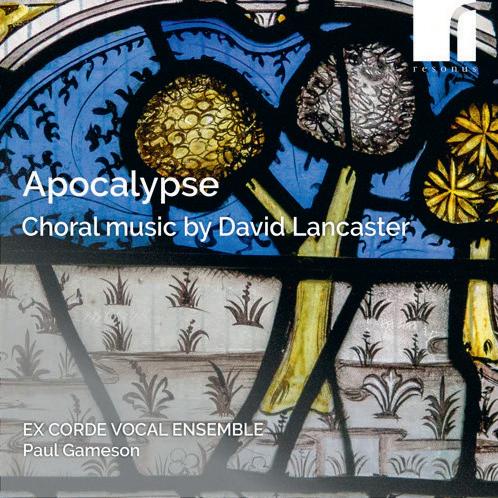
Apocalypse: Choral Music by David Lancaster
Ex Corde Vocal Ensemble, Paul Gameson (dir) Resonus Classics RES 10323 [71:09] I enjoyed this CD, with something of a York connection: composer David Lancaster (b. 1960) teaches at York St John University; many of the choir, Ex Corde, are York alumni; and the conductor is Paul Gameson, a Vicar Choral at York Minster.
We have only three, fairly substantial pieces, beginning with
the twenty-minute title track, Apocalypse, and there is a lot going on: ancient and modern versions of the text: Pricke of Conscience – based on a window in All Saints’ Church, York – multiple divisions, high soprano soloists, a fair amount of spoken text and choral speaking, together with some extended vocal techniques; in all, evidencing an unusual and distinctive compositional voice.
A setting of the Magnificat is similarly effective while the other long work (forty-four minutes) is the five movements of At the Edge of the World, inspired the fourteenthcentury anchoress Emma Raughton, who also lived at All Saints. Again we have a mélange of ancient texts (some in Latin) and modern ones, with hugely complex choral textures.
I found the music always interesting and engaging, and if there is relatively less focus on melodic or rhythmic invention, the really excellent feel for harmony and for kaleidoscopic, highly complex choral textures are both very convincing.
If I were the composer I would be absolutely thrilled with the quality of these performances: the small choir (not named individually but I counted only eleven of them in their group photo) bring huge commitment and musicality to every aspect of these interesting
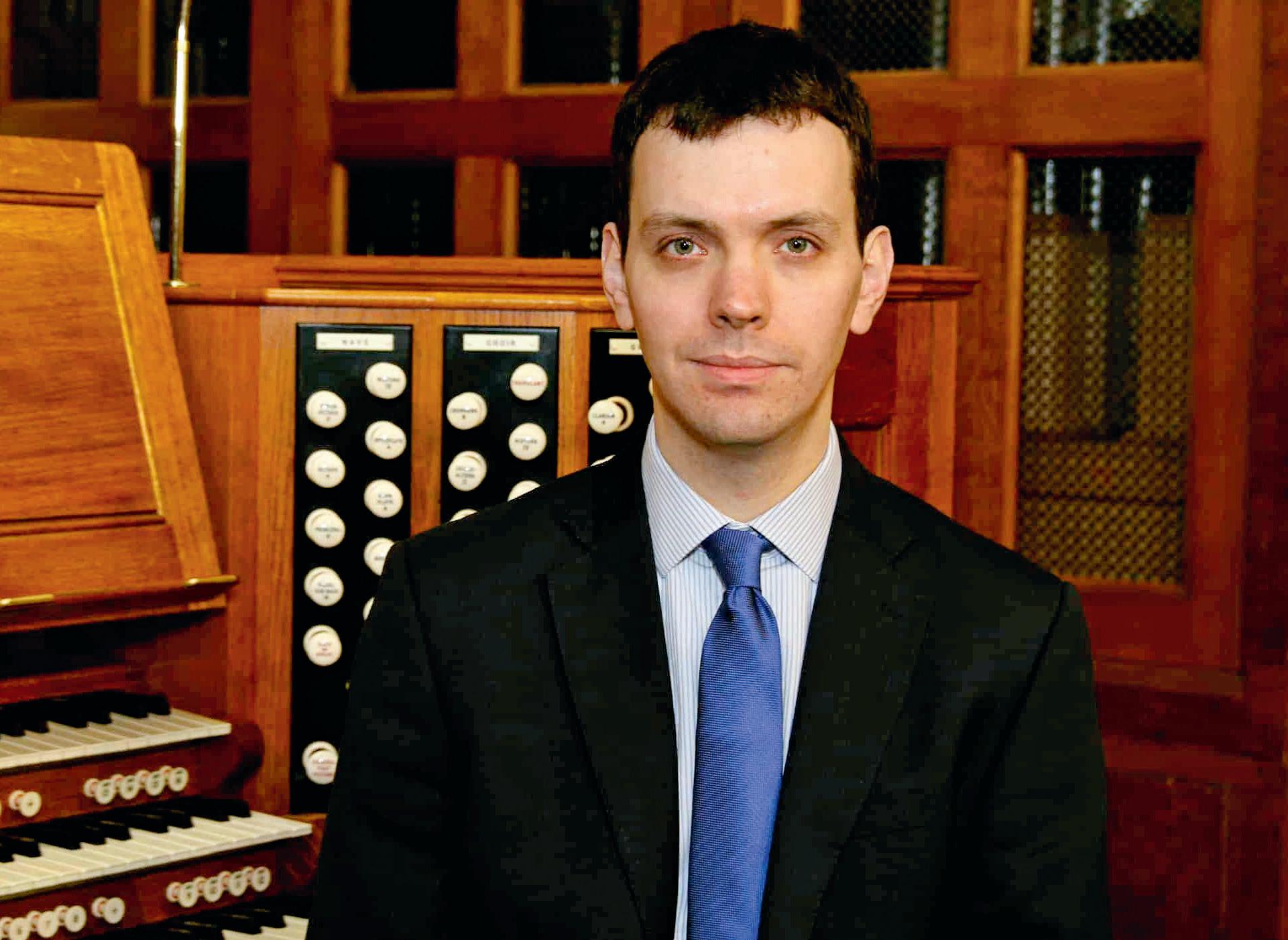
compositions – they are quite unfazed by multiple divisions, vocal clusters etc. – and a special mention to one of the soprano soloists, Anna Snow, for an outstanding contribution to this fascinating CD.
MARK BELLIS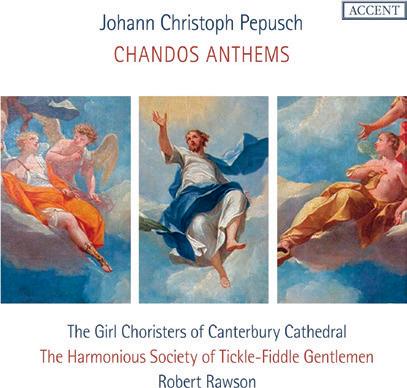
Pepusch: Chandos Anthems
Soloists, the Girl Choristers of Canterbury Cathedral, The Harmonious Society of Tickle-Fiddle Gentlemen, Robert Rawson (dir) Accent ACC 24397 [63:50]
This disc showcases some of the sacred music written by Johann Christoph Pepusch (1667–1752), one of the founding members of the original Academy of Ancient Music and a long-time rival of Handel; indeed, it’s good to be reminded that the younger man wasn’t the only composer active at Cannons, the country home of James Brydges, the first Duke of Chandos.
Robert Rawson and the Harmonious Society of TickleFiddlers have – along with the girl choristers of Canterbury Cathedral (directed by David Newsholme), who reinforce the sound for the choruses – gathered in similar numbers and forces to those that Pepusch had at his disposal at Cannons.
The disc is bookended by ‘Rejoyce in the Lord’ and ‘O praise the Lord’, both more akin to Handel or late Purcell than the grander Magnificat; also included is a short oboe concerto performed adroitly by Mark Baigent. The team of vocal soloists includes some of the UK’s leading young singers, who all perform with élan, and the instrumental forces conjure up dazzling displays of virtuosity, juxtaposed with enchanting lyricism. The vocal works all receive premiere recordings here, making this a vital addition to
FROM CONVIVIUM RECORDS: THE STUNNING NEW CHORAL ALBUM FROM BRITISH COMPOSER CLIVE OSGOOD








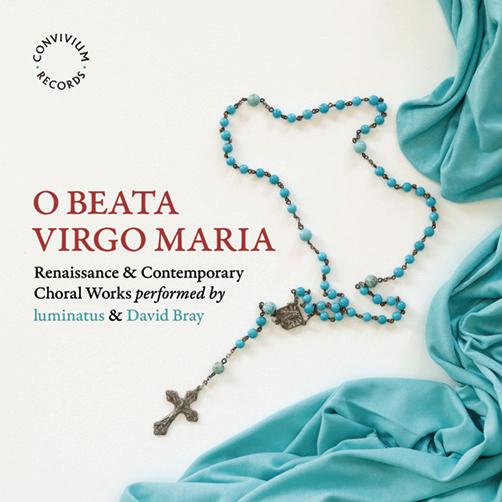
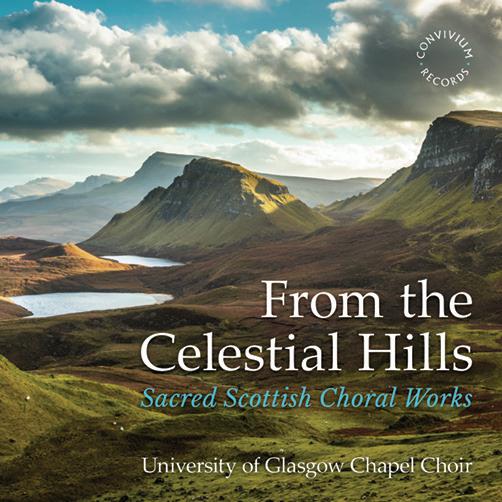
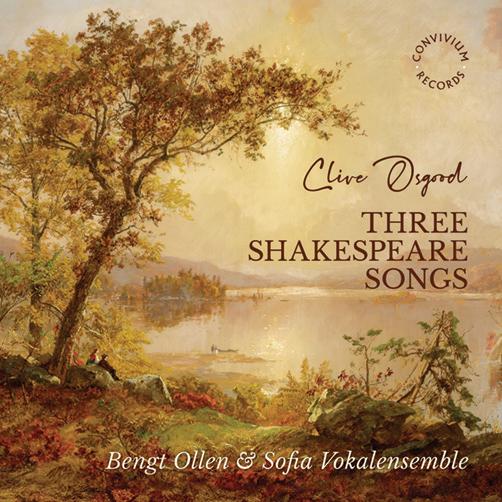
Discover previously unrecorded music by Renaissance composers Guerrero and Massaino alongside works by contemporary female composers, exquisitely sung by Luminatus

Distinctively Scottish, this collection of vibrant and rich choral music features sacred music from the repertoire of the University of Glasgow Chapel Choir
Imaginative, original and evocative, discover Clive Osgood’s a cappella settings of three songs from As You Like It, recorded by the accomplished Sofia Vokalensemble

NEW RELEASES FOR SPRING 2024 FROM CONVIVIUM RECORDS
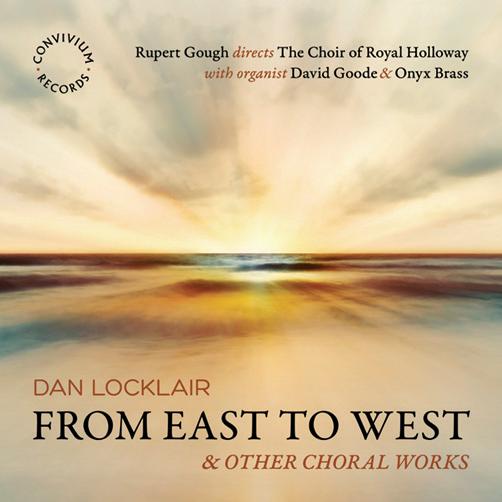
The precision and perfect blend of the Choir of Royal Holloway showcase the rich variety of American composer Dan Locklair’s sacred choral works in this wide-ranging album
DOWNLOAD AUDIO FILES OR PRE - ORDER YOUR CD WITH FREE SHIPPING AT WWW.CONVIVIUMRECORDS.CO.UK
This new large-scale setting of the Magnificat has been written as a companion piece to J.S. Bach’s famous setting (BWV 243). Although making use of a more contemporary musical language, it uses similar instrumentation, follows the same framework of chorus and solo movements, and makes use of a number of features that are typical of Bach’s music. AS HEARD ON:


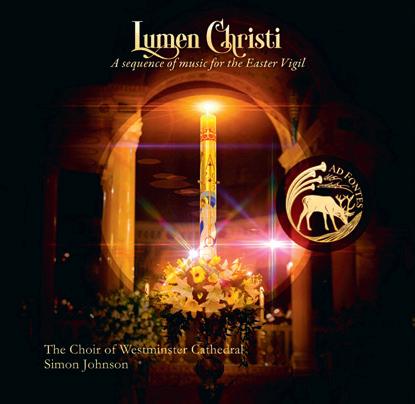
Lumen Christi: A Sequence of Music for the Easter Vigil
Westminster Cathedral Choir, Peter Stevens (org), Simon Johnson (dir)
Ad Fontes AF012 [71:24]
The Easter Vigil, which begins before midnight on Low Saturday, is the climax of Holy Week and therefore of the church’s year: beginning in near darkness and gradually growing
in luminescence and in grandeur as the story of Christ’s redeeming sacrifice is related, the service is intended to move and to inspire, and it is this emotional journey that Simon Johnson and the Choir of Westminster Cathedral have recreated here, beginning with the extraordinary text of the Exultet.
Two key threads are the Gregorian chant that forms the backbone of liturgy at the cathedral, and compositions by former musicians. Also prominent is Renaissance polyphony, a nod to the pioneering work of Sir Richard Runciman Terry, the cathedral’s first Master of Music. Successive directors of music have cultivated a distinctly
‘Continental’ feel to the sound of the choir, and this vocal heft and warmth – allied to outstanding blend and ensemble – make for a uniquely compelling sound (captured expertly by producer Adrian Peacock and recording engineer David Hinitt). Like a fine-tuned engine, the choir is superb throughout, from the polychromatic splendour of Andrew Reid’s Exodus Canticle or Martin Baker’s arrangement of O filii et filiae to the refinement of Palestrina and Victoria. Peter Stevens provides magnificent support on the organ and a thrilling account of Langlais’s Incantation pour un jour saint ADRIAN HORSEWOOD
Simon Johnson, Master of Music at Westminster Cathedral, discusses making his first recording with the choir
Although recording is often regarded as the pinnacle of music-making, it was far from the top of Simon Johnson’s list when he took over at Westminster Cathedral in September 2021. ‘It was a challenging time to start, right after Covid-19: the boys at the top of the choir effectively lost two years because of Covid, so although they were recruited
before I arrived, most of their experience has been with me and we’ve learnt a lot together.’
That said, spending several spring days recording Lumen Christi in the tranquility of Buckfast Abbey was a particularly valuable (‘and therapeutic’) experience for everyone. ‘The choir’s last recording had been of Holy Week music, also for Ad

Fontes, so the label suggested that we carry on with the church calendar; and we have plans for a recording of music for Pentecost.’
Johnson stresses the importance of Gregorian chant to the choir. ‘The boys learn plainchant from the moment they arrive as probationers; it’s such a valuable way of teaching children the basics of music – intervals, legato, phrasing, how to hit the centre of the pitch – and it’s at the core of all that we do.’
As at many other cathedrals, securing the long-term future of the choir is at the forefront of Johnson’s mind. ‘We’ve recently launched the Westminster Cathedral Choral Foundation, with the aim of raising enough to meet the choir’s running costs for the foreseeable future. We’re proud of the unique tradition here and of the opportunities we offer, and maintaining that is paramount.’
Pepusch’s discography.
ADRIAN HORSEWOOD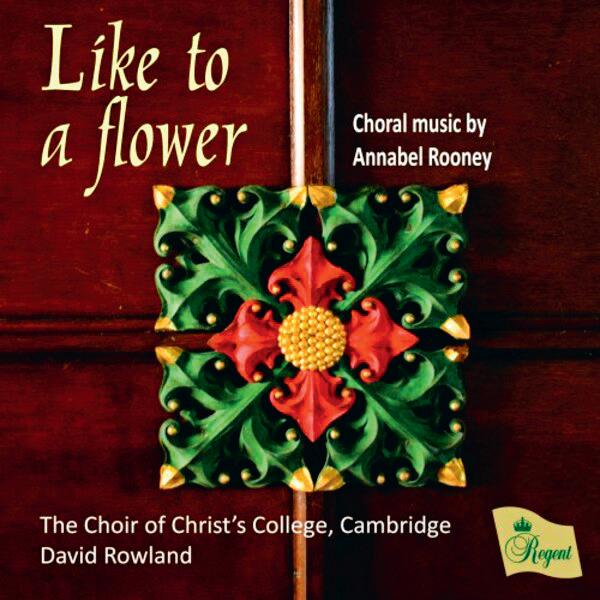
Like to a Flower: Choral Music by Annabel Rooney
Choir of Christ’s College, Cambridge, David Rowland (dir) Regent Records REGCD570 [70:41]
I must admit to being slightly underwhelmed by these compositions by Annabel Rooney, an alumna of Christ’s College, Cambridge, whose impressive choir we hear under the direction of David Rowland.
There are twenty-four short tracks – some very short indeed – the most extended works being a Magnificat and Nunc Dimittis in A minor (about seven minutes) and a Mass in C sharp minor for upper voices (only about nine minutes, all told). Of the five movements of the Mass, memorable are the flowing Kyrie, which seems to breathe the same air as that of the Vaughan Williams Mass in G minor, and the lively and effective Gloria – one of the very few quick tracks on the CD. Overall, this might be a welcome addition to cathedral music lists if a mass for divided upper voices were required.
The compositional style is rather traditional and tonal; perfectly pleasant, but by no means groundbreaking, with hints of Lauridsen and Bryan Kelly perhaps. Tracks such as Surrexit Christus work well – a piece which has something of the character of a Christmas carol, but is an Easter text, of course. The performances here are highly commendable and the Christ’s choir never give less than hugely committed and musical performances.
MARK BELLIS
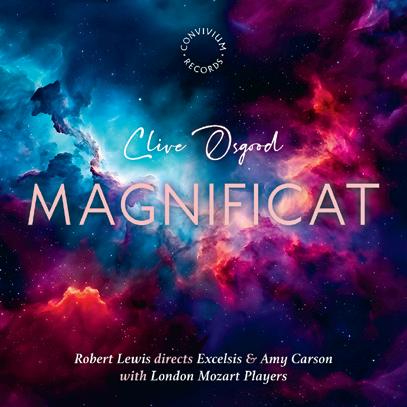
Clive Osgood: Magnificat
Amy Carson (sop), Excelsis, London Mozart Players, Robert Lewis (dir) Convivium Records CR093 [31:48]
This short disc contains just one work – the 2023 Magnificat, written as a companion piece to J.S. Bach’s setting and structured along similar lines into chorus and solo movements. Osgood follows Bach in using the tonus peregrinus in his work, albeit to a much greater extent than his Baroque forerunner, and in reacting to the overall moods that the words (in Latin, as with Bach’s version) suggest; otherwise there is a thrilling, irrepressible rhythmic drive to Osgood’s music, and he shows himself an accomplished composer for voices. The Excelsis choir –formed of some of London’s leading freelance professionals – dispatch Osgood’s virtuosity with panache while finding the requisite tenderness where called for; soprano soloist Amy Carson and the London
Mozart Players are on their usual excellent form, and Robert Lewis oversees proceedings with a clear sense of the bigger picture but without neglecting to bring out the many details in Osgood’s writing. ADRIAN HORSEWOOD
ORGAN CD s
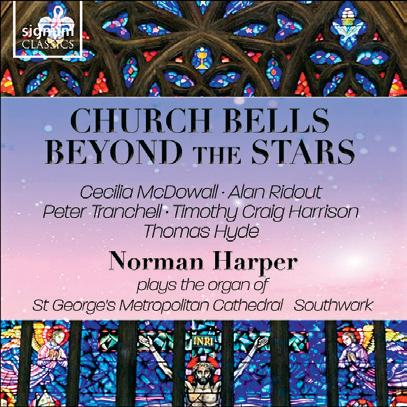
Church Bells Beyond the Stars: The Organ of St George’s Metropolitan Cathedral Southwark
Norman Harper (org)
Signum Classics SIGCD845 [67:12]
This collection of rare British organ music from the past sixty years or so is especially unusual because, of the featured composers, only Alan Ridout had no direct connection (as colleague or student) with the recitalist. Cecilia McDowall’s Church Bells Beyond the Stars is a
scintillating carillon of cascading notes and chords, part of her growing catalogue of organ works. Alan Ridout’s music deserves to be much better known. In his lifetime his organ and choral music was championed by Allan Wicks at Canterbury Cathedral who made several recordings. The Nativity Dances, still (amazingly) unpublished, are notable for irregular rhythms and concise articulation. Peter Tranchell, a Cambridge music academic and composer, wrote his very intense Organ Sonata in 1958 and I was intrigued by John Scott’s alleged remark, ‘Alban Berg meets Ivor Novello’, for it is a complex work leavened by occasional lighter moments. The two other suites share some similarities, based as they are on plainsong melodies. The opening and closing of Timothy Craig Harrison’s Christe qui lux es et dies reminded me of Jehan Alain, especially his beautiful Postlude pour L’Office de Complies. Thomas Hyde’s music produces some dramatic moments. The music is played on the 1958 three-manual Compton organ which is still giving excellent service and the generous five-second acoustic is well captured.
A most interesting recital, well played and recorded by Norman Harper, a former Director of Music at the Cathedral.
BRET JOHNSON
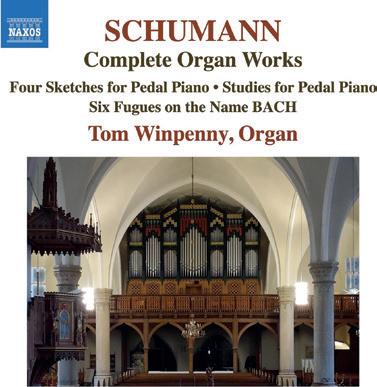
Robert Schumann: Complete Organ Works
Tom Winpenny, St Matthäi, Gronau, Germany
Naxos 8.574432 [63:20]
Schumann’s fascination for the works of Bach has, in turn, led to a fascination in Schumann’s contrapuntal writings by organists, with no shortage of fine recordings
to choose from. I find it curious that this poor cousin to Bach’s genius is so much in vogue – although they do make good technical exercises for any organist. Translating music conceived on the pedal piano raises many issues. Here, Tom Winpenny puts the listener at ease and the clear acoustics allow the counterpoint to speak for itself, helped by one of the best examples of German early Romantic organ building by Ph. Furtwängler & Sohn from Elze.
RUPERT GOUGH*
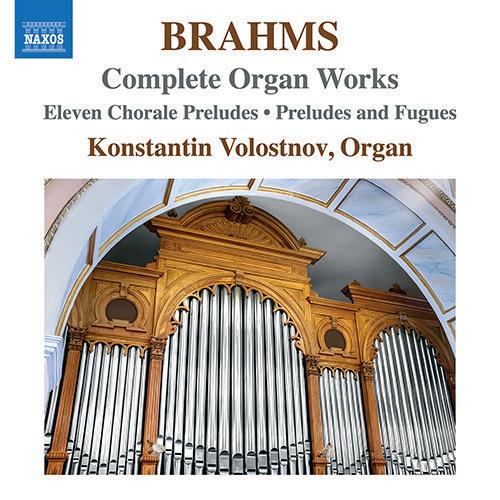
Brahms: Complete Organ Works
Konstantin Volostnov (org)
Naxos 8.579147 [66:38]
Rover organs were well known in Germany in the 1800s and early 1900s, mainly for their technical innovation and advanced design. Tonally they reflect the late romantic period and the thirty-eight-stop organ in the Moscow Central Church of Evangelical Christians-Baptists was the only foreign one built by the firm (which intriguingly was bought in 1878 as a family business from Emil Reubke, the younger brother of Julius Reubke of Sonata on the 94th Psalm). It is a good choice for Brahms, who turned to the organ infrequently during his life and largely as an outlet for his religious beliefs and deep love and empathy with the works of Bach and the Lutheran chorales which Bach’s music so frequently espouses. Brahms abandoned the idea of being a concert organist early, and his organ compositions assumed a personal nature, with examples early in life sent to his close friends Clara Schumann and Joseph Joachim. Much later he turned to the instrument to express feelings of loss and grief, especially in the Eleven
Chorale Preludes op. 122, which form the core of his output. These little pieces contain many familiar melodies from Bach, and they are not without dramatic elements. The often throaty and rich (and largely 8 foot) closely recorded Rover tone and fine playing make this release very enjoyable. The CD is also distinguished by excellent and very well researched sleeve notes.
BRET JOHNSON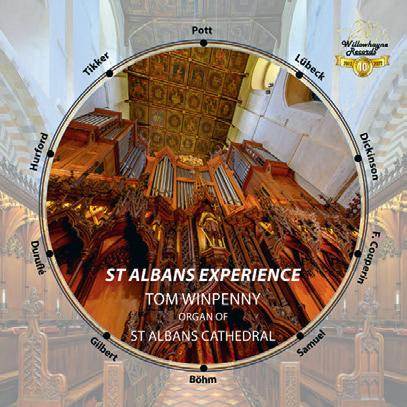
The St Albans Experience
Tom Winpenny on the organ of St Albans Cathedral Willowhayne Records WHR090 [79:00]
This latest release by Tom Winpenny showcases two composers who died in 2023. In addition to his work as a solo performer Peter Dickinson was a distinguished academic who played a significant role in raising awareness of American music in the UK. Three pieces from The Mass of the Apocalypse show a versatile stylistic range.
Anthony Gilbert also used different styles of change ringing as a basis for several keyboard works and Peal IV is a joyous wedding piece. Francis Pott’s superb postlude Laudes is a world premiere recording as is Rhian Samuel’s short suite Ad Lucem, another celebratory work, and also the two pieces by Peter Hurford including his Passingala. Hurford’s organ music is rarely heard and he was a skilful composer of several miniatures.
Amidst all of these contemporary pieces Tom Winpenny includes some older repertoire: Couperin, Vincent Lubeck and Georg Böhm from the Baroque era and the Prelude, Adagio et Choral varie sur le Veni Creator by Duruflé of which he gives a very fine account (I heard him play this live in the Abbey a few years ago).
Although the recorded sound is occasionally a little remote and even monaural (maybe the microphones needed more intrusive placement?), this is a very satisfying CD which introduces new and exciting repertoire, and is another fine example of this splendid organ which was largely designed by Peter Hurford. Tom Winpenny, as usual, is on top form throughout.
BRET JOHNSON
Johann Sebastian Bach: Organ Transcriptions
Wolfgang Rübsam, Casavant organ (1998), St Louis, King of France, St Paul, Minnesota
Brilliant Classics 96846 [70’47]
Wolfgang Rübsam is one of the most distinctive Bach interpreters to emerge over the last 50 years or so. His Philips complete Bach cycle, recorded in the 1970s, was quicksilver and, for its time, excellent if perhaps unremarkable. His later Naxos recordings, largely made on landmark historically oriented organs in the USA, were from a different planet; the broad tempi, trademark delayed downbeat and rhetorical whimsy dividing the crowd. This new release of ‘transcriptions’ (are they really written down as such?) of the second and third orchestral suites, as well as the D minor Chaconne, will prompt similarly ‘Marmite’ reactions. Most striking is the sense of late-Romantic expressive grandeur (amplified by the mid-twentieth-century tempi) delivered despite the (mostly) conventional registrations, and articulation which is far from universally legato (indeed it occasionally swings too far the other way). There’s something slightly grotesque about the experience … and yet, one realises that every note,
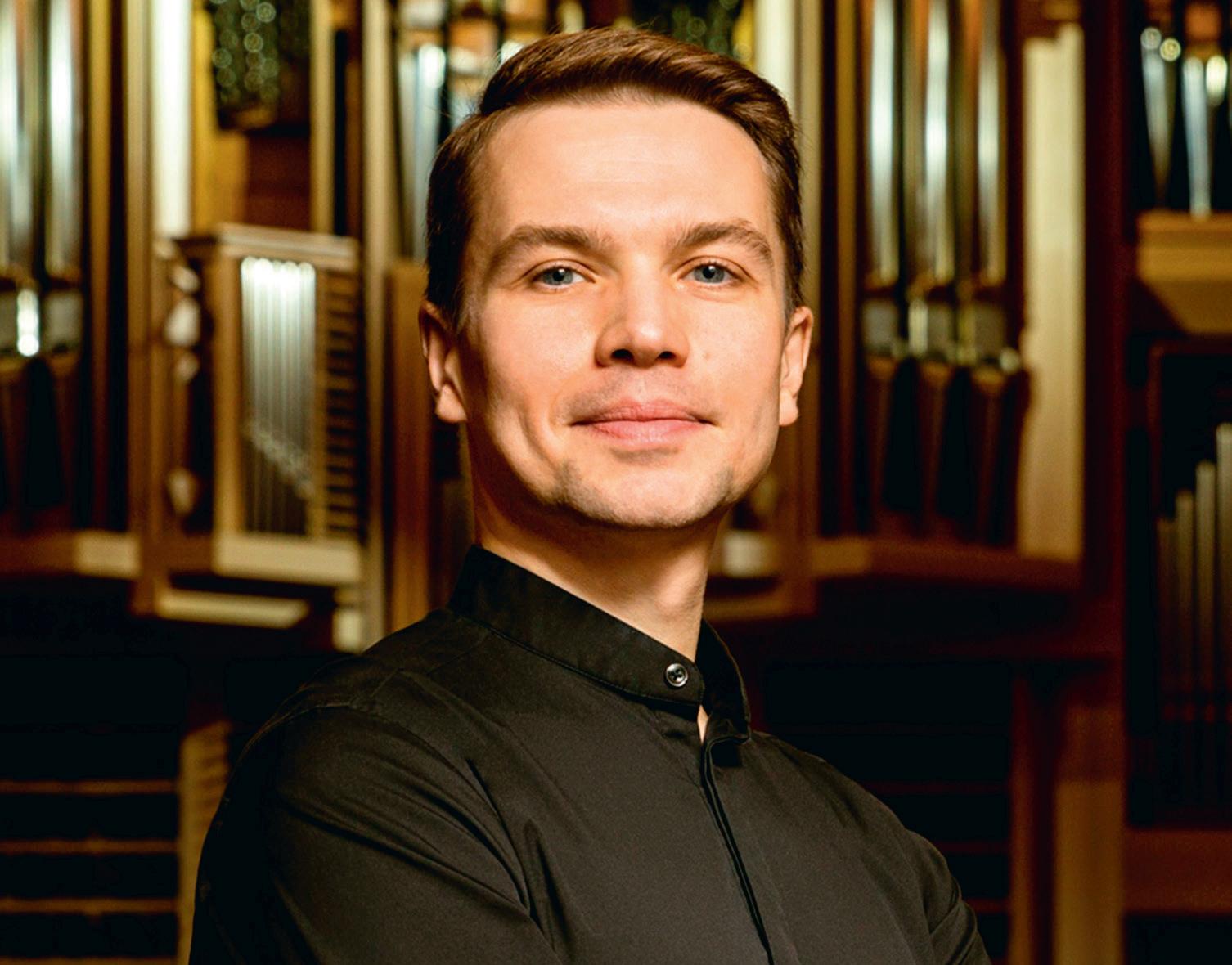
every rhythmic delay, every extended up-beat, every spread chord is planned with astonishing detail. Not a single moment is left to chance. One is likewise aware of Rübsam’s early studies with Helmut Walcha, so linearly conceived is the contrapuntal expression. This won’t be many people’s cup of tea, but I find it hard to deny that there’s a genius at work.
CHRIS BRAGG*
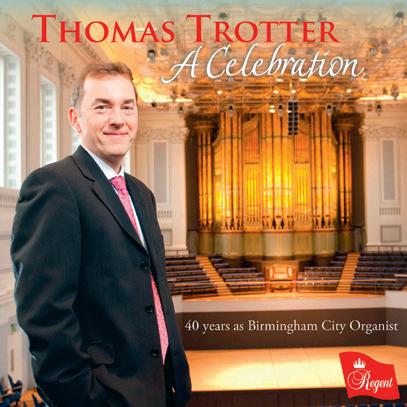
Thomas Trotter: A Celebration
Thomas Trotter on the organ of Birmingham City Hall Regent Records REGCD584 [77:34]
The ‘Celebration’ marks Thomas Trotter’s fortieth anniversary as City Organist of Birmingham, having succeeded Sir George Thalben-Ball in 1983. The music is indeed celebratory in nature but includes two major works for the English romantic organ, Hubert Parry’s Fantasia and Fugue in G and Healey Willan’s Introduction, Passacaglia and
Fugue. The latter was composed shortly after Max Reger’s death in 1916 and not long after Willan had emigrated to Canada, and is a piece of towering majesty; this recording, along with that of Francis Jackson at York Minster in the 1960s, will endure in the mind in the years to come. The Birmingham instrument is ideally suited to these two works.
The rest of the disc includes some of Trotter’s transcriptions including the whole of ‘Jupiter’ from The Planets: an extraordinary achievement for one player to give such a full account of the density and richness of orchestration. Eric Coates’s Knightsbridge March, like most of his marches, works well for the organ. Another complex transcription, this time by W. T. Best of Mendelssohn’s overture to St Paul, is an extended and dramatic fantasia on the chorale ‘Sleepers Wake’ … well they certainly will on hearing this!
Sigfrid Karg-Elert’s music is often impressionistic and sometimes sentimental, like the little interlude Valse Mignon. Trotter concludes with the impressive Étude Symphonique by the gifted Canadian organist Rachel Laurin who died in 2023. This varied programme is yet another example of the breadth of talent and skill of this fine artist.
BRET JOHNSON
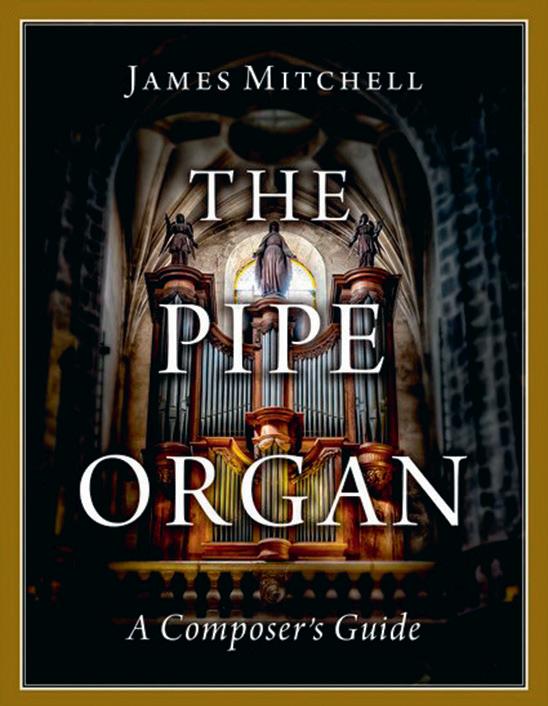
James Mitchell
Oxford University Press
ISBN 978-0-197-64529-1
Paperback; 208 pages. RRP £25.99
James Mitchell’s The Pipe Organ: A Composer’s Guide comprehensively explains the many different challenges of writing for organ in a clear and engaging way that will be of use to both those who have no experience of the instrument and knowledgeable organists. With few practical organ composition guides having been published before and orchestration guides traditionally only lightly touching on the subject, this guide fills the gap brilliantly. The book not only explains the practicalities of writing for manuals and pedals and how to write idiomatically, but also explores organ registration and notation. Helpful advice is also offered on how to get organ music performed, things to consider when commissioned to write for specific instruments, and how to access an organ.
The guide can be read from front to back, although it is possible to read individual chapters as required as there is clear sign-posting to other related sections when it may be useful. Mitchell’s writing style is clear and highly engaging, which makes for easy and enjoyable reading. He explains his points succinctly, often pointing out
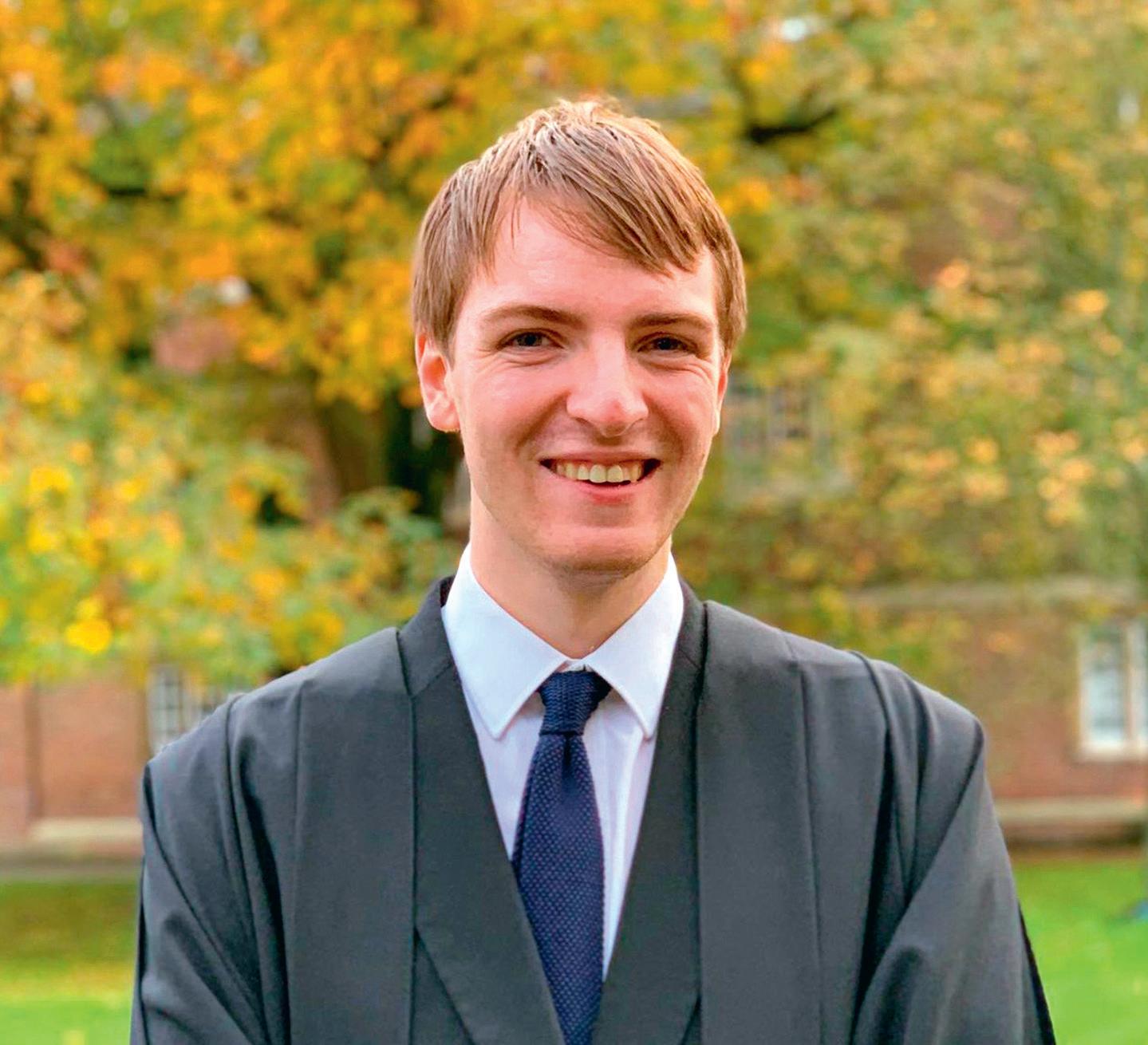
common mistakes and how to avoid them. He also makes sure to emphasise the importance of collaboration with organists and score study when composing. Musical examples are used throughout; the range of examples used is excellent and covers a wide array of composers. Unfortunately, the accompanying images provided to demonstrate points are quite dark and I found the details hard to make out.
The book has an accompanying website which includes printable summaries of each chapter, various organ specifications and, crucially, video demonstrations to go alongside most chapters. These videos include demonstrations of different kinds of instruments, stops, and playing techniques to name a few, all of which are vital to illustrate the different composition possibilities for the reader. Additional website content is indicated by a play button in the
book margin. However, I found it difficult to navigate to the right link on the website, due to there being no reference number to go by in the book or descriptive titles for the videos. This is something I am sure could be rectified with a few updates.
The majority of the book focuses on solo playing; however, there are dedicated chapters to other types of organs (including the chamber organ, harmonium, theatre organ and Hammond organ) and writing for organ and ensemble including choirs. Both chapters are highly informative and encourage composers to think creatively – I particularly enjoyed learning about the Indian harmonium!
I recommend this guide unreservedly to anyone who is interested in composing for the organ. I have no doubt that it will become an invaluable resource.
IMOGEN MORGAN
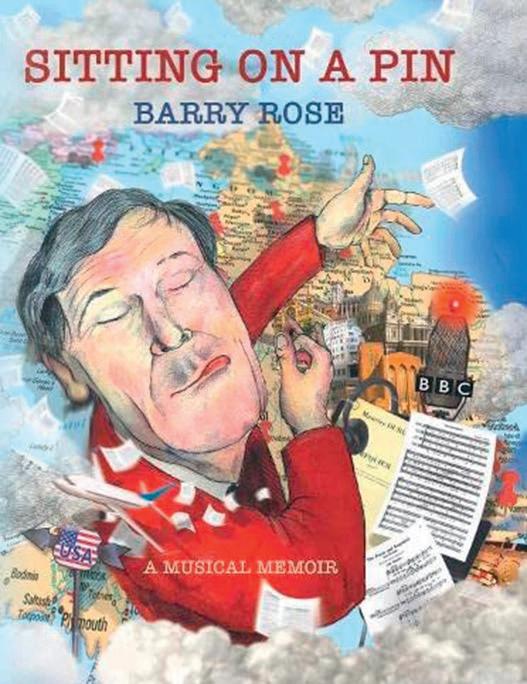
York Publishing Services
ISBN 978-1-399-90667-8
Hardback; 312 pages. RRP £18.95
One of the UK’s choir trainers par excellence, Dr Barry Rose OBE made his name when in 1960, aged just twenty-five, he was appointed Organist and Master of the Choristers of the new cathedral in Guildford, becoming the youngest ever holder of such a post in the UK; he had not yet even completed his studies at the Royal Academy of Music when he was successfully auditioned for the position.
Rose was approached by the BBC to succeed Sir George Thalben-Ball as its Religious Music Adviser in 1971, a position which he was to hold until 1990; as well as producing the weekly
programmes of Choral Evensong, he was also responsible for the provision of music for the Daily Service, and so can legimately lay claim to being the most broadcast church musician in the country.
In 1974 Rose moved to become Sub-Organist of St Paul’s Cathedral (while maintaining his position at Guildford), then as Master of the Choir from 1977, in which position he directed the music at the wedding in 1981 of Charles, Prince of Wales and Lady Diana Spencer.
Following an unsavoury dispute with the Chapter of St Paul’s (in which he was clearly the injured party), he took up a position at the King’s School, Canterbury in 1984, before being lured to St Albans Cathedral in 1988 for what would be his final permanent director of music position; he retired from St Albans in 1997, and has ever since devoted his time to directing, writing, examining and broadcasting all over the world.
Such is the skeleton of Rose’s life, but what sets Sitting on a Pin apart from most other autobiographies is the incredible attention to detail and accompanying photos and other images; it seems that he possesses both a crystal-clear memory and an extensive archive of printed and recorded material relating to his career, and the book is infinitely richer and more compelling for it.
One aspect that might surprise some, given his indisputable success and skill in the matter, is the paucity of information regarding Rose’s techniques for training voices (particularly those of younger singers). While he touches on the subject when discussing some of his earliest forays into the world of choral conducting (particularly with regard to his time at Guildford, when he had to build up a choir almost entirely from scratch by trawling the town and its surroundings for potential choristers), I would personally have enjoyed and learnt a great deal from some insights into his approach and how it might have developed over time – especially as he still maintains a busy career even this far into his post-permanent employment phase (in his book he scorns to use the word ‘retirement’!), and so clearly has lost neither the knack nor his enthusiasm for working with choirs.
But this is not to detract from what is a most entertaining read, one that also provides a vivid and illuminating picture of how the world of church and cathedral music changed after the Second World War. Choirs and organists across the UK and further afield owe a great deal to Barry Rose and his dedication to his craft.
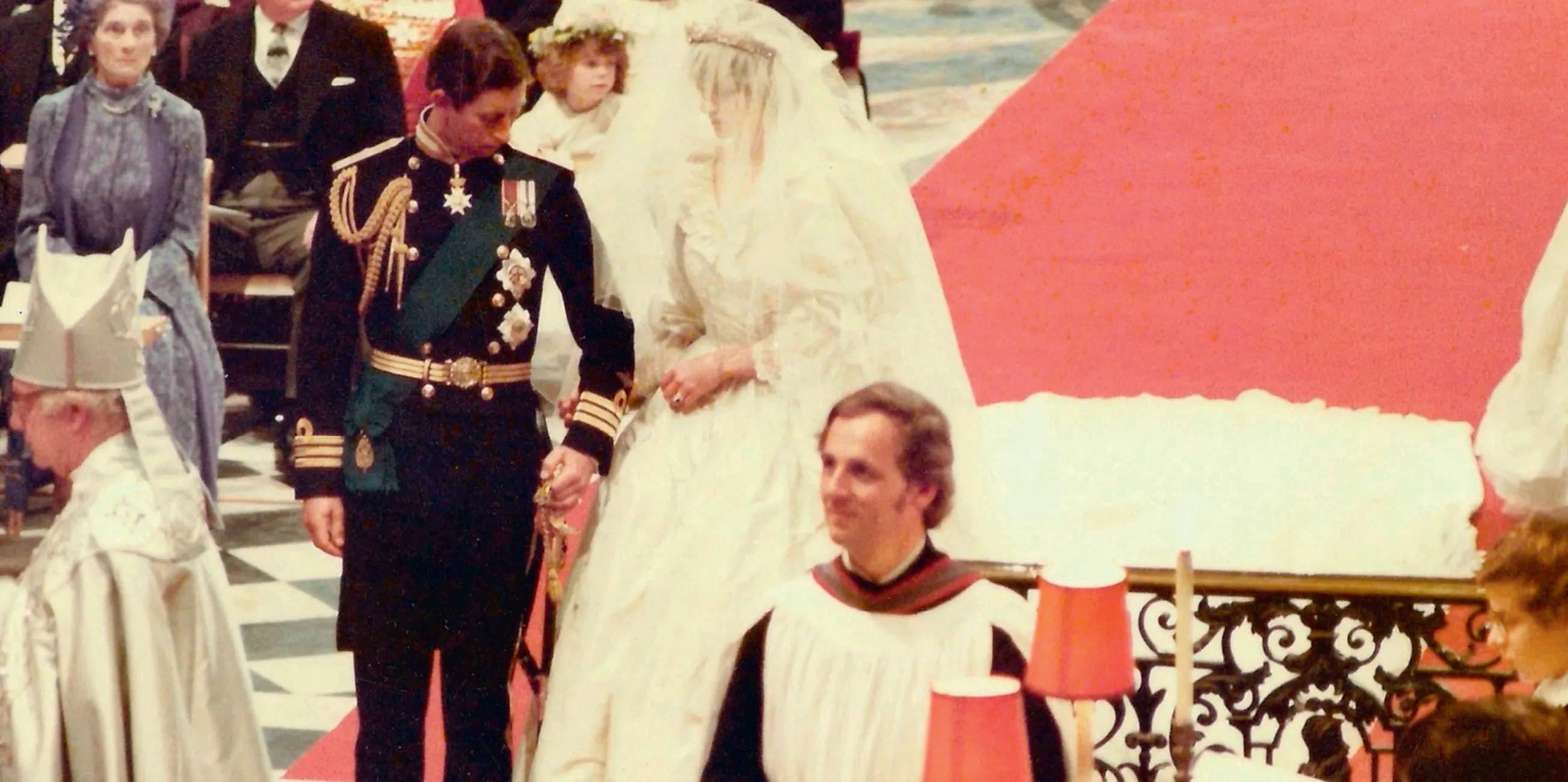
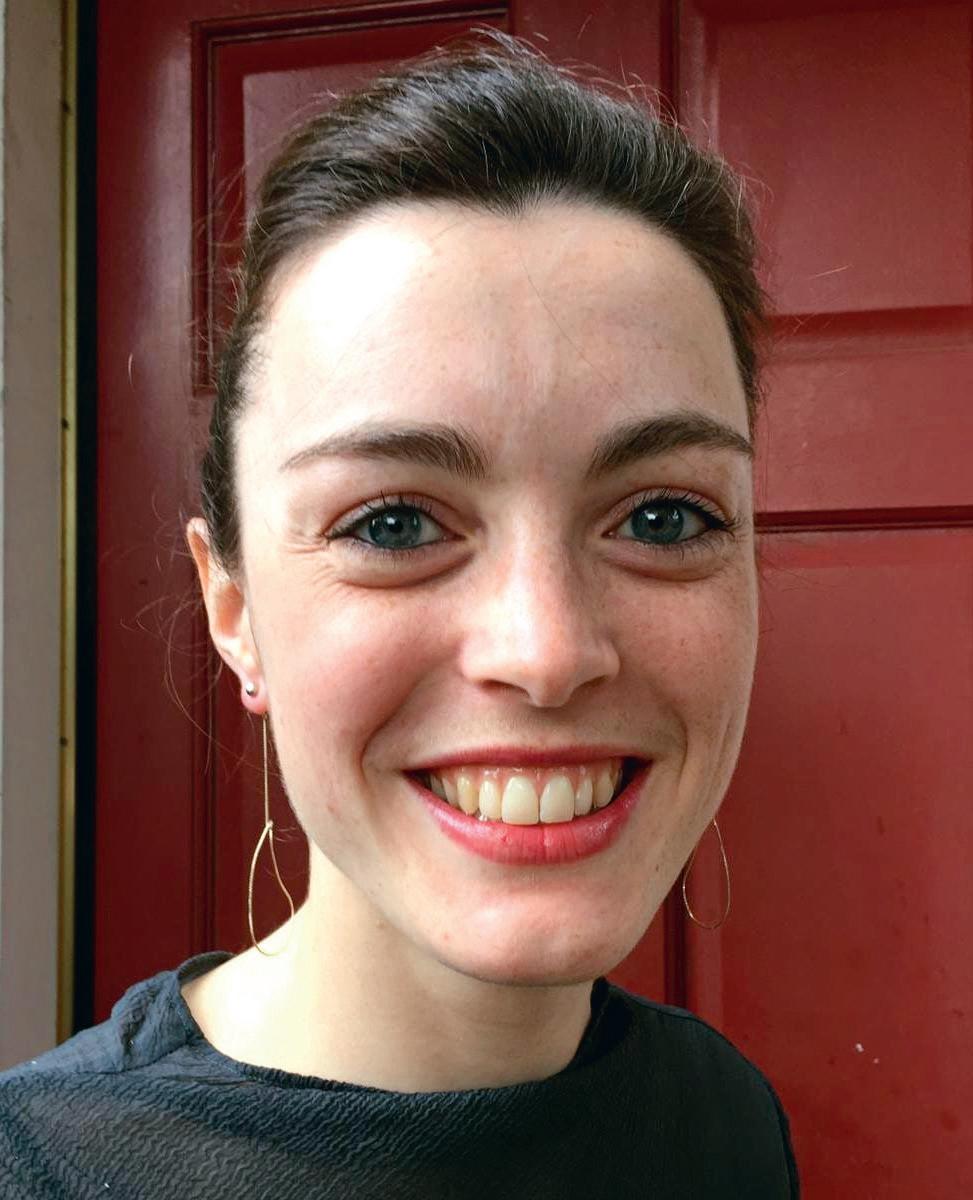
What is your earliest memory of performing in church?
I went to church as a child and remember singing hymns in the congregation. I also remember being very shy and not wanting to sing too loudly - how times have changed! I played piano from a young age, and remember really wanting to be good enough to be able to play a hymn. Now I spend my life playing hymns.
Is there a cathedral or church that’s especially close to your heart?
I love the community here in Leeds, so Leeds Cathedral is somewhere close to my heart. I also loved my time at St Paul’s, West Hackney, who welcomed me with open arms when I lived in London.
Figures indicate that the number of churchgoers in the UK has been slowly, but steadily, declining for decades, yet cathedrals report
ELIZABETH LEATHER‘ The team endeavour of a choir coming together to make beautiful music, in awe-inspiring surroundings, is something that brings people closer to God’Interview by ADRIAN HORSEWOOD
ever-growing congregations for choral services, particularly Evensong. What do you think this says about the role of music in cathedral worship today?
That’s so exciting! Music is a huge draw for churchgoers; the team endeavour of a choir coming together to make beautiful music, in awe-inspiring surroundings, is something that brings people closer to God. In practical terms, choirs are made up of people, often young people with families who will come and support them in their musicmaking. Music, faith and community are interlinked.
What do you think is the most important part of your role as one of Cathedral Music Trust’s Future Leaders?
It has to be growing the community of young people who share our passion for choral and organ music. In October the Future Leaders Group
‘ The most important part of my role as a Future Leader has to be growing the community of young people who share our passion for choral and organ music’
held our first ‘Big Alumni Evensong’ at St Andrew’s, Holborn. We were lucky to have Anna Lapwood directing, and Tim Popple running a ‘Quires and Places’ pop-up; the event attracted a large number of young singers who were encountering Cathedral Music Trust for the first time.
If you were introducing a newcomer to the world of cathedral music, what piece of music do you think would get them hooked for life?
Lotti’s Crucifixus and Allegri’s Miserere both thrilled me when I sang them for the first time, and I always love the music I’m doing right now; today I’m delighted by Couperin’s Christo resurgenti, which I’m teaching to the Leeds Cathedral Junior Choirs ahead of Easter Day.
Elizabeth Leather is a Choral Director with the award-winning Diocese of Leeds Music, where she directs three of the Leeds Cathedral Choirs and teaches singing to hundreds of children each week in schools across Leeds. Conducting the Cathedral Choirs, Elizabeth has featured on BBC Songs of Praise and BBC Radio 3.

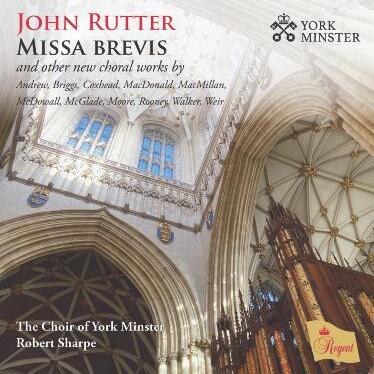

and other new choral works by living composers
The
REGCD576
This latest disc from the acclaimed choir of York Minster has at its heart the new Missa Brevis written by John Rutter for the memorial ser vice of Richard Shepherd, a composer with a long association with York and its Minster This appears alongside new choral works by Kerr y Andrew, Kerensa Briggs, Elizabeth and Thomas Coxhead, Sarah MacDonald, James MacMillan, Cecilia McDowall, Becky McGlade, Philip Moore , Annabel Rooney, Lucy Walker, and Judith Weir
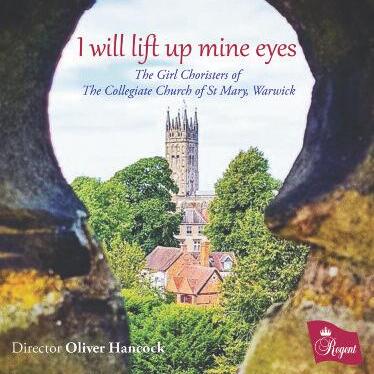

The Girl Choristers of the Collegiate Church of St Mary, Warwick, directed by Oliver Hancock
REGCD583
The St Mar y ’ s Girls’ Choir was founded in 1990 by the then Director of Music , Simon Lole The Girls sing Evensong at St Mar y ’ s on Wednesdays during term time and join the Boys and Men for occasional ser vices and concer ts Now well established, the Girls’ Choir has broadcast on BBC Radio and TV and has featured on a number of CDs Here they offer an appealing selection of works for upper voices by Peter Hurford, Simon Lole , Charles H H Parr y, Paul Br yan, Colin Mawby, Felix Mendelssohn, Richard Dering, Giovanni Battista Pergolesi, Sarah MacDonald, Mark Blatchly, Hildegard of Bingen, Maurice Greene , Johnny Dankwor th, Charles Villiers Stanford, Paul Edwards, John Ireland, George Dyson, and Malcolm Archer.
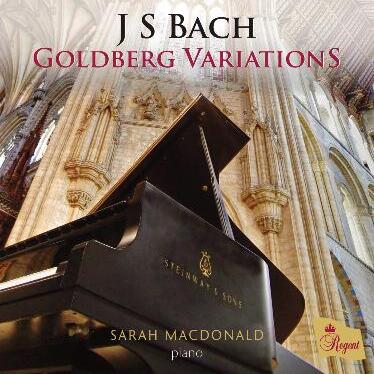

Sarah MacDonald (piano)
REGCD568
This first solo piano recording by the multi-faceted Sarah MacDonald is the product of her Covid-motivated project to learn, perform and record this iconic work, one of the pinnacles of the solo keyboard reper toire . The recording is accompanied by her written notes on each variation in the form of diarised entries, following her personal journey through the musical, medical, professional, and social challenges posed by the pandemic. The entries are personal, self-effacing, and laced with a healthy dose of humour, illustrated with examples of her talent as a keen amateur photographer The recording was made in the radiant acoustic of Ely Cathedral
Sarah MacDonald is a Canadian-born conductor, organist, pianist and composer, and holds the positions of Fellow and Director of Music at Selwyn College , Cambridge, and Director of Ely Cathedral’s Girl Choristers
REGENT RECORDS, PO Box 528,Wolverhampton, WV3 9YW 01902 424377 www regentrecords com (with secure online ordering)
Retail distribution by RSK Entertainment Ltd, Tel: 01488 608900, info@rskentertainment co uk Available in the USA from the Organ Historical Society www ohscatalog org Scan QR code to sign up to our mailing list
Sarum College, Salisbury Thu 19 – Fri 20 Sept 2024
This two-day conference will include papers given by current cathedral music researchers, keynote speeches by leading authorities in the field, presentations, an author talk, and an after-dinner speech by John Rutter CBE.
Booking opens 3 May
Find out more at bit.ly/cmngp


For more than 50 years the Prayer Book Society has been working to keep the Book of Common Prayer at the heart of the worshipping life of the Church of England.
New generations are discovering the beauty, depth and majesty of the BCP, many through Cathedral services.
In addition to promoting Prayer Book services across the country, the Society runs many national and local events.
Join us and help keep this wonderful tradition thriving in our churches.

